Forums
- Forums
- Axis And Allies Forum
- General Discussion
- Aviation News
Aviation News
Post a reply
- Go to Next topic
- Go to Welcome
- Go to Introduce Yourself
- Go to General Discussion
- Go to Screenshots, Images and Videos
- Go to Off topic
- Go to Works in Progress
- Go to Skinning Tips / Tutorials
- Go to Skin Requests
- Go to IJAAF Library
- Go to Luftwaffe Library
- Go to RAF Library
- Go to USAAF / USN Library
- Go to Misc Library
- Go to The Ops Room
- Go to Made in Germany
- Go to Campaigns and Missions
- Go to Works in Progress
- Go to Juri's Air-Raid Shelter
- Go to Campaigns and Missions
- Go to Works in Progress
- Go to Skinpacks
- Go to External Projects Discussion
- Go to Books & Resources
-
 Main AdminOFFUTT AIR FORCE BASE, Neb. (AFNS) -- The 55th Wing marked another historic milestone when a Royal Air Force RC-135 Airseeker aircraft diverted to Offutt Air Force Base after experiencing landing gear problems during a joint exercise at Nellis AFB, Nevada.
Main AdminOFFUTT AIR FORCE BASE, Neb. (AFNS) -- The 55th Wing marked another historic milestone when a Royal Air Force RC-135 Airseeker aircraft diverted to Offutt Air Force Base after experiencing landing gear problems during a joint exercise at Nellis AFB, Nevada.
The RAF aircrew requested field-level maintenance assistance from the 55th Maintenance Group, which is the largest stateside request for assistance from the 55th Wing to date. It also facilitated the inaugural test of a newly adopted co-manning arrangement designed to help bridge the gap in maintenance capabilities between the RAF and the U.S. Air Force.
?We had a really productive deployment right until the last two missions,? said RAF Warrant Officer Ray Sowersby, the 51 Squadron maintenance superintendent. ?We had an undercarriage fault indication and the only jacks available were at Offutt so I reached out to our cousins in the 55th and said ?Hey guys, can we have some help???
According to Sowersby, the RAF would normally fly in equipment from home station to make repairs. However, Offutt AFB offered a better alternative due to its distance from Nellis AFB and the availability of maintenance personnel familiar with the RC-135 platform.
Since 2011, the two nations have been working together to help train and equip maintenance and aircrew members on the newly acquired RC-135. Sowersby said this was the first time an RAF RC-135 has landed at Offutt AFB and the first time maintainers have worked side-by-side to repair one of their jets.
The two nations have swapped aircrew members in both training and real-world missions before, but the maintenance side had not been tested.
?This was a great opportunity to test the co-manning initiative that has been in the works over the past two years,? said U.S. Air Force 1st Lt. Dustin Bagnall, the 55th Maintenance Squadron assistant operations officer.
?This opportunity validated all of the time and effort expended by both nations to train RAF maintenance personnel and make it possible for maintainers from both countries to work together,? said U. S. Air Force Chief Master Sgt. Robert Wege, the 55th MXG superintendent who has been heading the co-manning initiative. ?The synergy created will greatly enhance the capabilities of the overall intelligence, surveillance and reconnaissance effort world-wide.?
The RAF jet arrived at Offutt Feb. 11. Joint maintenance crews immediately towed the aircraft into a hangar and jacked it up off the ground so they could begin troubleshooting the landing gear.
?It was great seeing British and American maintainers working hand and hand as if they had been doing it forever,? Bagnall said. ?The integration was seamless.?
A number of 55th MXS repair and reclamation shop personnel already knew some of the RAF maintainers from previous training opportunities, so the RAF?s return to Offutt AFB was also a reunion of friends.
?We were here to provide expert help for them,? said U.S. Air Force Tech. Sgt. Russel Orr, a 55th MXS aero repair technician. ?Their landing gear was retracting into place. However, it continued to bounce around and would not lock. At Offutt, we have capabilities and equipment that the RAF does not have, and we can provide help with some of the more extensive aspects of troubleshooting.?
Together, maintenance personnel from the 51 Squadron and 55th MXS raised and lowered the landing gear of the suspended RC-135, and quickly isolated the problem - a faulty main landing gear sequence valve.
The parts identified for replacement were ordered by 55th Aircraft Maintenance Squadron supply personnel on a Sunday and the jet was fully mission capable by Tuesday. The quick actions from everyone involved in the supply process helped make the joint effort a success.
?The logistic support that was there over the weekend gave the co-manning another capability to show off,? Bagnall said.
This joint maintenance effort was a first for Offutt AFB and the 51 Squadron. The 55th MXG hopes to continue the relationship into the future.
Sowersby expressed his gratitude for the support provided by the 55th MXG.
?The guys here?they?re bending over backwards to make it all work for us,? he said.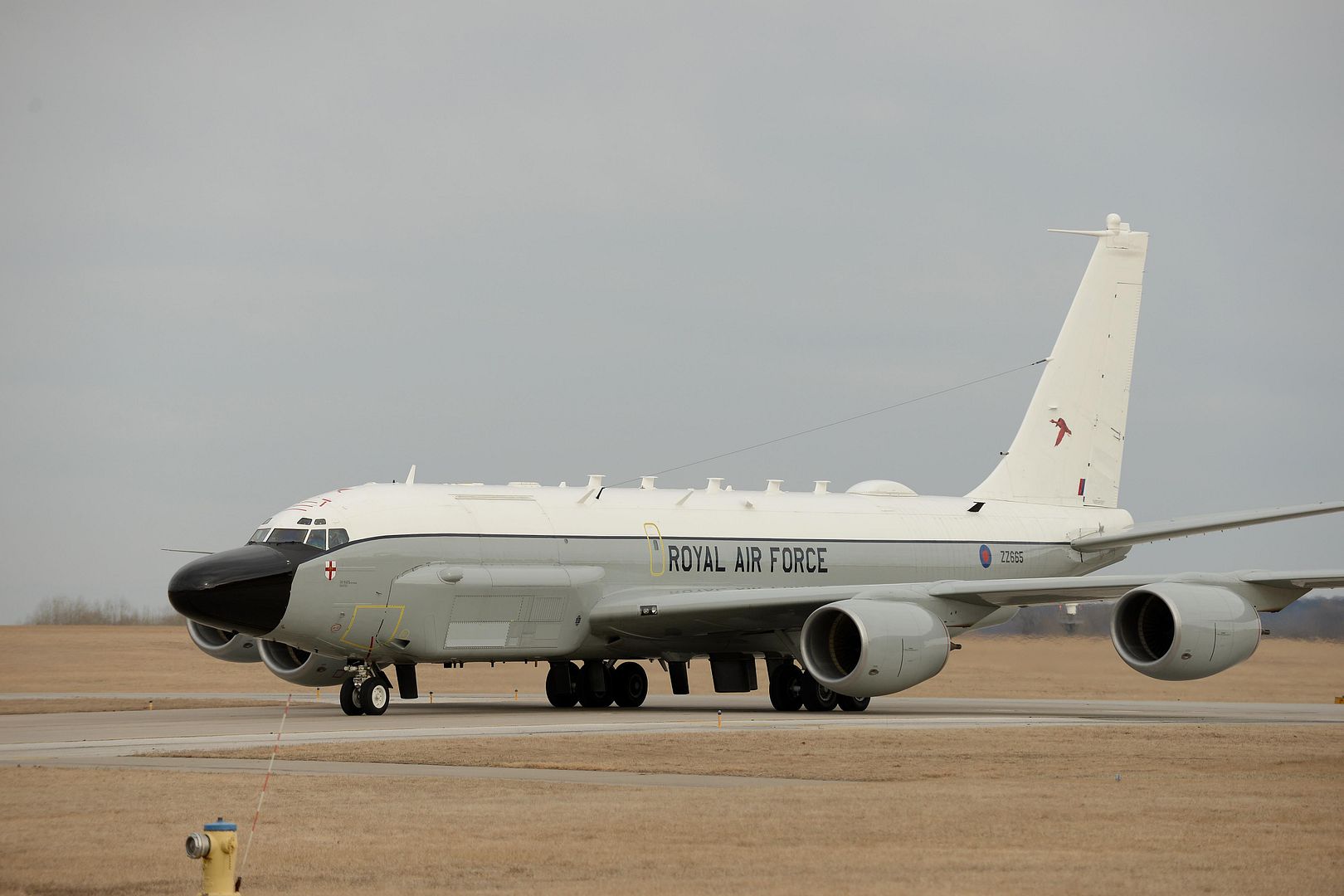
A U.S. Air Force F-16 Fighting Falcon, assigned to the 18th Aggressor Squadron, receives fuel from a 909th Air Refueling Squadron KC-135 Stratotanker Feb. 21, 2017 off the coast of Guam. Both aircraft units are training among Japan Air Self-Defense Force, Royal Australian Air Force and other U.S. Pacific Command units to participate in exercise Cope North. The 909th ARS is located at Kadena Air Base, Japan, and has 15 Stratotankers that deploy to worldwide destinations, providing global reach for U.S. and allied aircraft. (U.S. Air Force photo by Senior Airman John Linzmeier/released)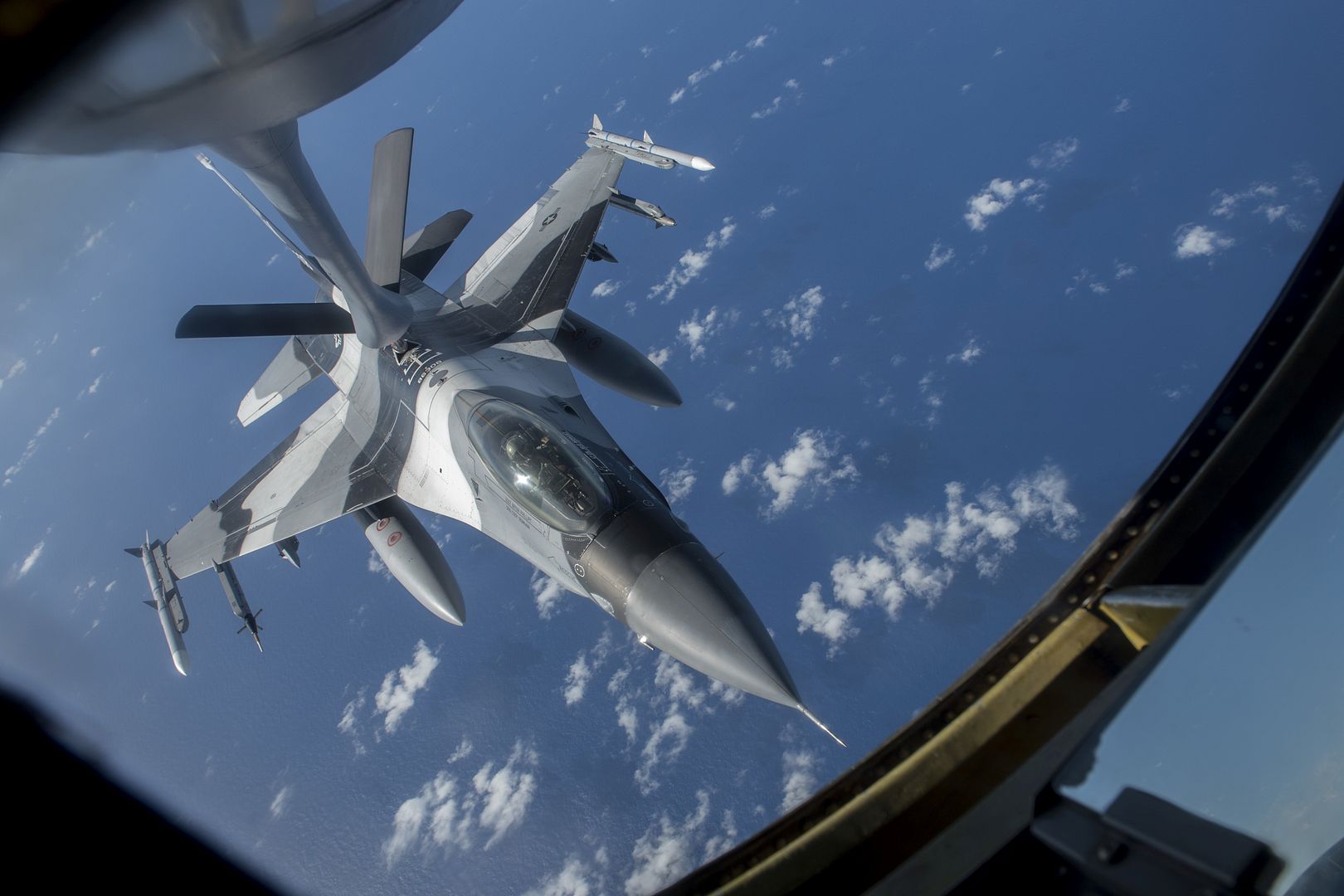
A U.S. Air Force F-16 Fighting Falcon assigned to the 14th Fighter Squadron from Misawa Air Base, Japan, receives fuel from a KC-135 Stratotanker during Cope North, Feb. 21, 2017. Cope North is an annual exercise which enables regional forces to hone vital readiness skills. Through air refueling operations, U.S. Air Force and allied aircraft have the capability to deter threats and promote security across the Indo-Asia Pacific region. (U.S. Air Force photo by Senior Airman John Linzmeier/released)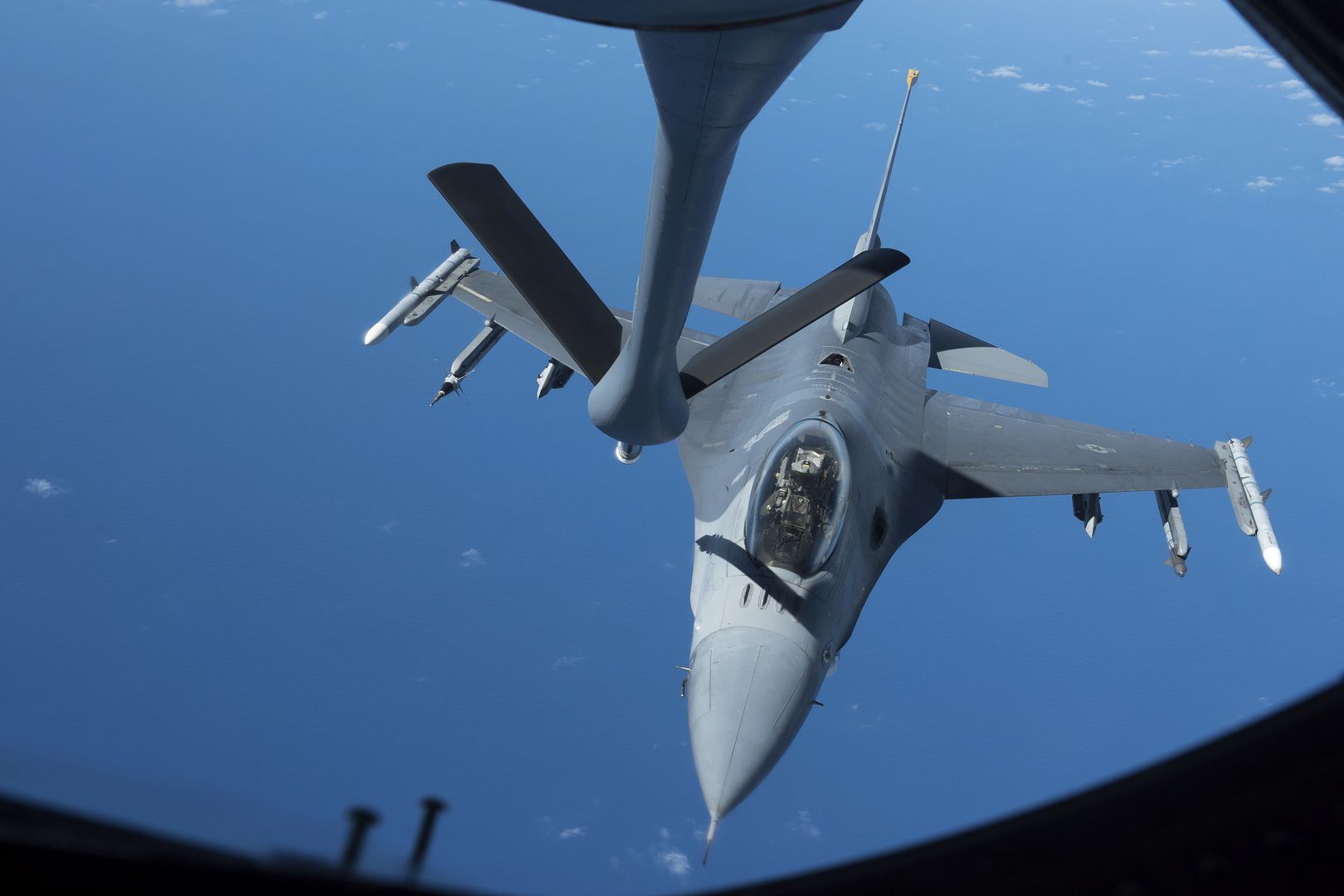
A U.S. Air Force B-1B Lancer assigned to the 9th Expeditionary Bomb Squadron receives fuel from a KC-135 Stratotanker from the 909th Air Refueling Squadron during annual exercise Cope North, Feb. 21, 2017. Cope North provides an opportunity to train and increase combat readiness and interoperability between partnered forces. Stratotankers have provided the core aerial refueling capability for the United States Air Force for more than 60 years. (U.S. Air Force photo by Senior Airman John Linzmeier/released)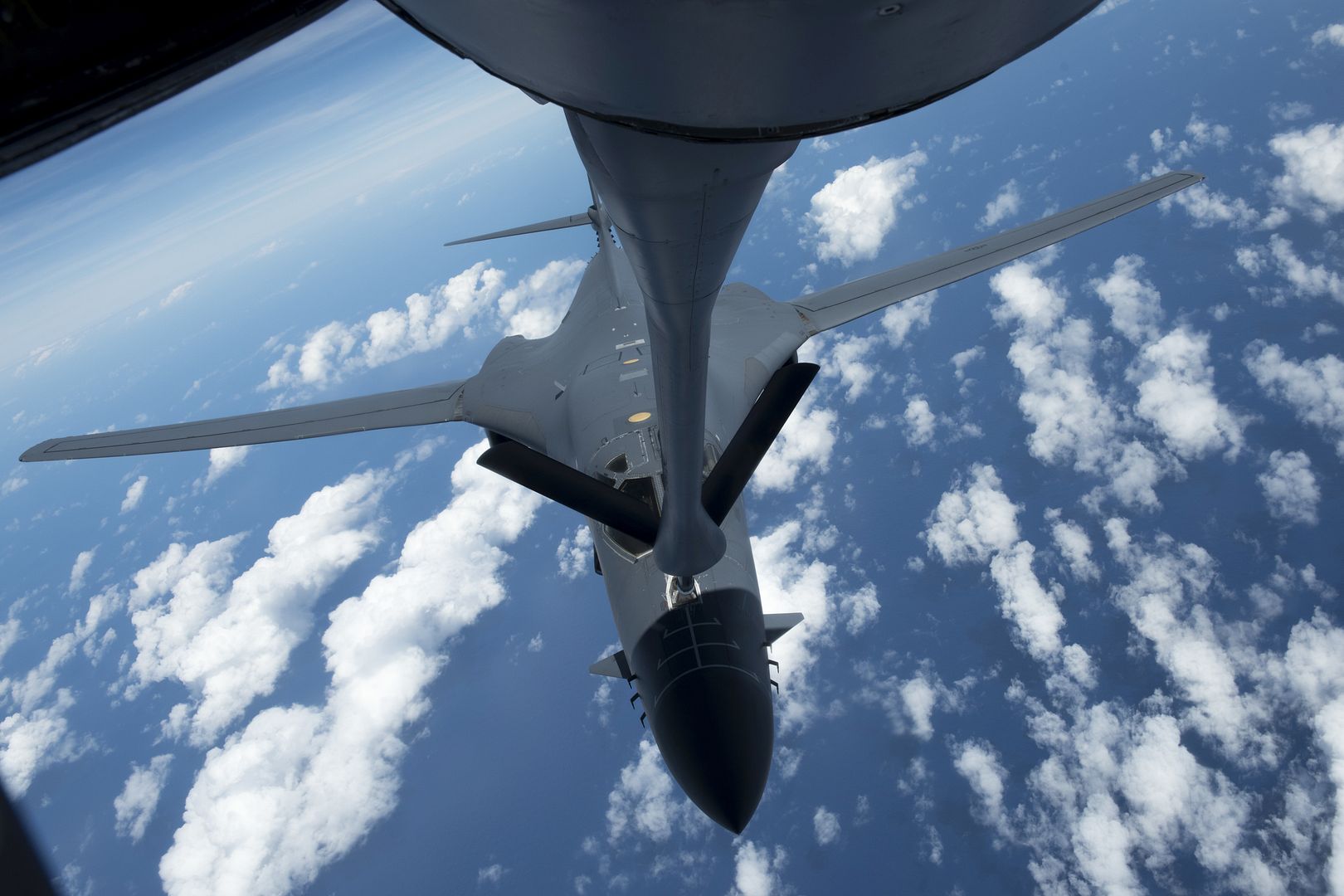
MEDITERRANEAN SEA (Feb. 20, 2017) An F/A-18F Super Hornet attached to the "Black Lions" of Strike Fighter Squadron (VFA) 213 lands on the flight deck of the aircraft carrier USS George H.W. Bush (CVN 77). The George H.W. Bush Carrier Strike Group is conducting naval operations in the U.S. 6th Fleet area of operations in support of U.S. national security interests. (U.S. Navy photo by Mass Communication Specialist 3rd Class Christopher Gaines/Released)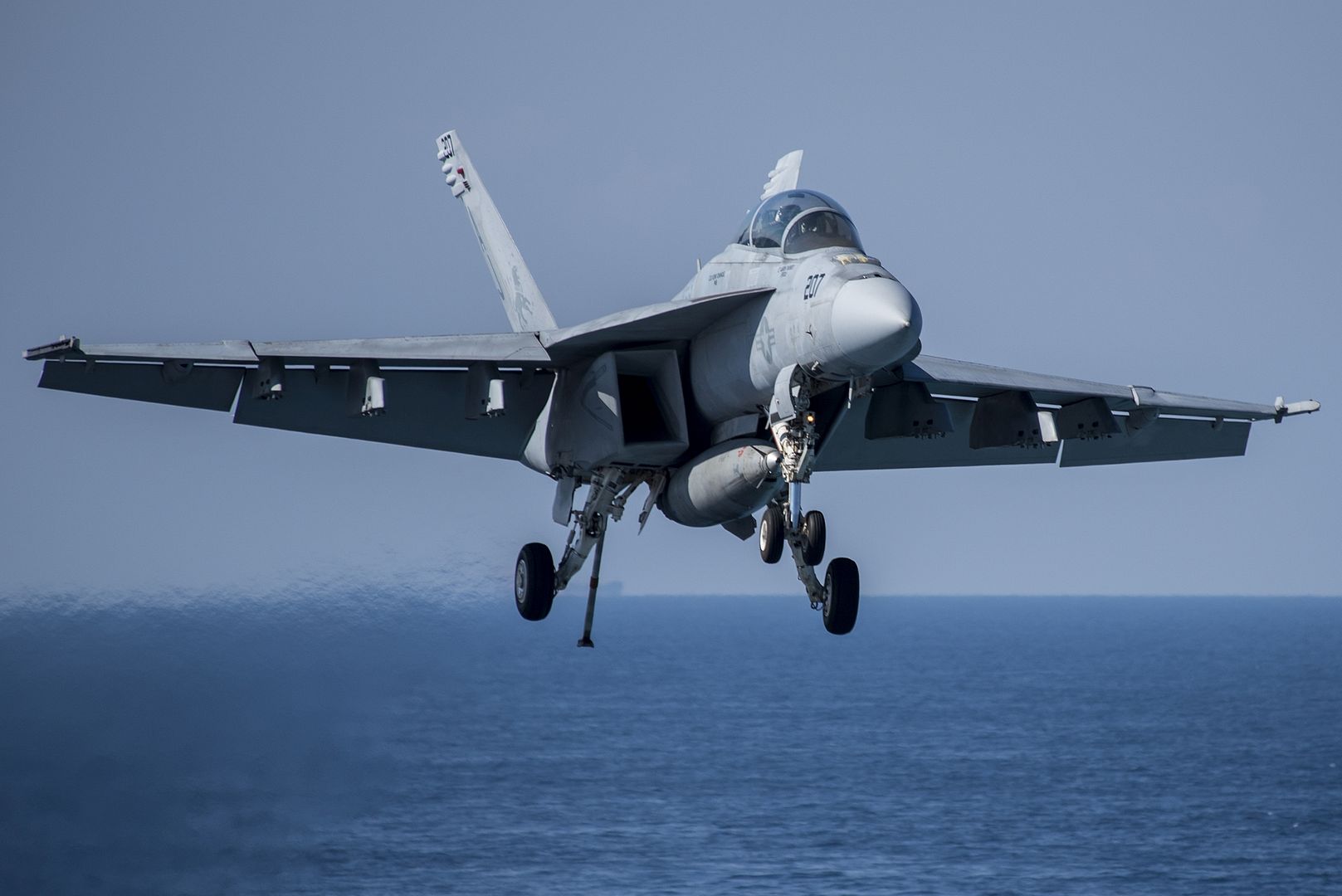
-
 Main AdminA German Tornado receives fuel from a KC-10 Extender during a mission in support of Combined Joint Task Force-Operation Inherent Resolve over Iraq, Feb. 22, 2017.The KC-10 Extender offloaded 126,000 pounds of fuel to multi-national Coalition aircraft working to weaken and destroy Islamic State in Iraq and the Levant operations in the Middle East region and around the world. (U.S. Air Force photo/Senior Airman Tyler Woodward)
Main AdminA German Tornado receives fuel from a KC-10 Extender during a mission in support of Combined Joint Task Force-Operation Inherent Resolve over Iraq, Feb. 22, 2017.The KC-10 Extender offloaded 126,000 pounds of fuel to multi-national Coalition aircraft working to weaken and destroy Islamic State in Iraq and the Levant operations in the Middle East region and around the world. (U.S. Air Force photo/Senior Airman Tyler Woodward)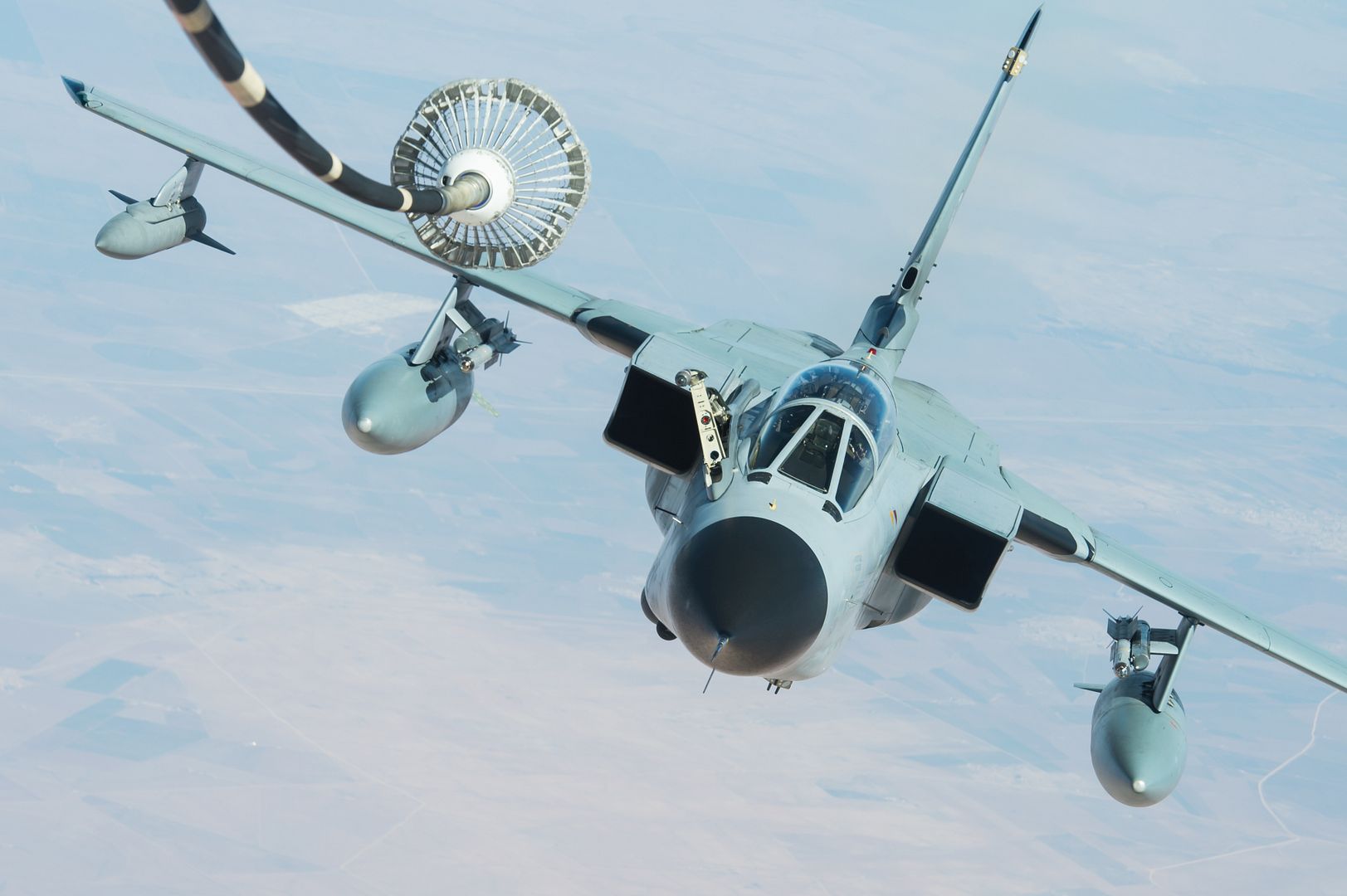
A German Tornado separates from a KC-10 Extender after receiving fuel during a mission in support of Combined Joint Task Force-Operation Inherent Resolve over Iraq, Feb. 22, 2017.The KC-10 Extender offloaded 126,000 pounds of fuel to multi-national Coalition aircraft working to weaken and destroy Islamic State in Iraq and the Levant operations in the Middle East region and around the world. (U.S. Air Force photo/Senior Airman Tyler Woodward)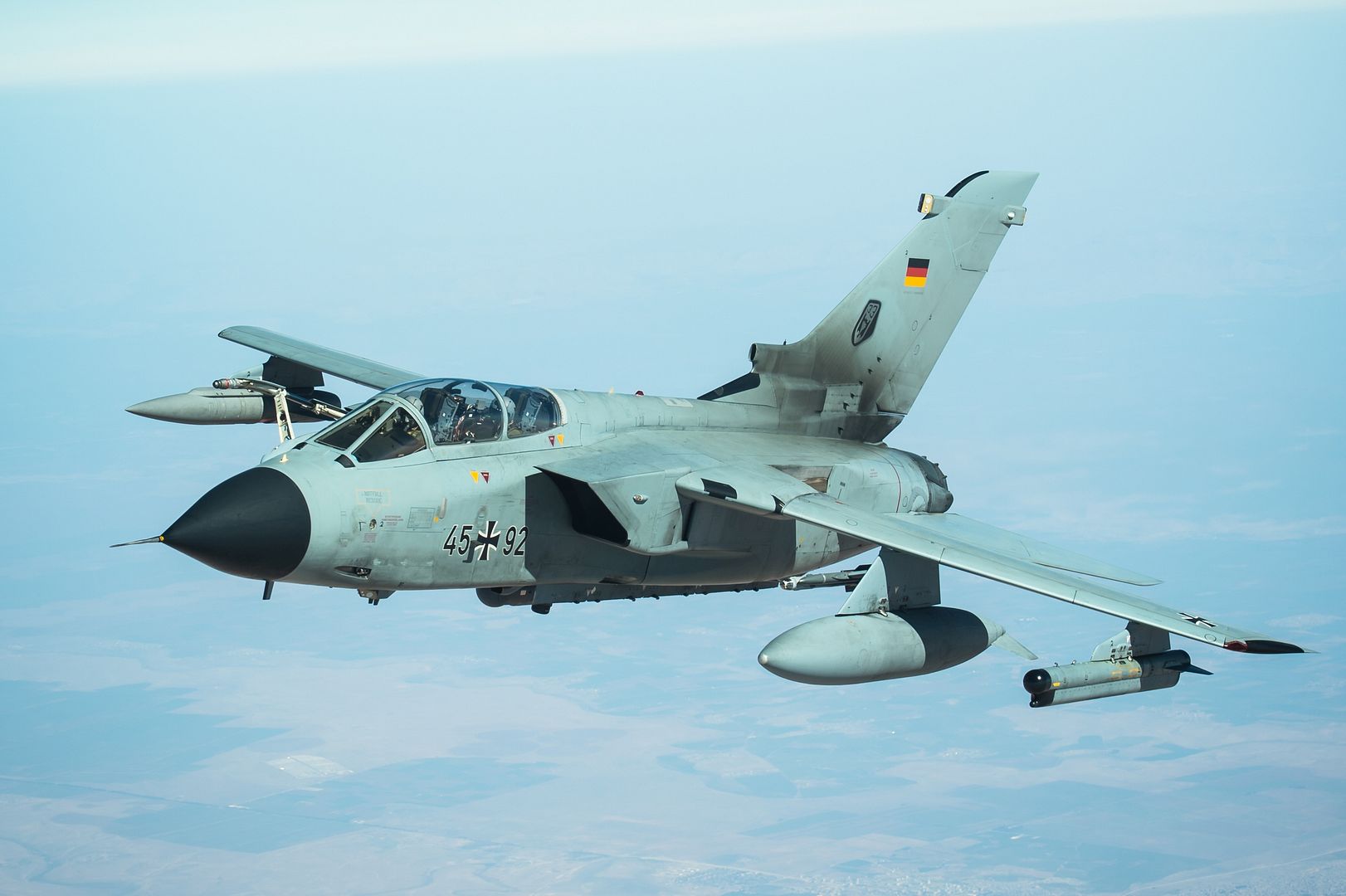
An F-15E Strike Eagle separates from a KC-10 Extender after receiving fuel during a mission in support of Combined Joint Task Force-Operation Inherent Resolve over Iraq, Feb. 22, 2017.The KC-10 Extender offloaded 126,000 pounds of fuel to multi-national Coalition aircraft working to weaken and destroy Islamic State in Iraq and the Levant operations in the Middle East region and around the world. (U.S. Air Force photo/Senior Airman Tyler Woodward)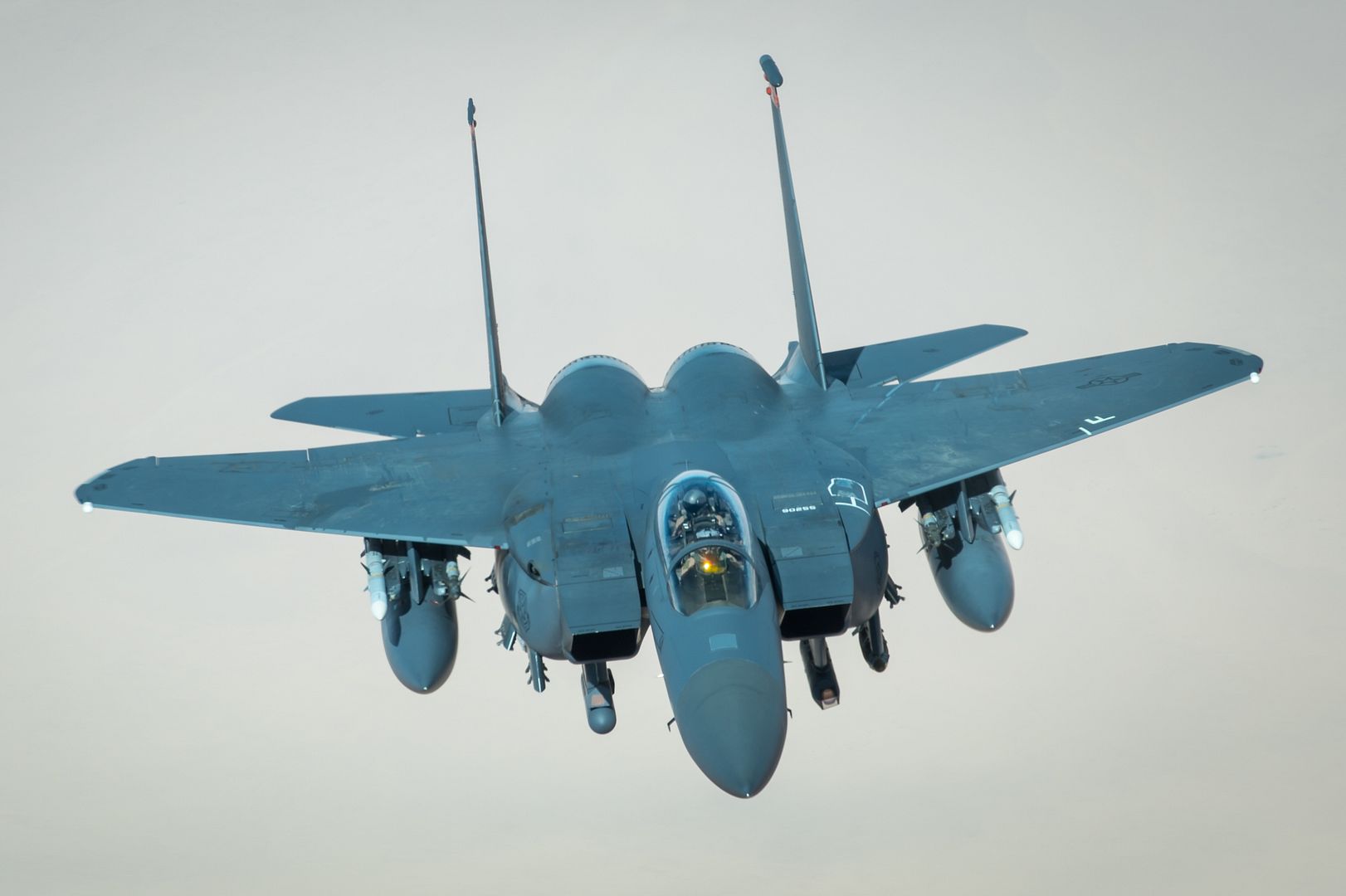
A U.S. Marine Corps AV-8B Harrier separates from a KC-10 Extender after receiving fuel during a mission in support of Combined Joint Task Force-Operation Inherent Resolve over Iraq, Feb. 22, 2017.The KC-10 Extender offloaded 126,000 pounds of fuel to multi-national Coalition aircraft working to weaken and destroy Islamic State in Iraq and the Levant operations in the Middle East region and around the world. (U.S. Air Force photo/Senior Airman Tyler Woodward)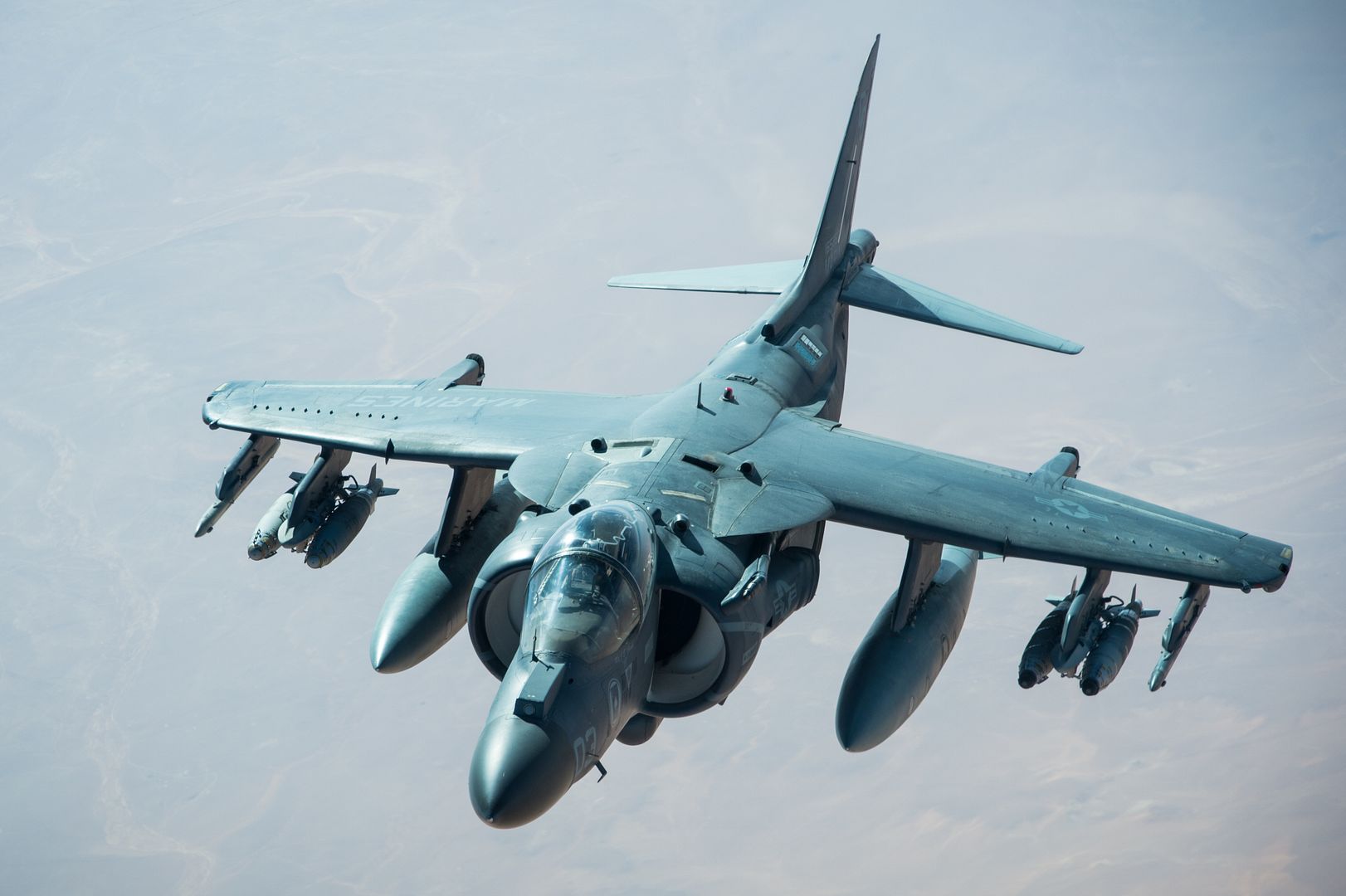
An F-16 Fighting Falcon is parked on the flightline Feb. 22, 2017 at the 180th Fighter Wing, Ohio Air National Guard in Swanton, Ohio. The 180FW provides protection of the homeland and defense support to civil authorities. (U.S. Air National Guard photo by Staff Sgt. Shane Hughes)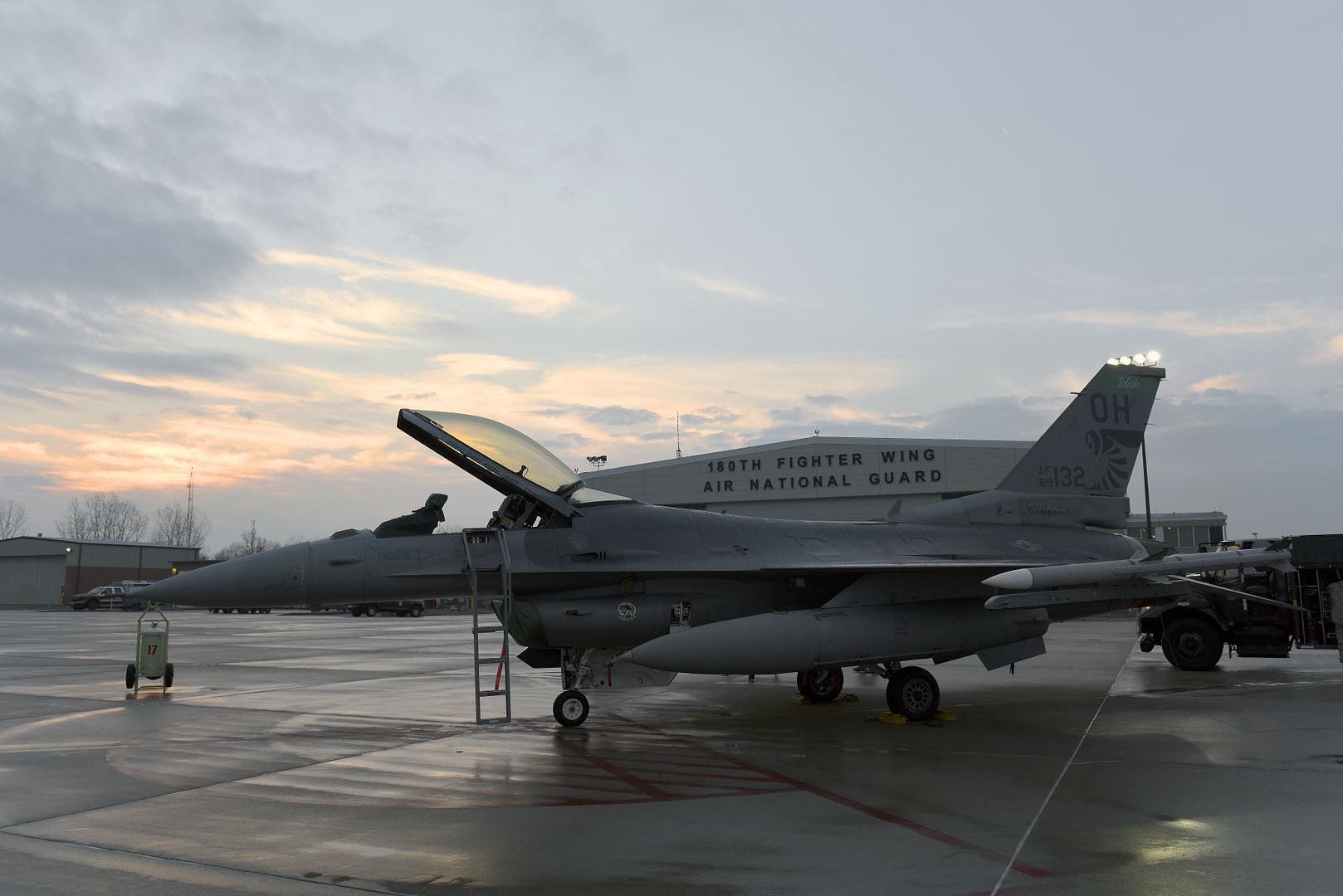
An Army AH-64 Apache helicopter is unloaded from an Air Mobility Command C-5M Galaxy at Ramstein Air Base, Germany, Feb. 22, 2017, in support of Operation Atlantic Resolve. The four Apache helicopters that arrived are part of a larger contingent of helicopters and personnel comprising of Operation Atlantic Resolve, a U.S. commitment to maintaining peace and stability in the European region. (U.S. Air Force photo's/Staff Sgt. Timothy Moore)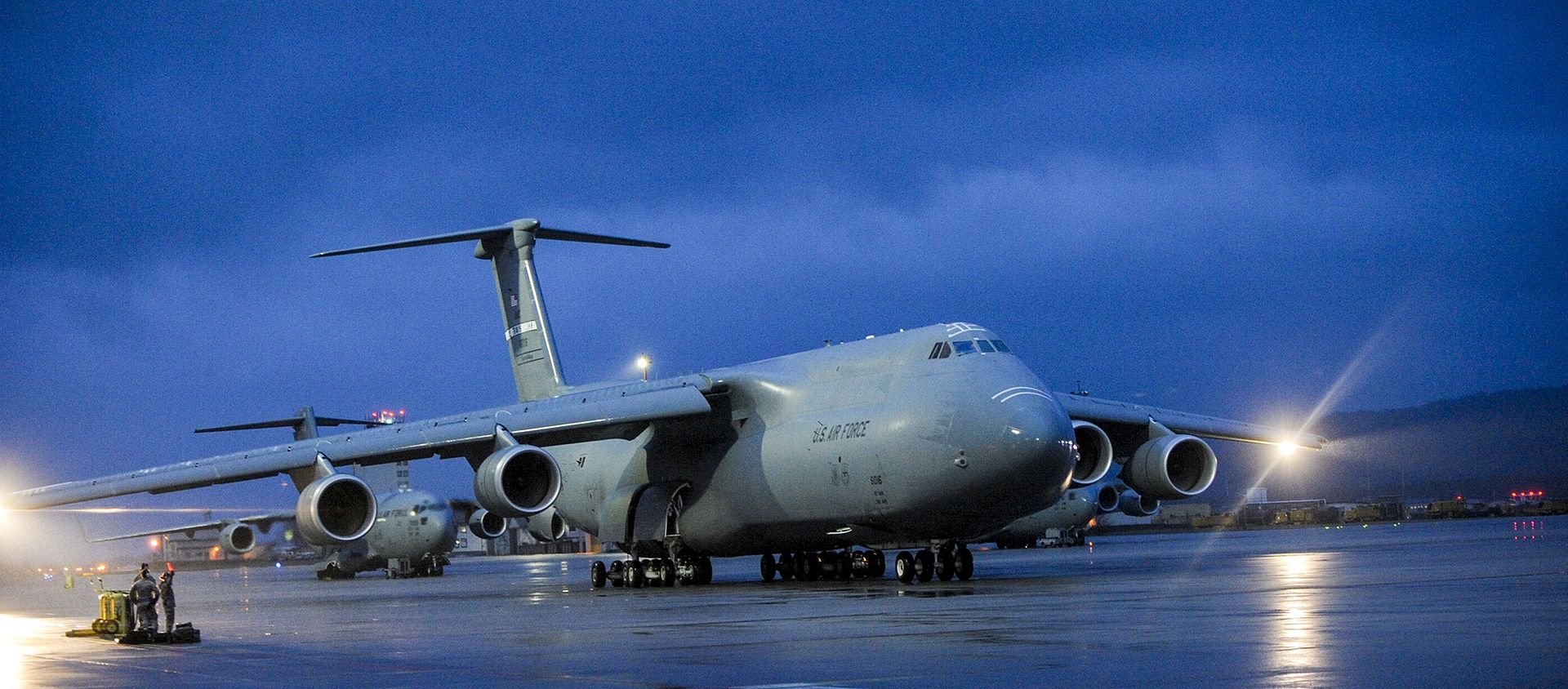

ANDERSEN AIR FORCE BASE, Guam -- Cope North is a long-standing Pacific Air Forces-led exercise designed to enhance multilateral air operations between the U.S. Air Force, U.S. Navy, Japan Air Self-Defense Force and Royal Australian Air Force. The exercise includes 22 total flying units and more than 1,700 personnel from three countries and continues the growth of strong, interoperable relationships within the Indo-Asia-Pacific Region through integration of airborne and land-based command and control assets.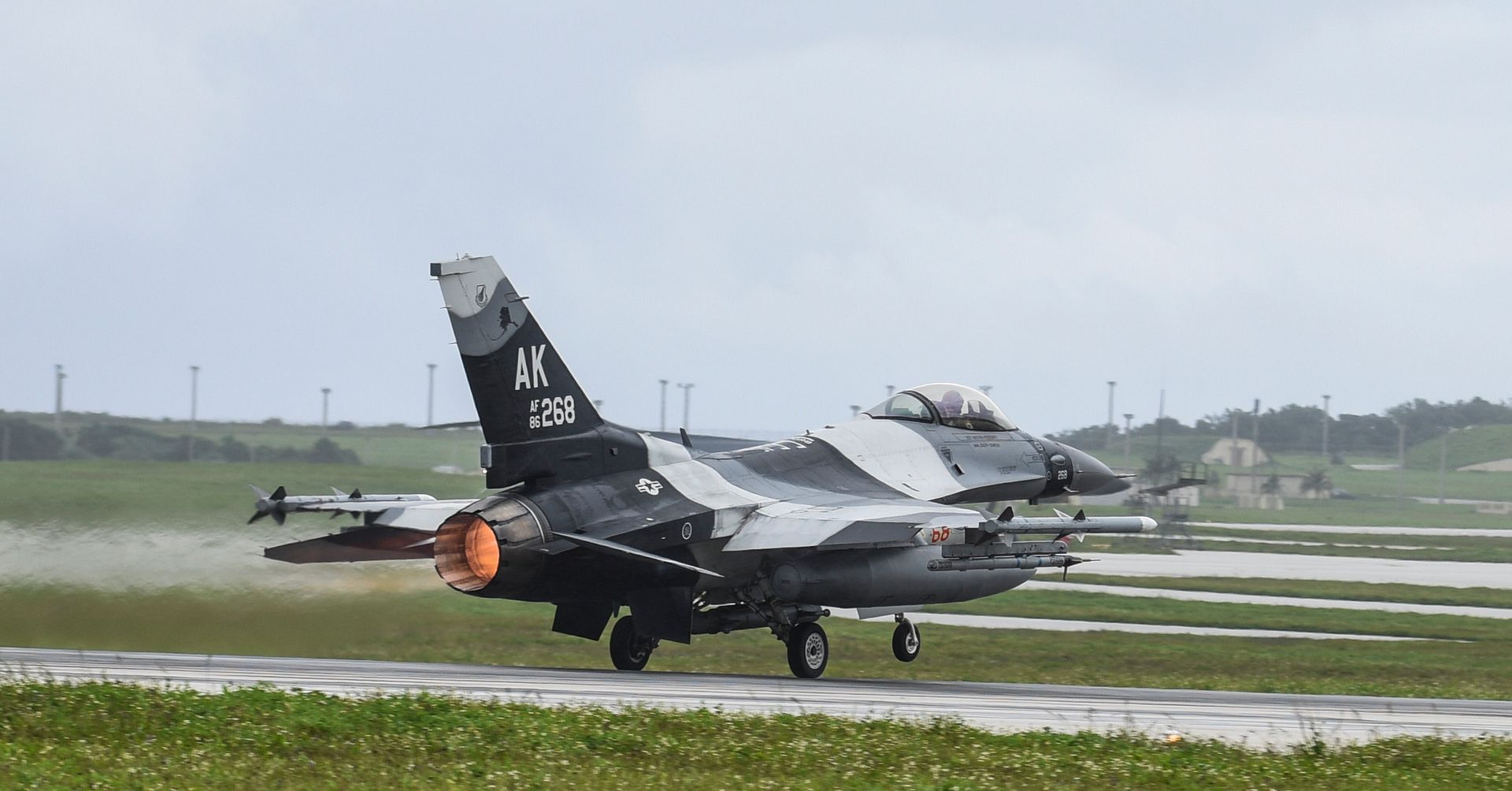
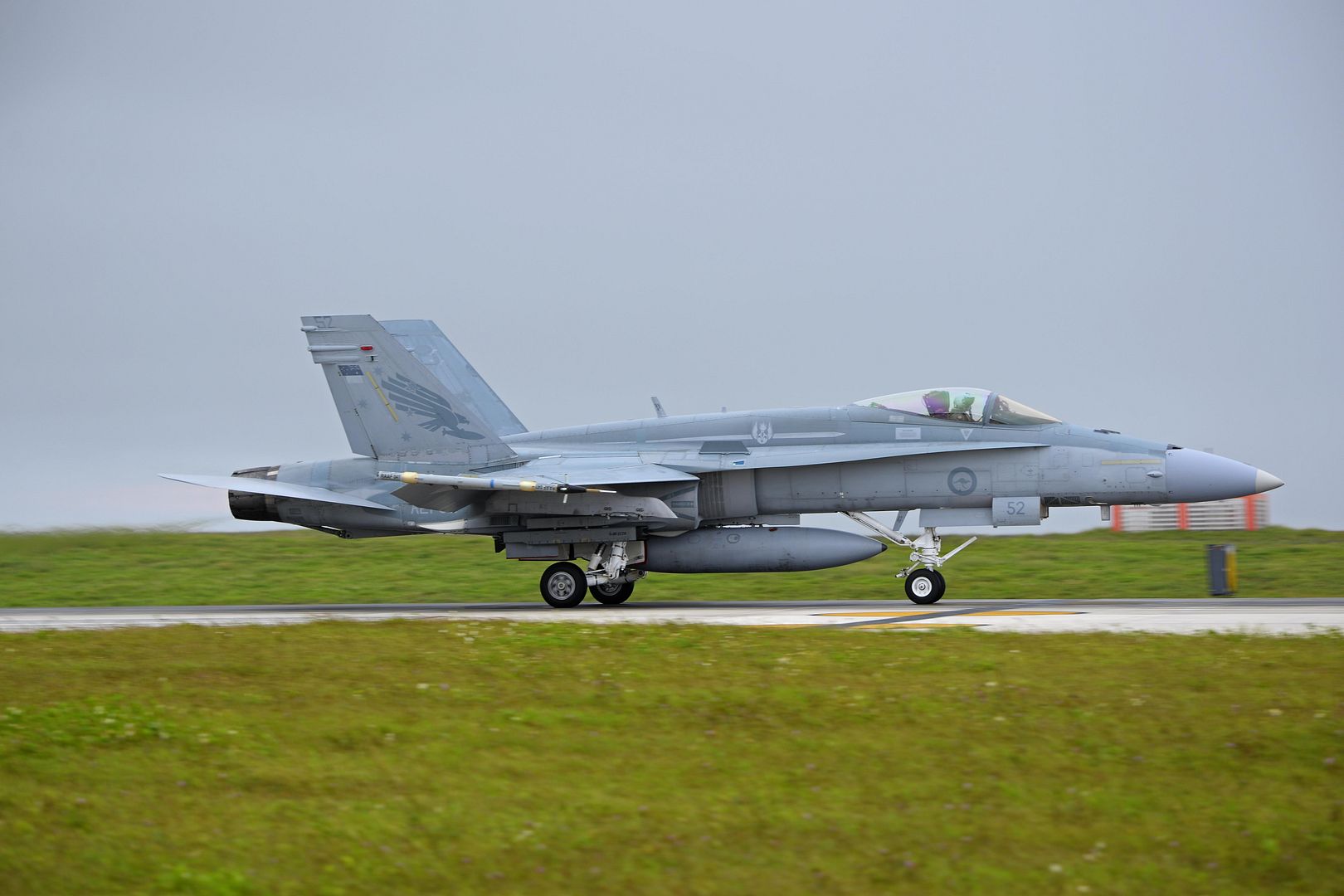
CHARLESTON, S.C., Feb. 22, 2017 /PRNewswire/ -- Boeing [NYSE:BA] and Korean Air today celebrated the delivery of the airline's first 787-9 Dreamliner. The Seoul-based carrier will be the first Korean carrier to operate the 787-9 Dreamliner in the country. The airline is scheduled to launch domestic flights to Jeju from Seoul (Gimpo) for a month as part of the required certification period, before launching long-haul international routes to Toronto, Madrid, and Zurich later this year.
"The 787 Dreamliner will be a key member of Korean Air's fleet as we continue to introduce next-generation airplanes to our customers," said Walter Cho, president of Korean Air. "The aircraft is fuel efficient, quiet, has lower operating costs and is spacious and very elegant. The cabin features are impressive and will ensure maximum comfort for Korean Air's passengers."
Korean Air is scheduled to introduce five 787-9 Dreamliners to its fleet this year with another five joining the fleet by 2019.
"This milestone delivery adds yet another chapter in our long and successful relationship with Korean Air," said Rick Anderson, vice president of Northeast Asia Sales, Boeing Commercial Airplanes. "Korean Air continues to demonstrate its leadership in the global commercial airline industry and we are confident that the market-leading efficiency and comfort of the 787-9 Dreamliner will build onto their long-term success for many years to come."
The Boeing 787-9 Dreamliner is the second member of the super-efficient, passenger-pleasing 787 family. Both the 787-8 and 787-9 bring the economics of large jets to the middle of the market, with 20 percent less fuel use and 20 percent fewer emissions than the airplanes they replace. At 20 feet (6 meters) longer than the 787-8, the 787-9 extends the family in capacity and range, flying more passengers and more cargo farther.
Korean Air, with a fleet of 175 aircraft, is one of the world's top 20 airlines, and operates more than 460 flights per day to 132 cities in 46 countries. It is a founding member of the SkyTeam alliance, which together with its 20 members, offers its 665 million annual passengers a worldwide system of more than 17,343 daily flights covering 1,062 destinations in 177 countries.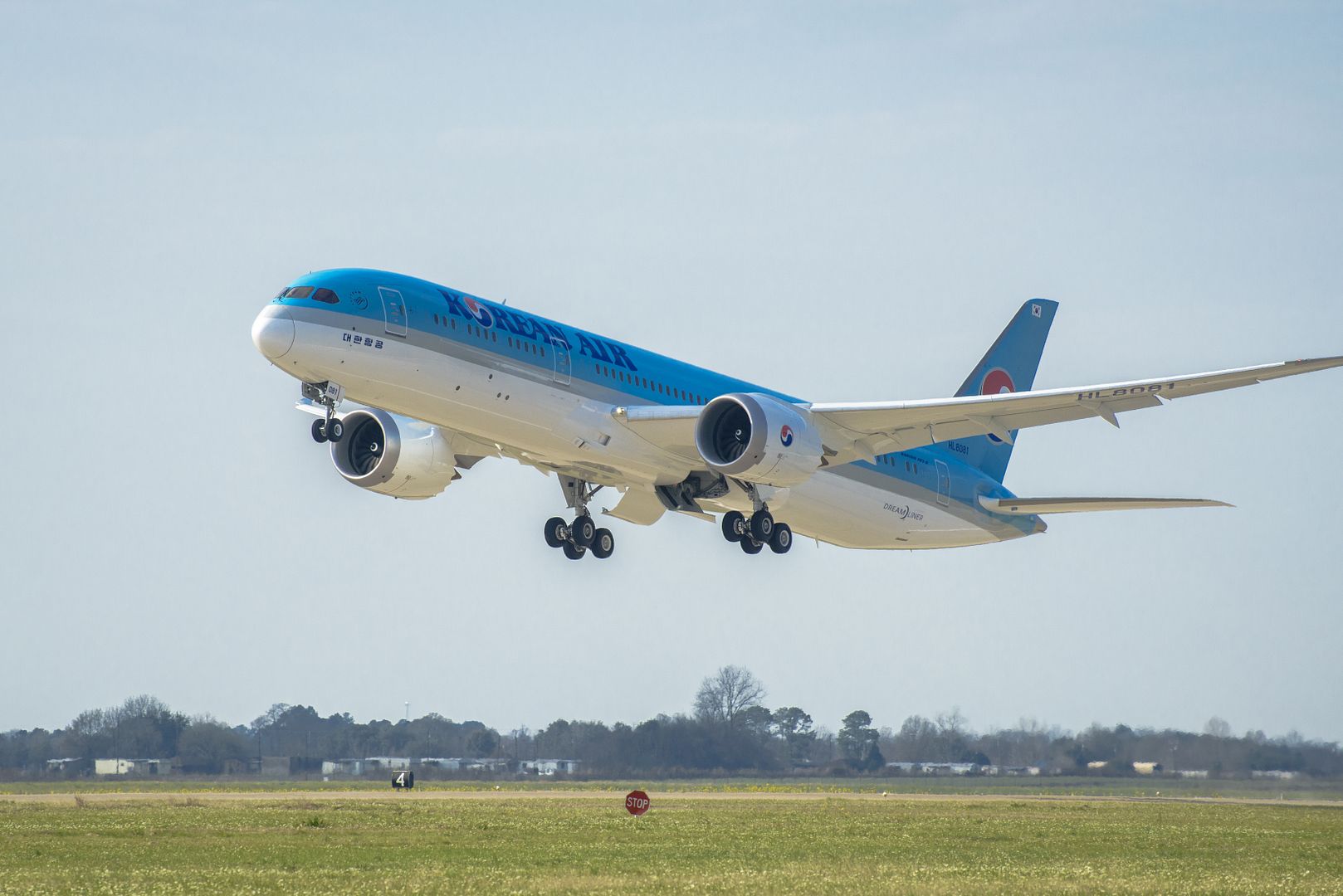
-
 Main AdminA North Carolina Air National Guard C-130 takes off carrying deploying arimen to southwest Asia in support of Operation Freedom's Sentinel, at the North Carolina Air National Guard Base, Charlotte Douglas International Airport, Feb. 23, 2017. It is the final deployment using the C-130 model aircraft before the unit transitions to using C-17's.
Main AdminA North Carolina Air National Guard C-130 takes off carrying deploying arimen to southwest Asia in support of Operation Freedom's Sentinel, at the North Carolina Air National Guard Base, Charlotte Douglas International Airport, Feb. 23, 2017. It is the final deployment using the C-130 model aircraft before the unit transitions to using C-17's.
Photo by Tech. Sgt. Nathan Clark.
EDWARDS AIR FORCE BASE, Calif. --
A U.S. Navy E6-B recently completed testing at Edwards and returned to Tinker Air Force Base, Oklahoma Feb. 7.
The E-6B Mercury is a communications relay and strategic airborne command post aircraft. It provides survivable, reliable and endurable airborne command and control, and can communicate between the National Command Authority and U.S. strategic and non-strategic forces. The Navy has two squadrons, the "Ironmen" of VQ-3 and the "Shadows" of VQ-4, which deploy more than 20 aircrews from Tinker AFB to meet these requirements, according to the Navy.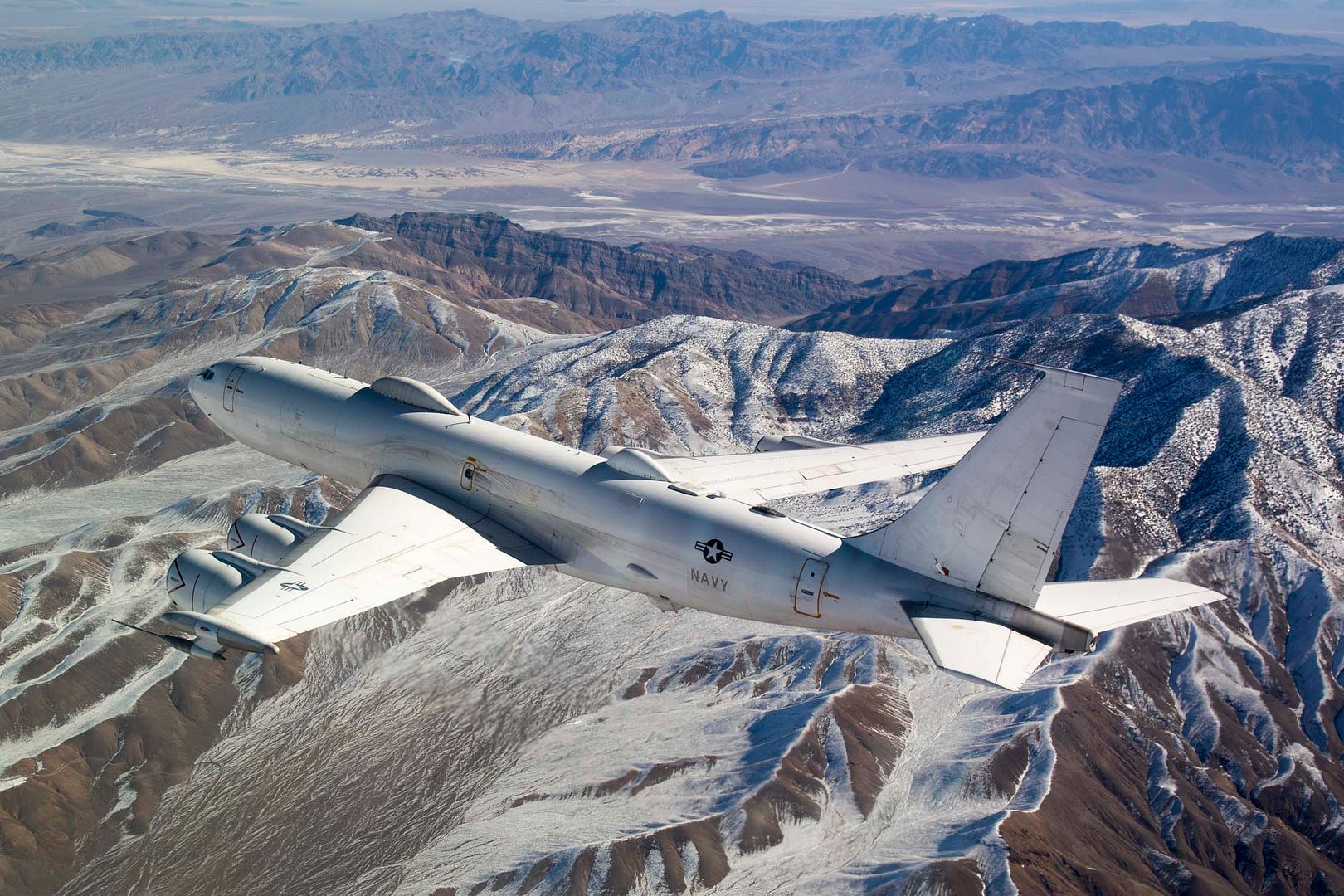
?They were here executing flutter and loads testing on the E-6B with Multi-Role Tactical Common Data Link modification incorporated, said Sawn Sandland, 418th Flight Test Squadron program manager. ?This modification includes three changes to the outer mold line of the E-6B consisting of three new radomes.?
The Navy periodically brings an E-6B to Edwards for testing. Sandland said base support includes supplying facilities, providing chase planes and range usage and data collection.
?They chose Edwards because of predicted clear weather during the test campaign. Unfortunately, it rained just about every day the first week they were here.?
According to the Navy, the E-6B was conceived as a replacement for the Air Force's Airborne Command Post due to the age of the EC-135 fleet. The E-6B is a modified E-6A with added battle staff positions and other specialized equipment. The E-6B is a dual-mission aircraft capable of fulfilling either the E-6A?s mission of linking the NCA with naval ballistic missile forces, or the airborne strategic command post mission, and is equipped with an airborne launch control system. The ALCS is capable of launching U.S. land-based intercontinental ballistic missiles.
The first E-6B aircraft was accepted by the Navy in December 1997 and the E-6B assumed its operational missions in October 1998. The E-6 fleet was completely modified to the E-6B configuration in 2003.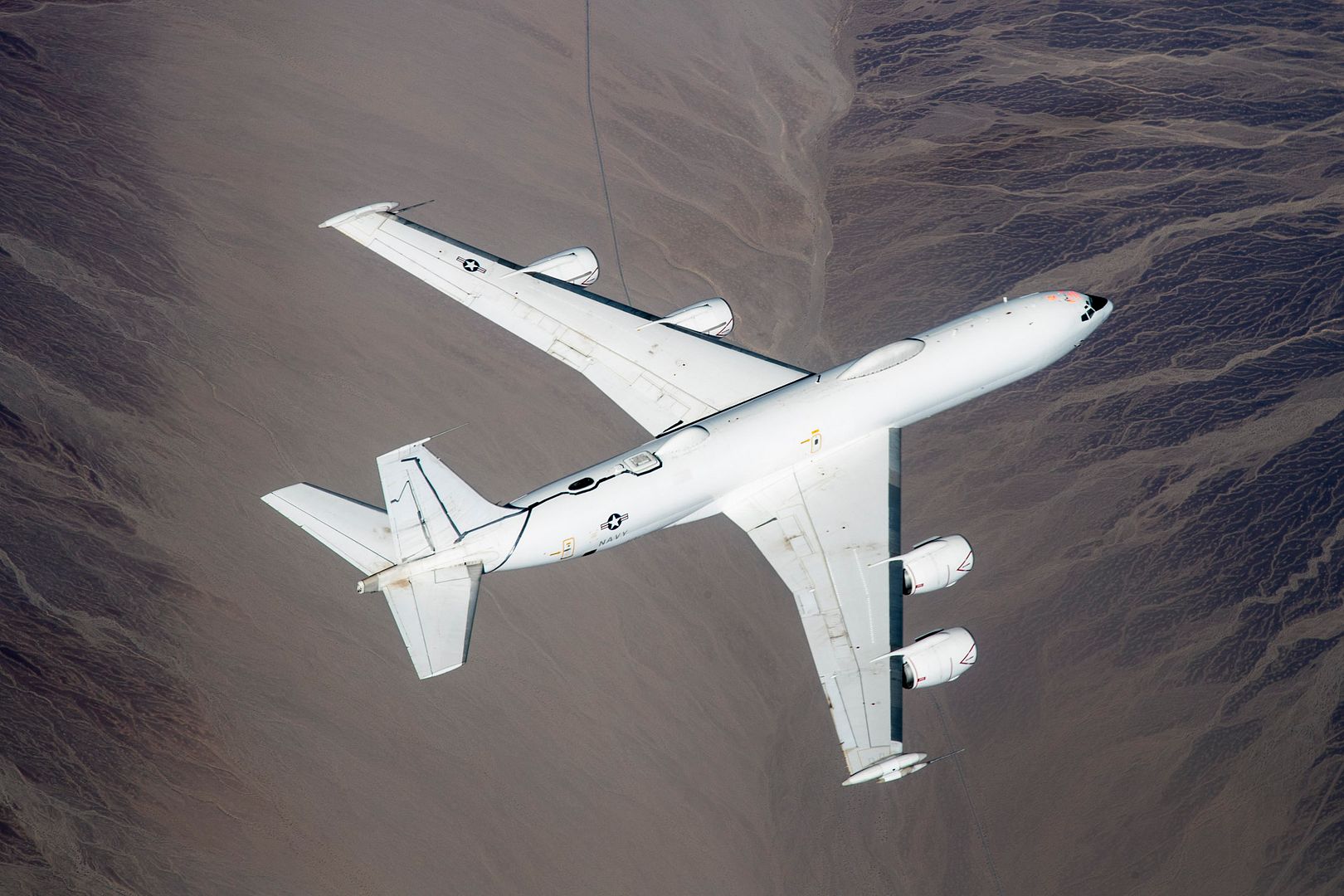
STRATFORD, Conn., Feb. 23, 2017 /PRNewswire/ -- Sikorsky, a Lockheed Martin (NYSE: LMT) company and its affiliate PZL Mielec are finalizing an M28 short takeoff and landing airplane for its transatlantic flight from southeast Poland to Latin America and the Caribbean.
Once in the region, the 7,500 kg (16,500 lb.) twin turboprop airplane will demonstrate to interested militaries and commercial transport its ability to move people and cargo into short, unpaved or underdeveloped airstrips. The tour begins in Port of Spain, Trinidad & Tobago on March 17, 2017 before visiting 12 other cities through mid-May across Brazil, Argentina, Ecuador, Colombia, Panama and Mexico.
Engineers at PZL Mielec have given the newly built airplane ? serial number AJE00347 ? its final coat of paint, and the necessary equipment that will showcase the plane's quick conversion to passenger configuration, paratroop, cargo transport or casualty evacuation.
PZL pilots and aircrew will fly the aircraft from Mielec, Poland, on February 24 to Denmark, then begin the maritime leg to Scotland and Iceland. The aircraft arrives in Kulusuk, Greenland on February 28 after 2,164 nm and approximately 10 hours of transatlantic flying.
"The westward transatlantic crossing in mid-winter is just one example of extreme weather flying for this rugged and reliable M28 airplane," said Mariusz Kubryn, M28 chief designer. "By the end of the demonstration tour in Latin America this spring, the aircraft will have flown 14,500 km over mountain ranges and oceans, taken off and landed on jungle and island airstrips, and shown its ability to perform under hot and icing conditions."
The M28 aircraft is certified by Brazil's ANAC, and by EASA and the FAA to perform in minus 50?C to 50?C temperatures. The airframe's ice protection system is certified for flight into known icing conditions.
A high-lift wing, two 1,100 shp (820 kW) Pratt & Whitney Canada PT6-65B turboprop engines, and thrust-reversing propellers give the airplane unique short takeoff and landing capabilities. With a maximum payload of 2,300 kg (5,000 lb), the M28 can take off and land on rough airstrips just 548 meters (1,800 ft.) long.
"When you combine the maneuverability of the M28 with its large cabin and clamshell rear doors, this airplane has the power and payload to fly very different mission profiles," noted Adam Schierholz, Sikorsky's regional executive for Latin America. "Militaries and commercial airlines across Latin America and the Caribbean have expressed tremendous interest in the diverse and unique capabilities of this exceptional airplane."
To learn more about the M28 aircraft and the Caribbean and Latin America tour, please link to www.m28aircraft.com.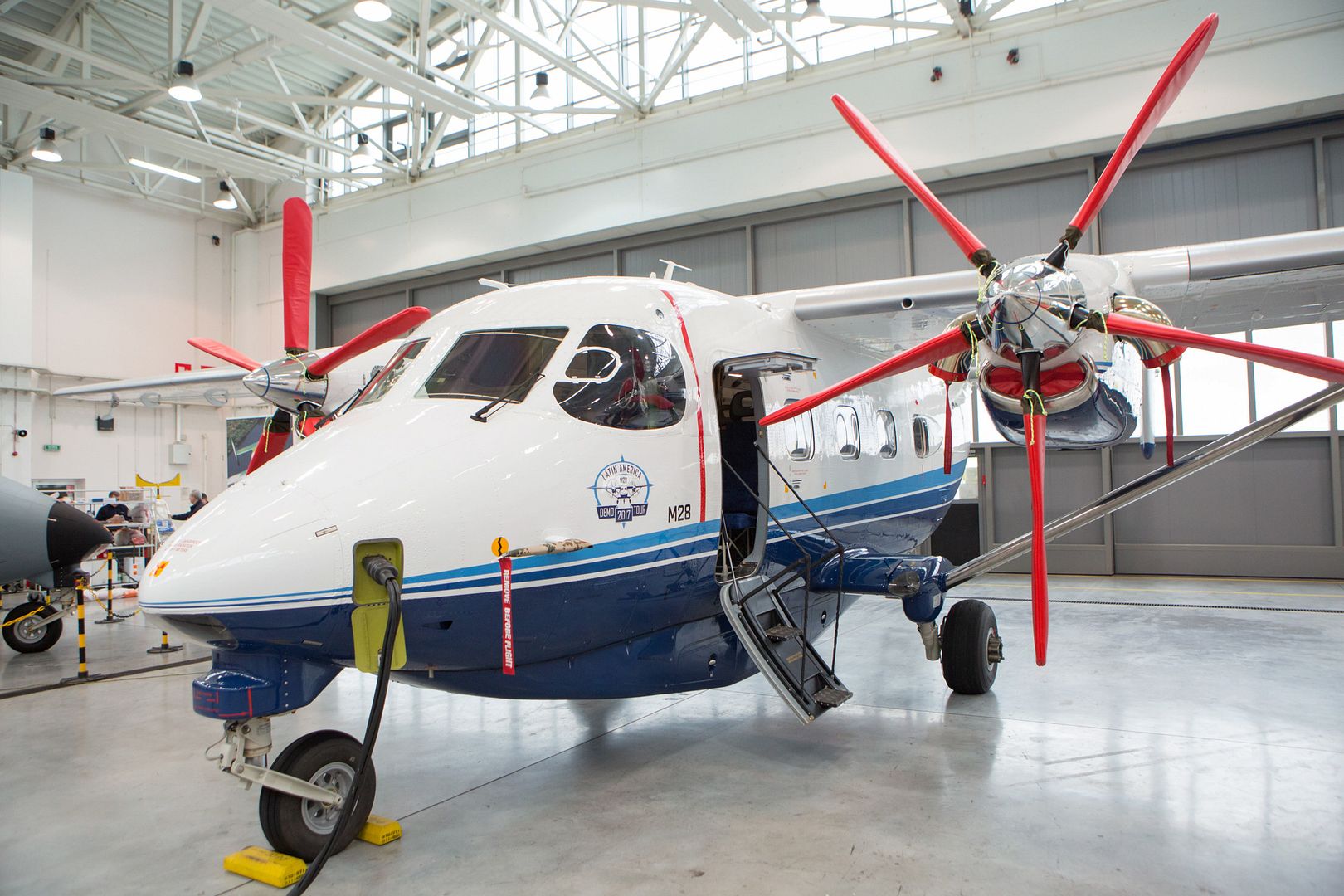
24 February 2017 Press Release
Toulouse, 23rd February 2017 - Citilink, the low cost unit of Garuda Indonesia, has taken delivery of its first A320neo at Airbus headquarters in Toulouse, France. The aircraft is the first of 35 A320neo set to enter service with the carrier.
Citilink has selected CFM Leap-1A engines to power its A320neo fleet, which will be operated on its domestic network, and new international services to China and the Middle East.
Seating 180 passengers in a single class layout, the A320neo joins an existing fleet of 44 A320ceo aircraft flying with the carrier.
The A320neo ?new engine option? incorporates many innovations, including latest generation engines and large Sharklet wing-tip devices, which together deliver more than 15 percent in fuel savings from day one and 20 percent by 2020 with further cabin innovations. With over 5,000 orders received from 92 customers since its launch in 2010, the A320neo Family has captured some 60 percent share of the market.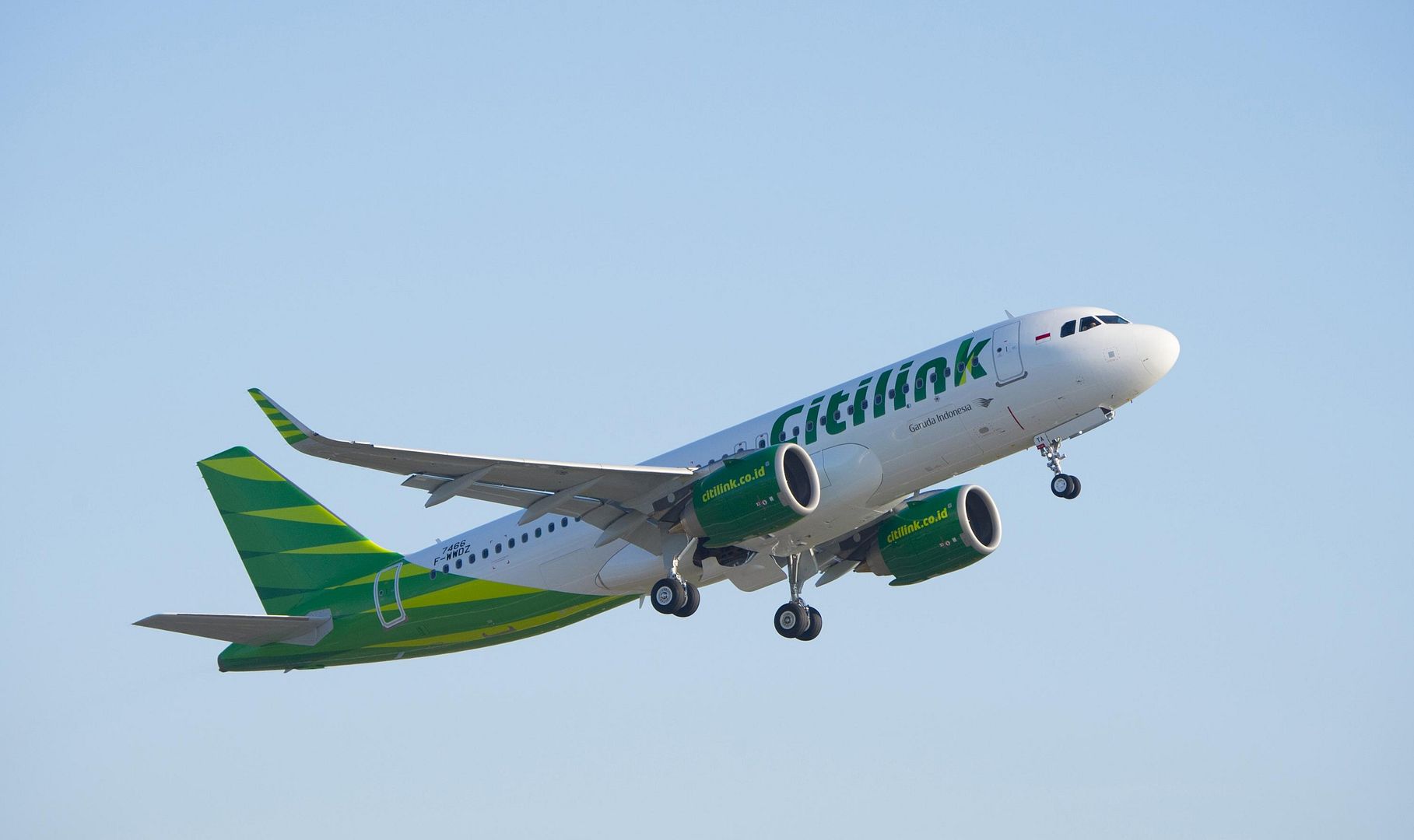
S?o Jos? dos Campos, Brazil, February 23, 2017 ? Embraer Executive Jets delivered 63 Phenom 300 light jets in 2016, the highest volume of any business jet model for the year, according to a report made by the General Aviation Manufacturers Association (GAMA). This is the fourth consecutive year that the Phenom 300 achieves this mark, and it has accumulated 266 deliveries since 2013.
?We are elated to once again see the Phenom 300 receive such an important recognition from the market. We are very grateful to our customers for the validation of both the aircraft?s original design as well as all their input, which has made this jet the best in its class,? said Paulo Cesar Silva, Embraer CEO. ?Our customers? reaffirmation of trust in us only strengthens our resolve to deliver the best customer experience.?
In seven years of operation, the Phenom 300 fleet is approaching the 400 aircraft mark, having sustained more than half of the light jet market share since 2012. The aircraft is in operation in 30 countries and has accumulated close to 500,000 flight hours. Embraer is continuously investing in its competitiveness with enhancements to its comfort, technology and operational efficiency.
The Phenom 300 is one of the fastest light jets, having established several speed records with the National Aeronautic Association and the Federation Aeronautique International.
The Phenom 300 performs among the top light jets, with a high speed cruise of 453 knots and a six-occupant range of 1,971 nautical miles (3,650 km) with NBAA IFR reserves. With the best climb and field performance in its class, the Phenom 300 costs less to operate and maintain than its peers. The aircraft is capable of flying at 45,000 feet (13,716 meters), powered by two Pratt & Whitney Canada PW535E engines with 3,200 pounds of thrust each.
The Phenom 300 offers a spacious cabin, designed in partnership with BMW Designworks USA, and the largest baggage compartment in its category. The largest windows in the class deliver abundant natural lighting in the cabin as well as in the private lavatory. The comfort of the seats, with recline and full movement capability, is enhanced by the best pressurization among light jets (6,600 ft. maximum cabin altitude). The Phenom 300 features distinct temperature zones for pilots and passengers, a wardrobe and refreshment center, voice and data communications options, and an entertainment system.
The pilot-friendly cockpit enables single-pilot operation and offers the advanced Prodigy Touch Flight Deck. The features it carries from a class above include single-point refueling, externally serviced lavatory, and an air stair.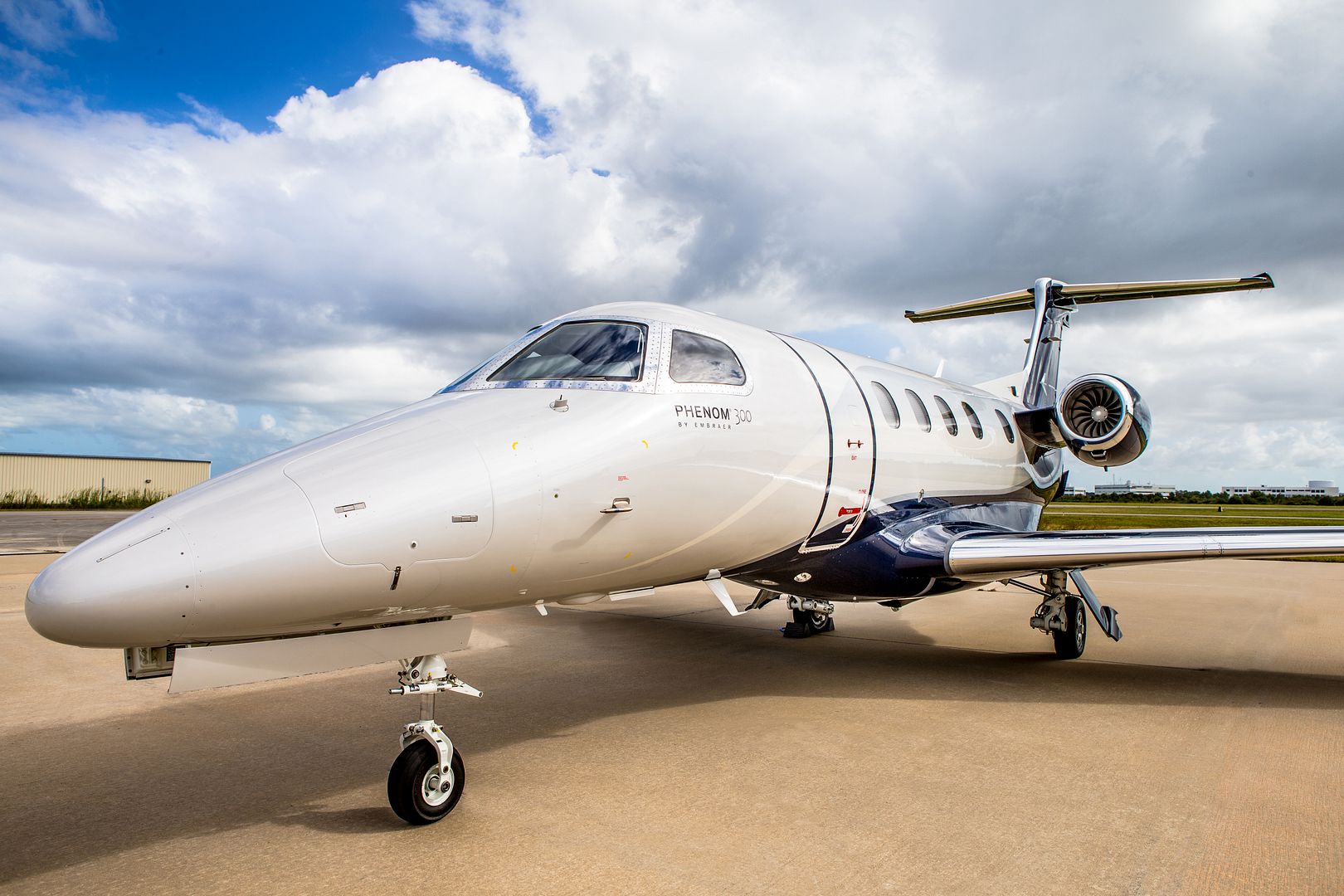
-
 Main AdminA CH-53 Super Stallion assigned to Marine Heavy Helicopter Squadron (HMH) 464, carries a Humvee during an aerial refueling training operation with Marine Aerial Refueler Transport Squadron (VMGR) 234 on Feb. 23, 2017. VMGR-234 assisted HMH-464 in the training to maintain interoperability. (U.S. Marine Corps photo's by Lance Cpl. Koby I. Saunders)
Main AdminA CH-53 Super Stallion assigned to Marine Heavy Helicopter Squadron (HMH) 464, carries a Humvee during an aerial refueling training operation with Marine Aerial Refueler Transport Squadron (VMGR) 234 on Feb. 23, 2017. VMGR-234 assisted HMH-464 in the training to maintain interoperability. (U.S. Marine Corps photo's by Lance Cpl. Koby I. Saunders)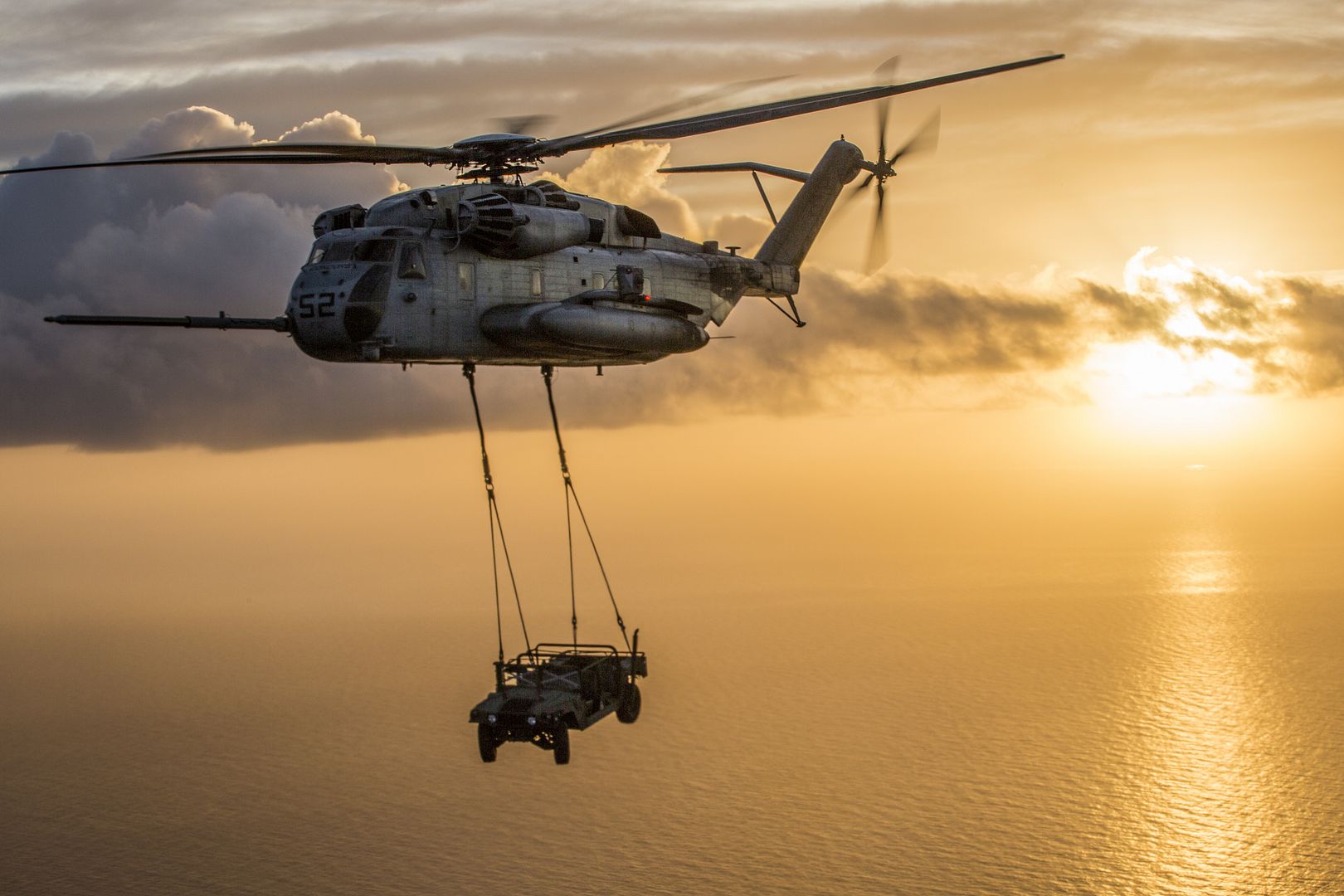
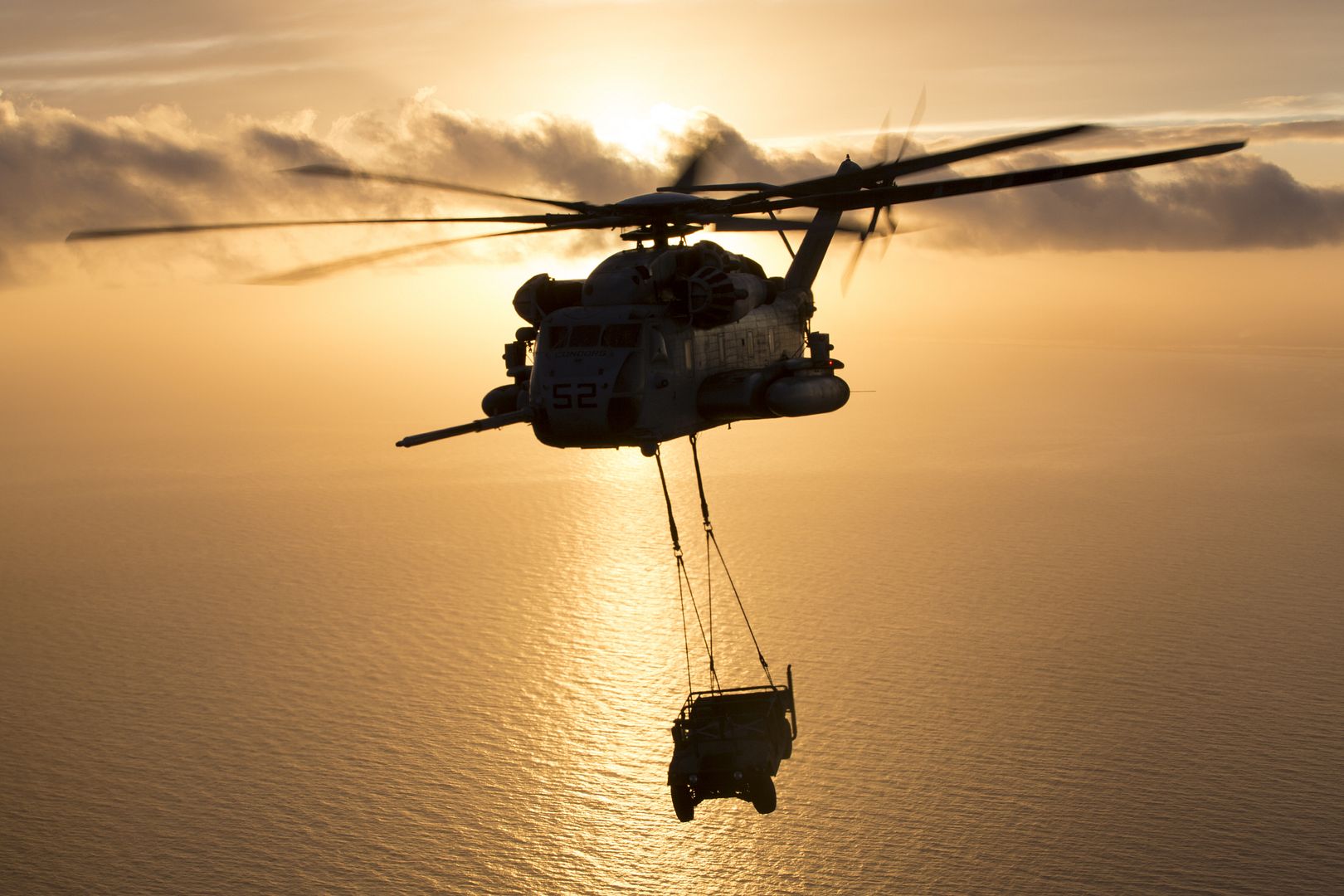
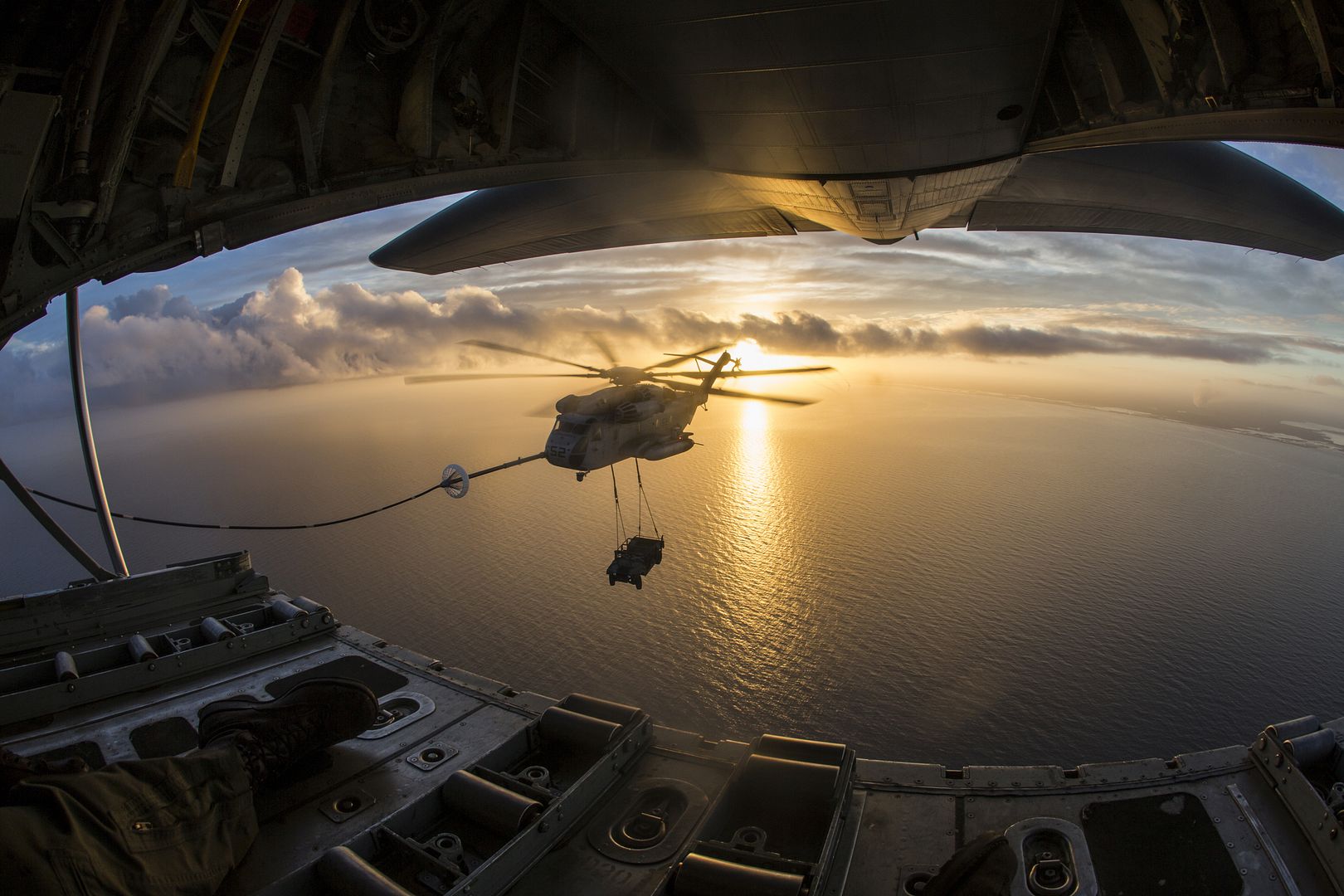
SOUTH CHINA SEA (Feb. 23, 2017) An F/A 18E Super Hornet from the ?Kestrels? of Strike Fighter Squadron (VFA) 137 makes an arrested landing on the aircraft carrier USS Carl Vinson (CVN 70) flight deck. The Carl Vinson Carrier Strike Group is on a regularly scheduled Western Pacific deployment as part of the U.S. Pacific Fleet-led initiative to extend the command and control functions of U.S. 3rd Fleet. U.S. Navy aircraft carrier strike groups have patrolled the Indo-Asia-Pacific regularly and routinely for more than 70 years. (U.S. Navy Photo by Mass Communication Specialist 3rd Class Matt Brown/Released)
-
 Main AdminA New Jersey Air National Guard KC-135 Stratotanker from the 108th Wing sits on the flightline awaiting maintenance at Joint Base McGuire-Dix-Lakehurst, N.J., Feb. 26, 2017. (U.S. Air National Guard photo by Master Sgt. Matt Hecht/Released)
Main AdminA New Jersey Air National Guard KC-135 Stratotanker from the 108th Wing sits on the flightline awaiting maintenance at Joint Base McGuire-Dix-Lakehurst, N.J., Feb. 26, 2017. (U.S. Air National Guard photo by Master Sgt. Matt Hecht/Released)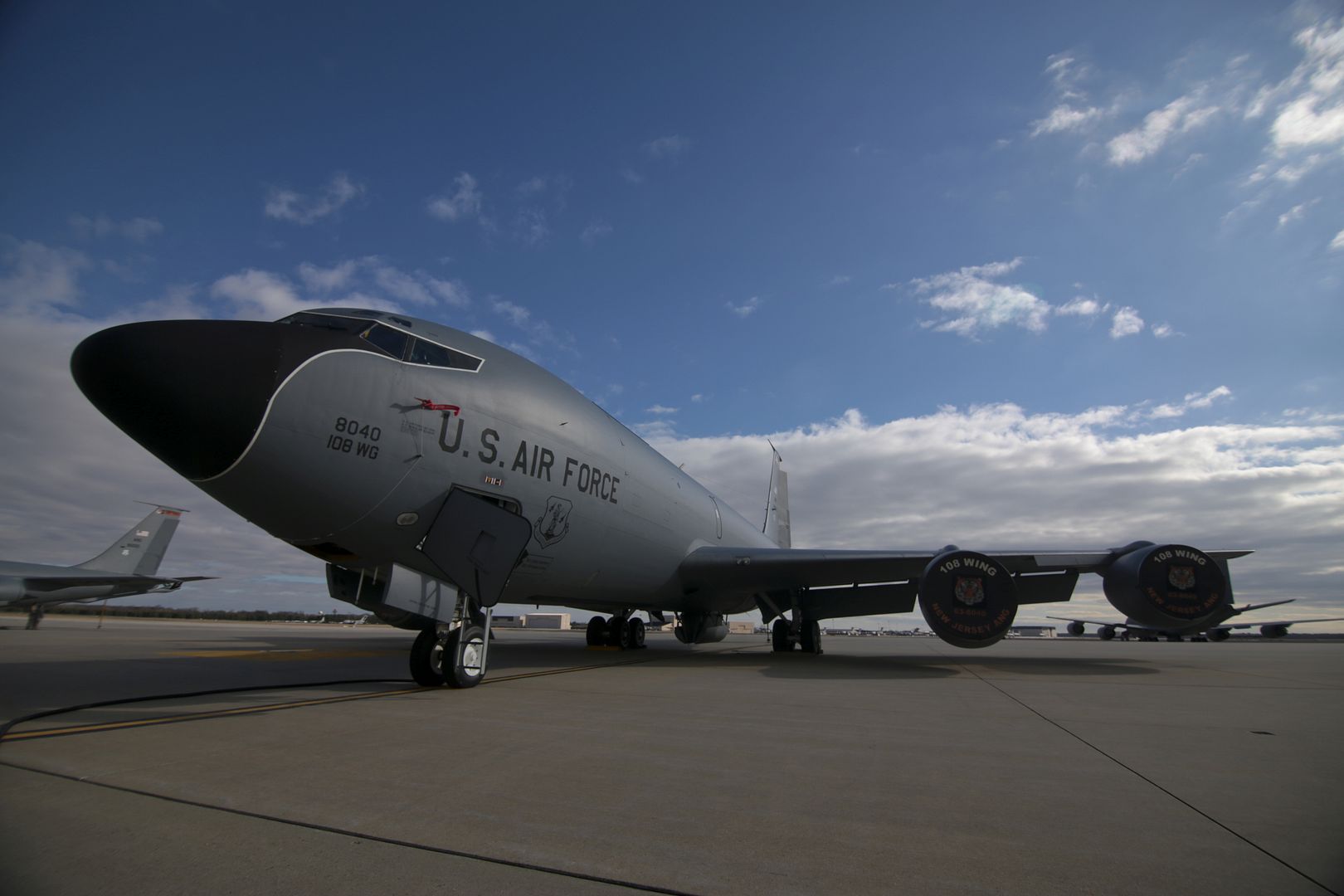
Edwards Air Force Base
Team tests concept demonstrator
The test team monitors the HEF during the C-17 portion of the Hybrid Electric Flightline Cart Technology Pathfinder tests. The HEF was a concept demonstrator built to explore an all-electric or hybrid electrical power supply for use by flightline maintainers. Some possible advantages are lower noise, less emissions and less maintenance than the diesel generators currently in use. (U.S. Air Force photo by Christopher Ball)
-
 Main Admin02.27.2017
Main Admin02.27.2017
A 99th Flying Training Squadron, Joint Base San Antonio-Randolph, Texas, T-1A Jayhawk flies along the Texas coast during a training mission. The 99th FTS conducts Pilot Instructor Training and continues the heritage of the Tuskegee Airmen with their distinctive red tail.
Photo by Randy Martin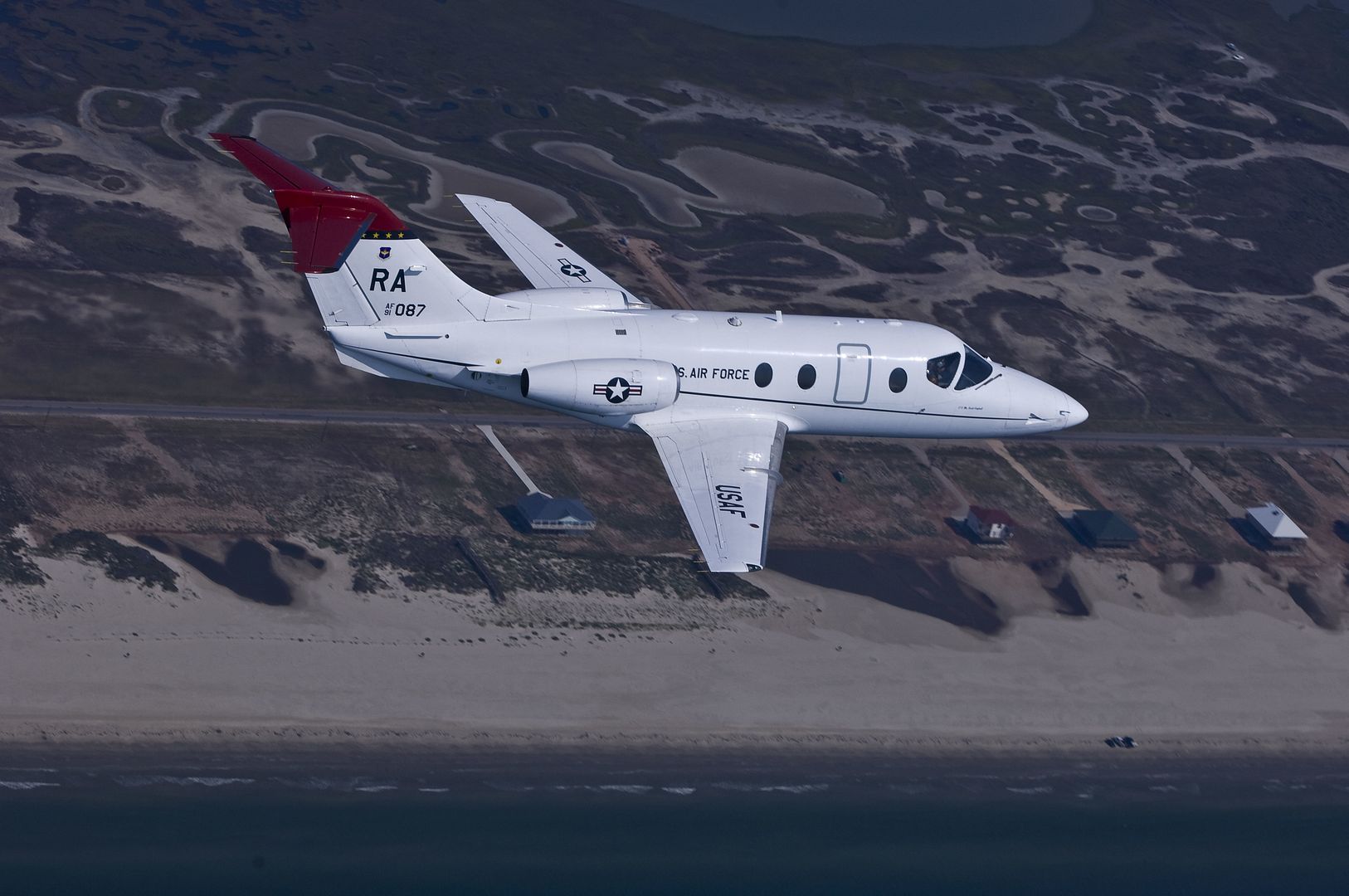
An MQ-1 Predator taxies under water from a fire hose during its final flight Feb. 27, 2017 at Holloman Air Force N.M. The MQ-1 Predator has provided many years of service and is being phased out of service as the Air Force transitions to the more capable MQ-9 Reaper. The MQ-1 Predator is an armed, multi-mission, medium-altitude, long-endurance remotely piloted aircraft that is employed primarily as an intelligence-collection asset and secondarily against dynamic execution targets. (U.S. Air Force Photo by Staff Sgt. Stacy Jonsgaard)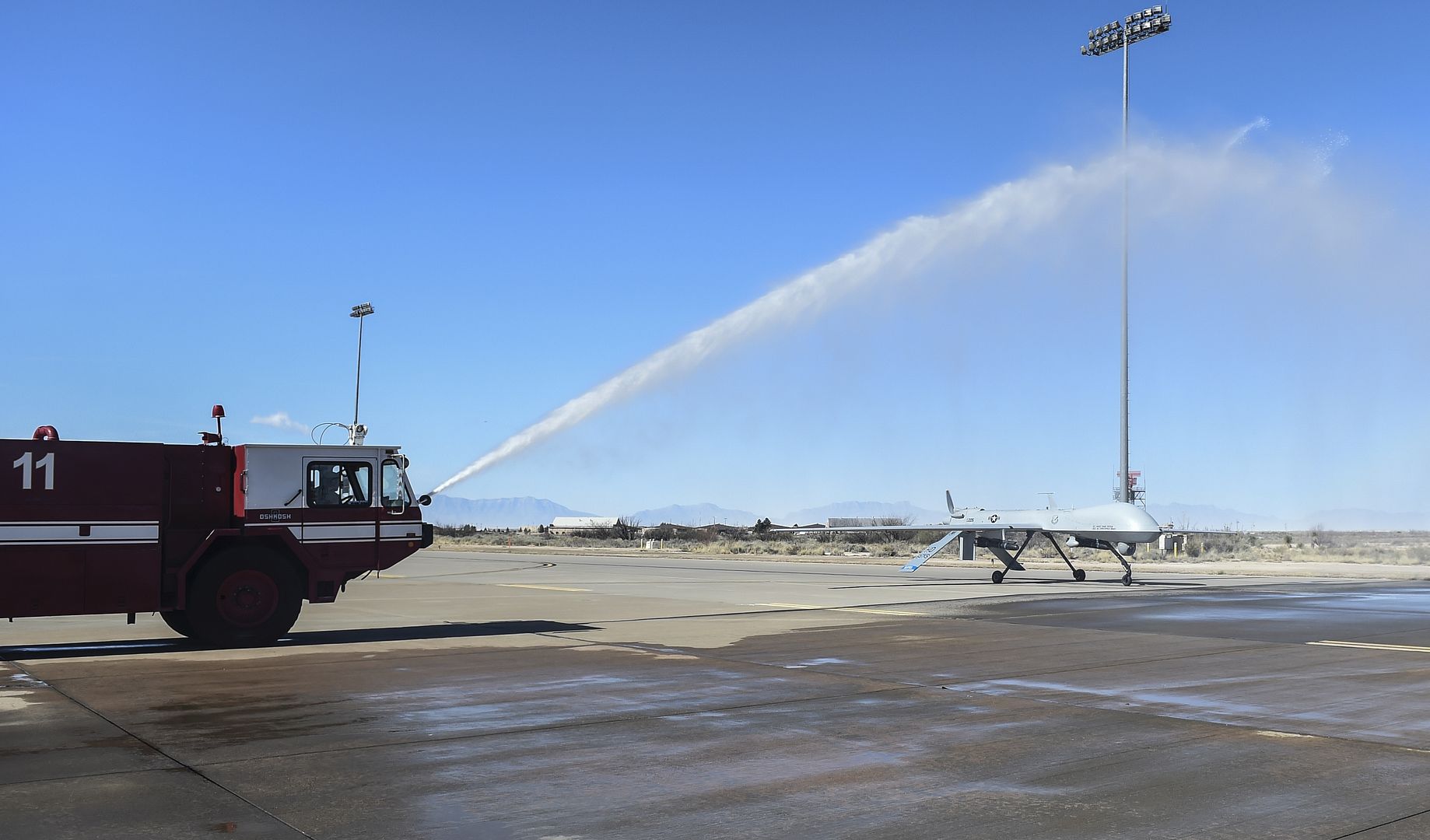
Two A-10 Thunderbolt IIs assigned to the 25th Fighter Squadron taxi out for a training mission during Exercise Beverly Herd 17-1 at Osan Air Base, Republic of Korea, Feb. 28, 2017. Beverly Herd is a routine training exercise held to increase the confidence, capabilities and cohesion of Team Osan forces to execute contingency operations. (U.S. Air Force photo by Staff Sgt. Victor J. Caputo)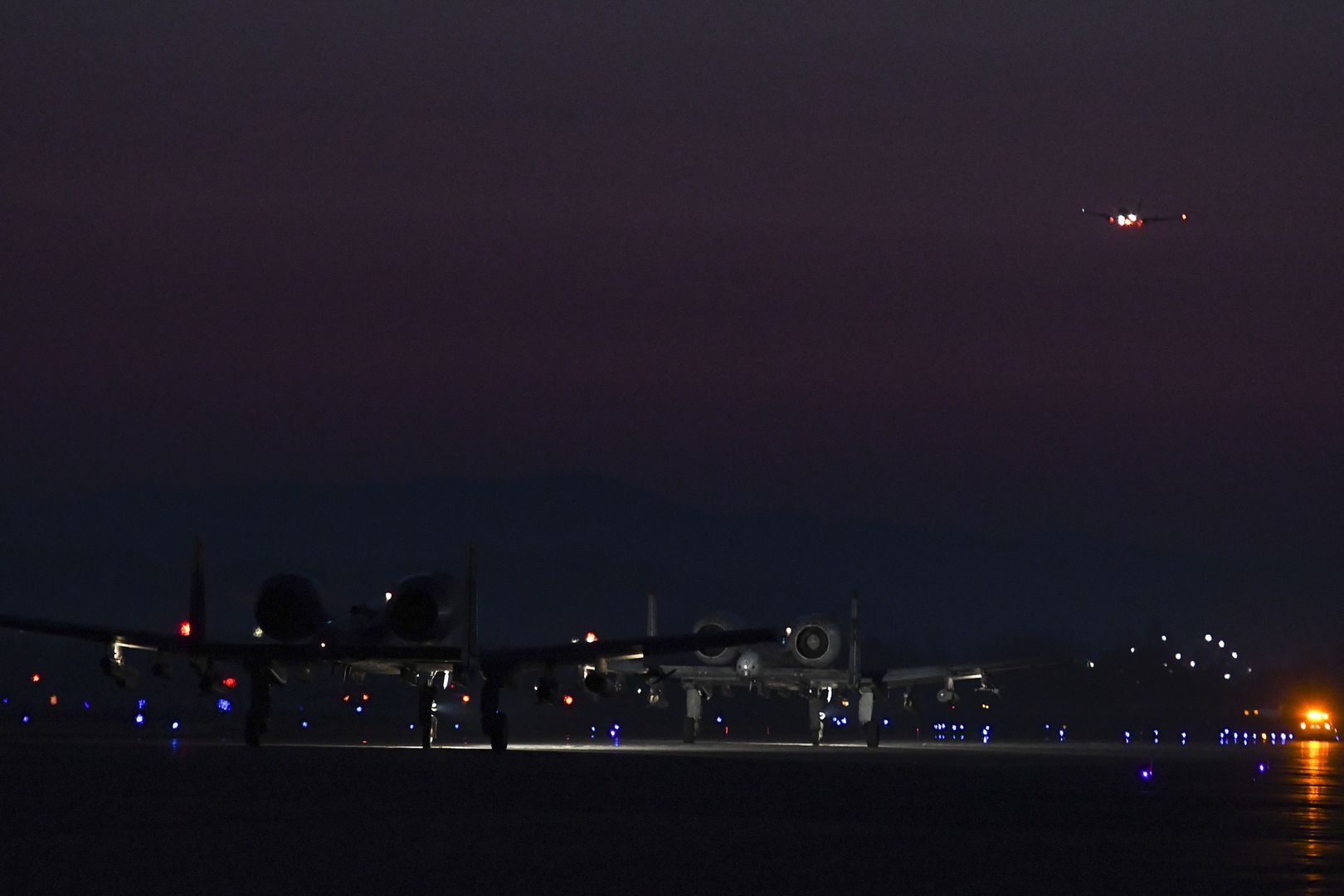
An F-16 Fighting Falcon assigned to the 36th Fighter Squadron takes off on a training mission during Exercise Beverly Herd 17-1 at Osan Air Base, Republic of Korea, Feb. 28, 2017. Beverly Herd provides ample training opportunities for Team Osan units to practice their ability to ?Fight Tonight? in a realistic setting. (U.S. Air Force photo by Staff Sgt. Victor J. Caputo)
28 February 2017 Press Release
With this latest delivery, Air Cara?bes becomes the first French airline to operate the A350 XWB. The aircraft, leased from AerCap, was delivered during a ceremony held at the Airbus Delivery Centre in Toulouse on 28 February. It will take off at 14:00 heading for Paris Orly Sud before embarking on its first commercial flight to Pointe-?-Pitre and Fort-de-France on 2 March.
This A350-900 can accommodate 389 passengers in a three-class configuration, (18 in Business, 45 in Premium Economy and 326 in Economy). The exceptional comfort and quietness of the ?Airspace by Airbus? cabin, combined with its new lighting system ? much appreciated by passengers for the way it reduces the effects of jet lag ? strengthen the sense of wellbeing and relaxation on long-haul flights.
Air Cara?bes plans to operate its A350 XWB alongside the A330s it already has in service on its Paris <> French Caribbean routes.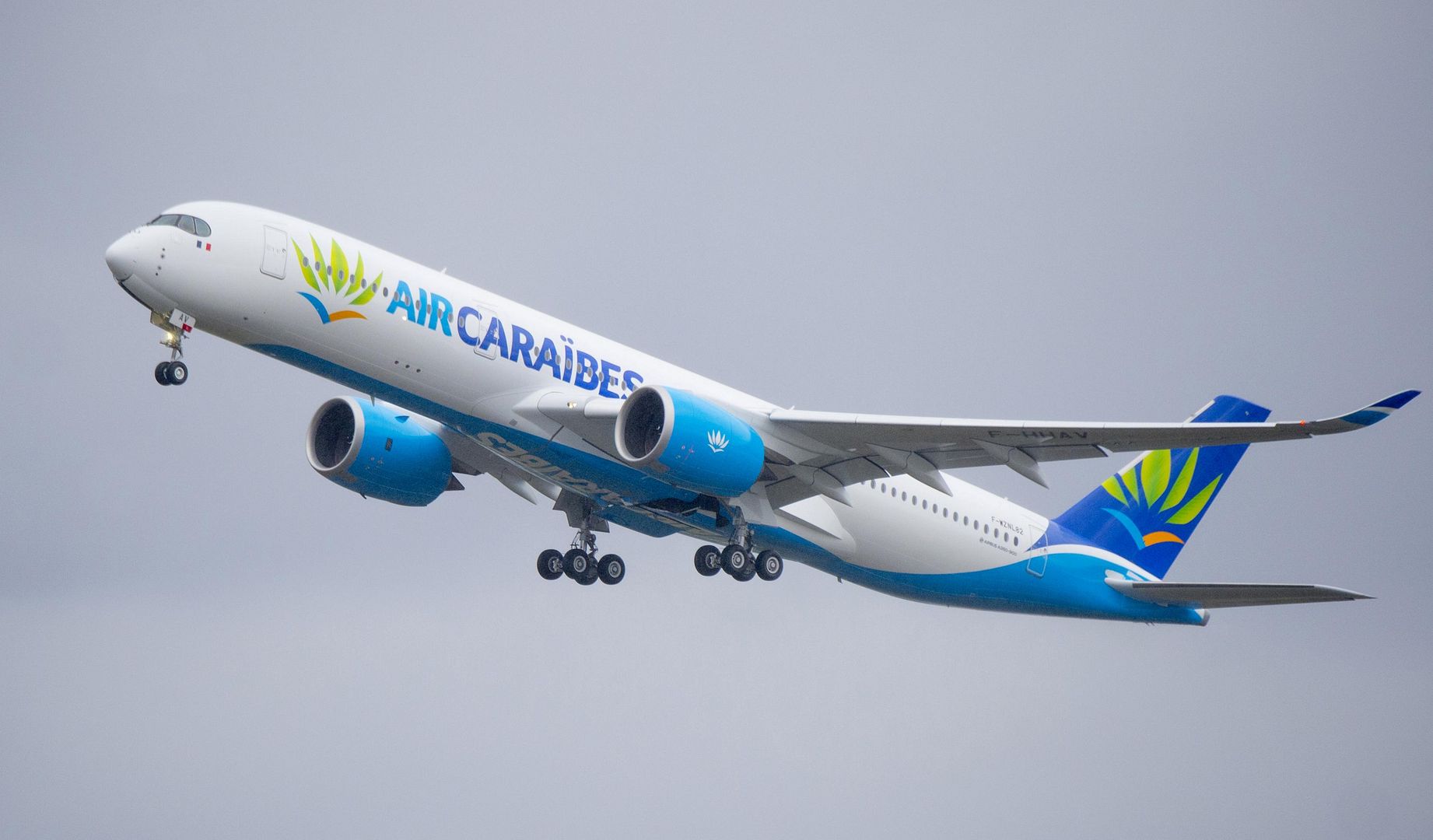
The A350 XWB benefits from the latest technological and aerodynamic innovations offering an unprecedented level of operational efficiency while significantly cutting its environmental footprint. Its fuselage and wings are made of carbon fibre and it is powered by the new-generation Rolls-Royce Trent XWB engines.
To date, orders for 821 A350 XWBs have been placed with Airbus by 44 customers around the world, making this one of the most successful programmes ever in the long-range aircraft segment.
News Article / February 27, 2017
About 200 Canadian Armed Forces (CAF) personnel are participating in Operation Nunalivut 2017. The annual surveillance and control operation in the High Arctic takes place this year in Resolute Bay and Hall Beach, Nunavut, from February 23 to March 10, 2017.
Operation Nunalivut began in 2007 to provide the CAF with an opportunity to operate in the northernmost regions of Canada and to enhance the CAF?s capability to respond to a variety of situations in northern Canada.
Commanded by Joint Task Force (North), Task Force Nunalivut comprises personnel from the Canadian Army, the Royal Canadian Navy and the Royal Canadian Air Force.
The Royal Canadian Air Force?s CC-177 Globemaster and CC-130J Hercules transported people, supplies, and equipment to Hall Beach from Yellowknife and Quebec City. In addition, a CC-138 Twin Otter is deployed to Hall Beach to provide local air transport.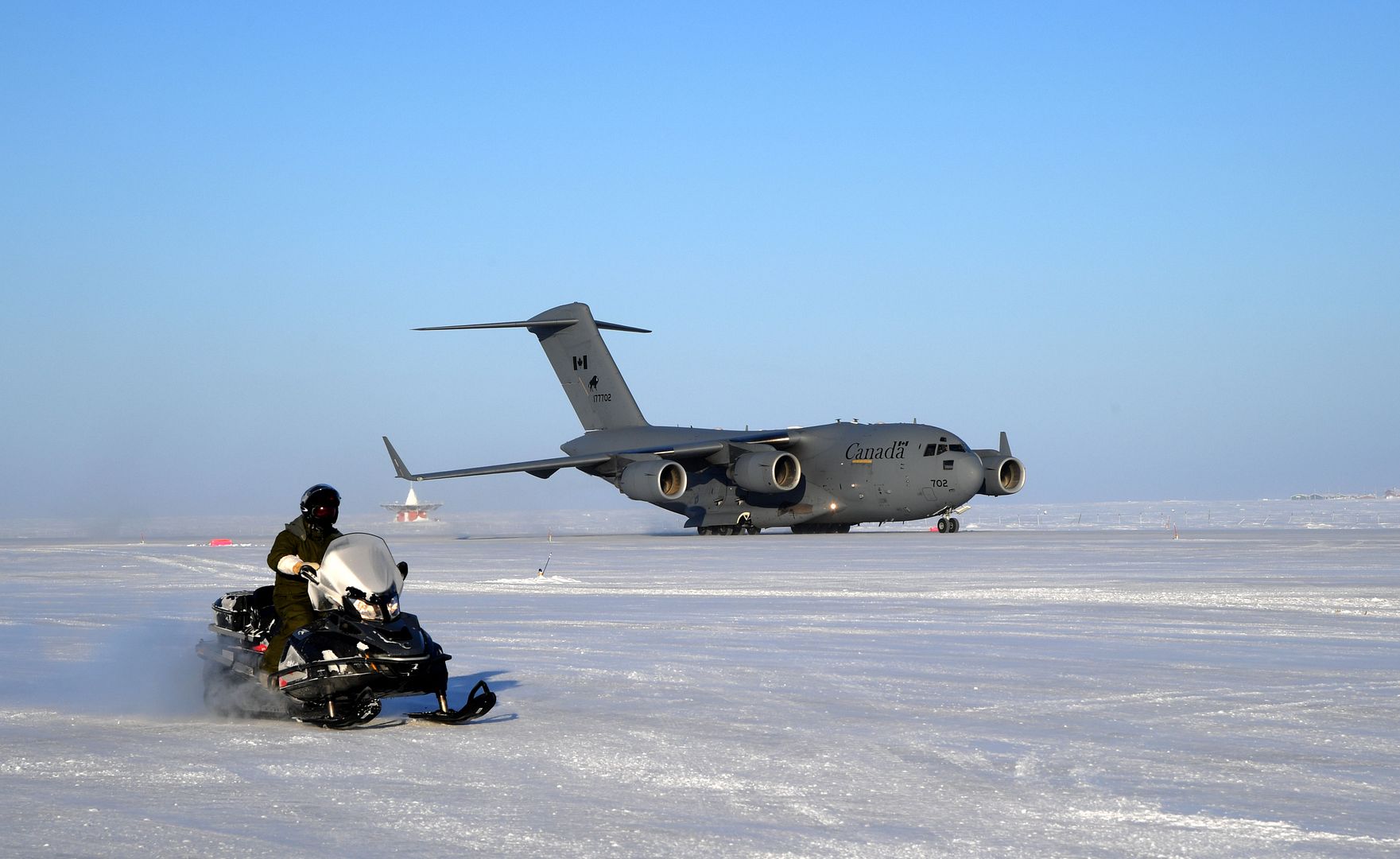
?Operation Nunalivut 2017 will be a challenging deployment into the harsh climate of the High Arctic by both Regular and Reserve members of the Canadian Armed Forces during the coldest period of the year,? said Brigadier-General Mike Nixon, the commander of Joint Task Force (North). ?Aside from exercising the capacity to deploy to and operate tactically in the High Arctic, Operation Nunalivut will provide the opportunity to test equipment and training methods while demonstrating a Northern presence.?
Canadian Army participants include members from 12e R?giment blind? du Canada as the Immediate Reaction Unit, a composite group of soldiers from 34 and 35 Canadian Brigade Group as the Arctic Response Company Group, and the 1st Canadian Ranger Patrol Group, which will conduct Arctic survival training and sovereignty patrols in Hall Beach.
Members from the Royal Canadian Navy?s Fleet Diving Unit Atlantic, with combat divers from across Canada, and the Royal Canadian Mounted Police (RCMP) Dive Unit, will conduct ice diving operations in Resolute Bay.
During the operation, Task Force Nunalivut will work with other government departments and agencies, such as the RCMP, as well as local and territorial governments.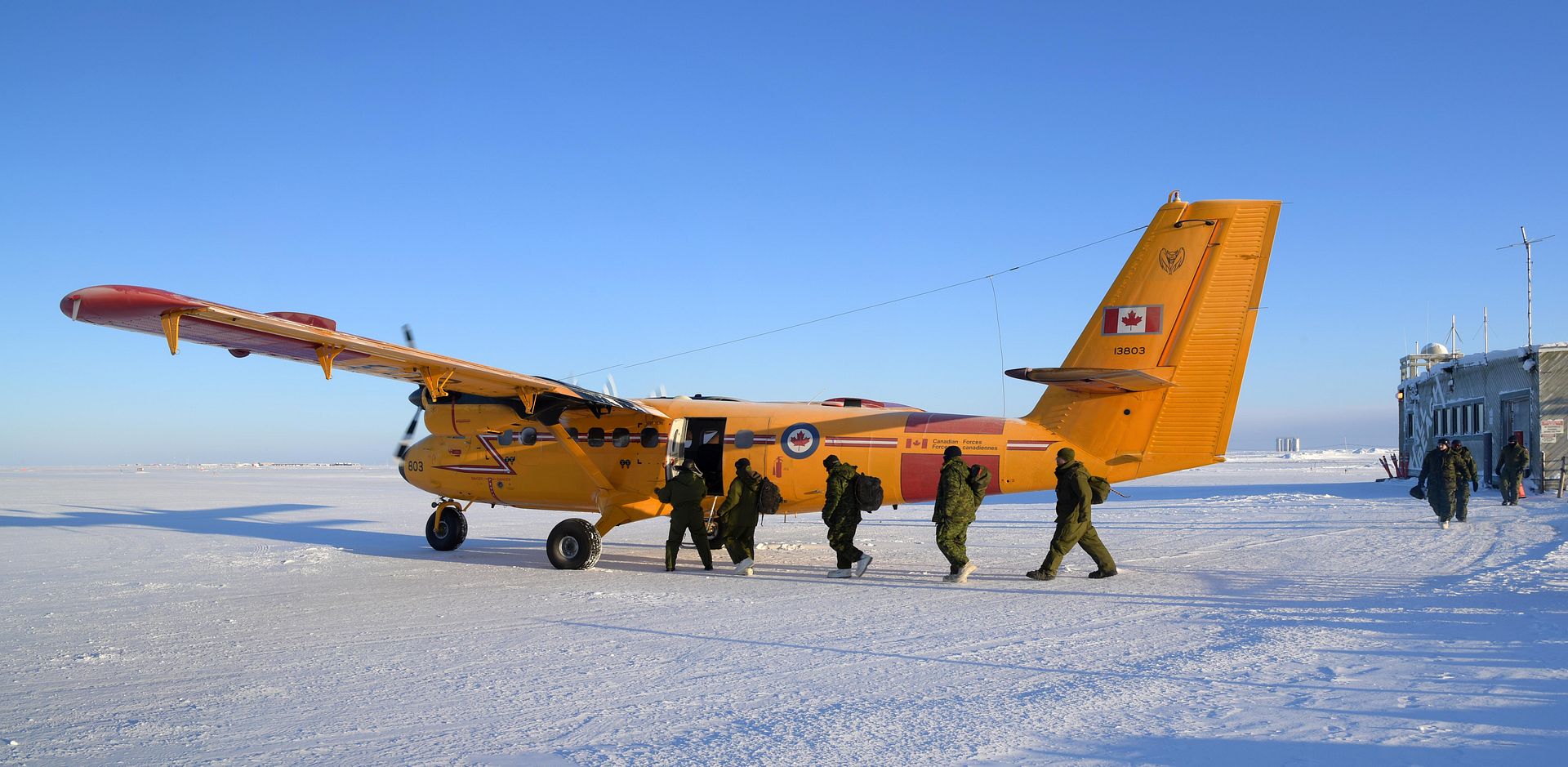
-
 Main AdminF-16CM Fighting Falcons assigned to the 20th Fighter Wing sit on the flightline after arriving at Red Flag 17-2 at Nellis Air Force Base, Nev., Feb. 24, 2017. Red Flag is a realistic combat exercise involving U.S. and Allied air forces conducting training operations on the 15,000 square mile Nevada Test and Training Range. (U.S. Air Force photo by Senior Airman Zade Vadnais)
Main AdminF-16CM Fighting Falcons assigned to the 20th Fighter Wing sit on the flightline after arriving at Red Flag 17-2 at Nellis Air Force Base, Nev., Feb. 24, 2017. Red Flag is a realistic combat exercise involving U.S. and Allied air forces conducting training operations on the 15,000 square mile Nevada Test and Training Range. (U.S. Air Force photo by Senior Airman Zade Vadnais)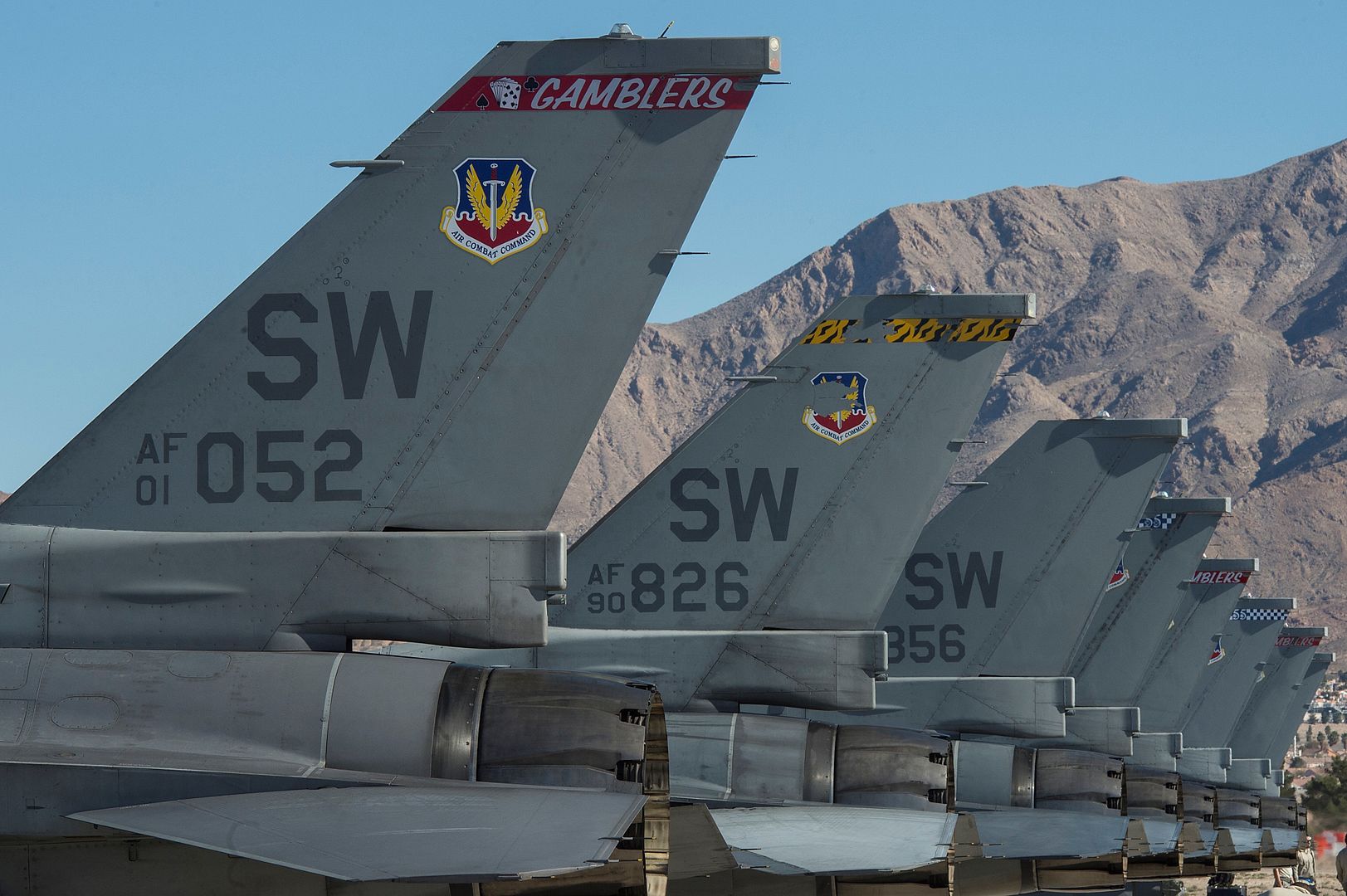
A 428th Fighter Squadron aircraft lands at Mountain Home Air Force Base, Idaho, Feb. 28, 2017. During the exercise agencies practiced scenarios particular to their career field to test their readiness capabilities.(U.S. Air Force photo by Senior Airman Connor J. Marth)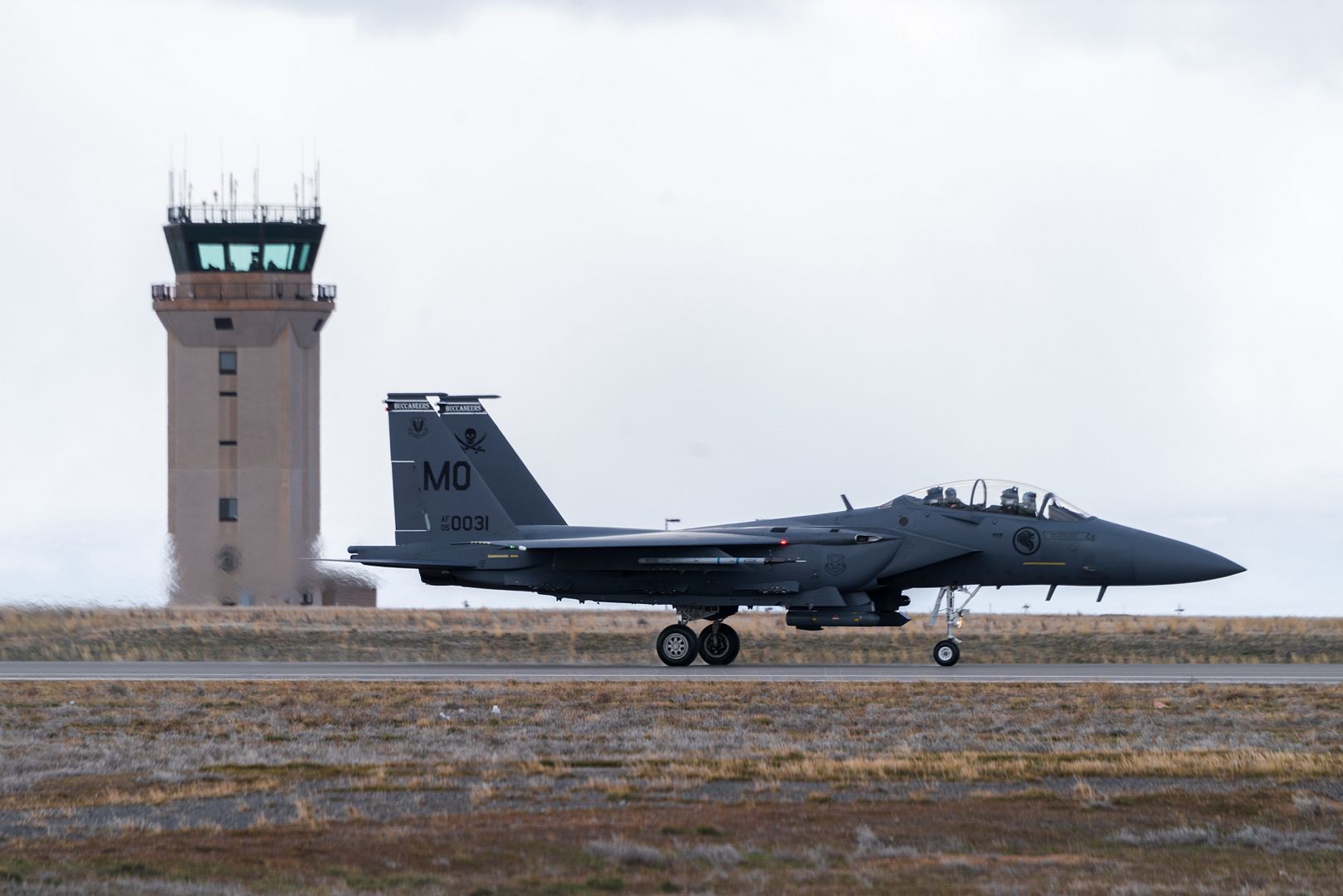
A 428th Fighter Squadron pilot flies over the flight line at Mountain Home Air Force Base, Idaho, Feb. 28, 2017. Agencies across base participated in a base-wide exercise to practice readiness. (U.S. Air Force photo by Senior Airman Connor J. Marth)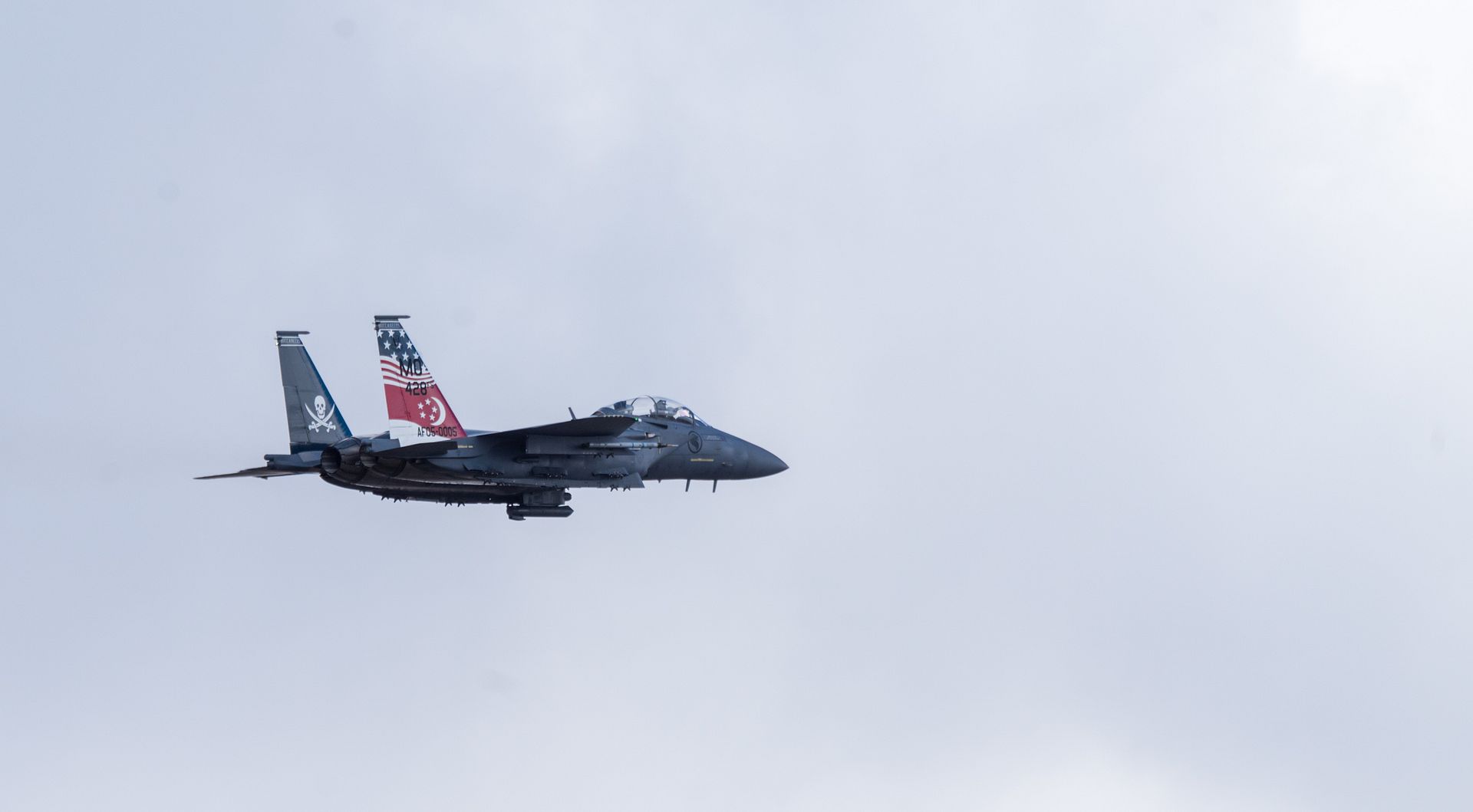
PACIFIC OCEAN (Feb. 26, 2017) An F/A-18E Super Hornet assigned to the ?Eagles? of Strike Fighter Squadron (VFA) 115 conducts aerial refueling operations with a U.S. Air Force KC-10A Extender. VFA-115 is traveling from Naval Air Facility Atsugi, Japan, to Naval Air Station Fallon, Nevada, to complete the strike fighter advanced readiness program. (U.S. Navy photo's by Lt. Chris Pagenkopf/Released)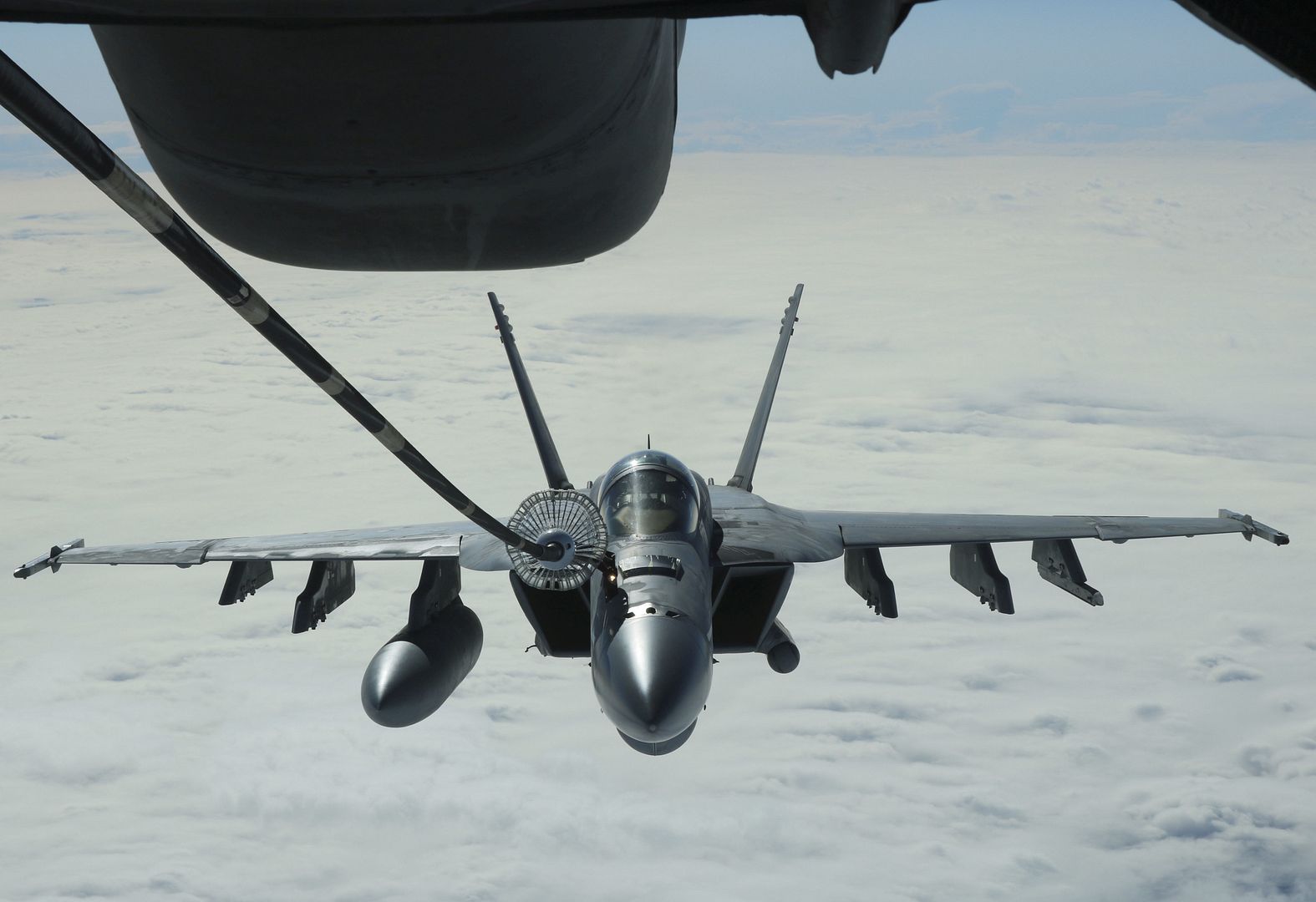
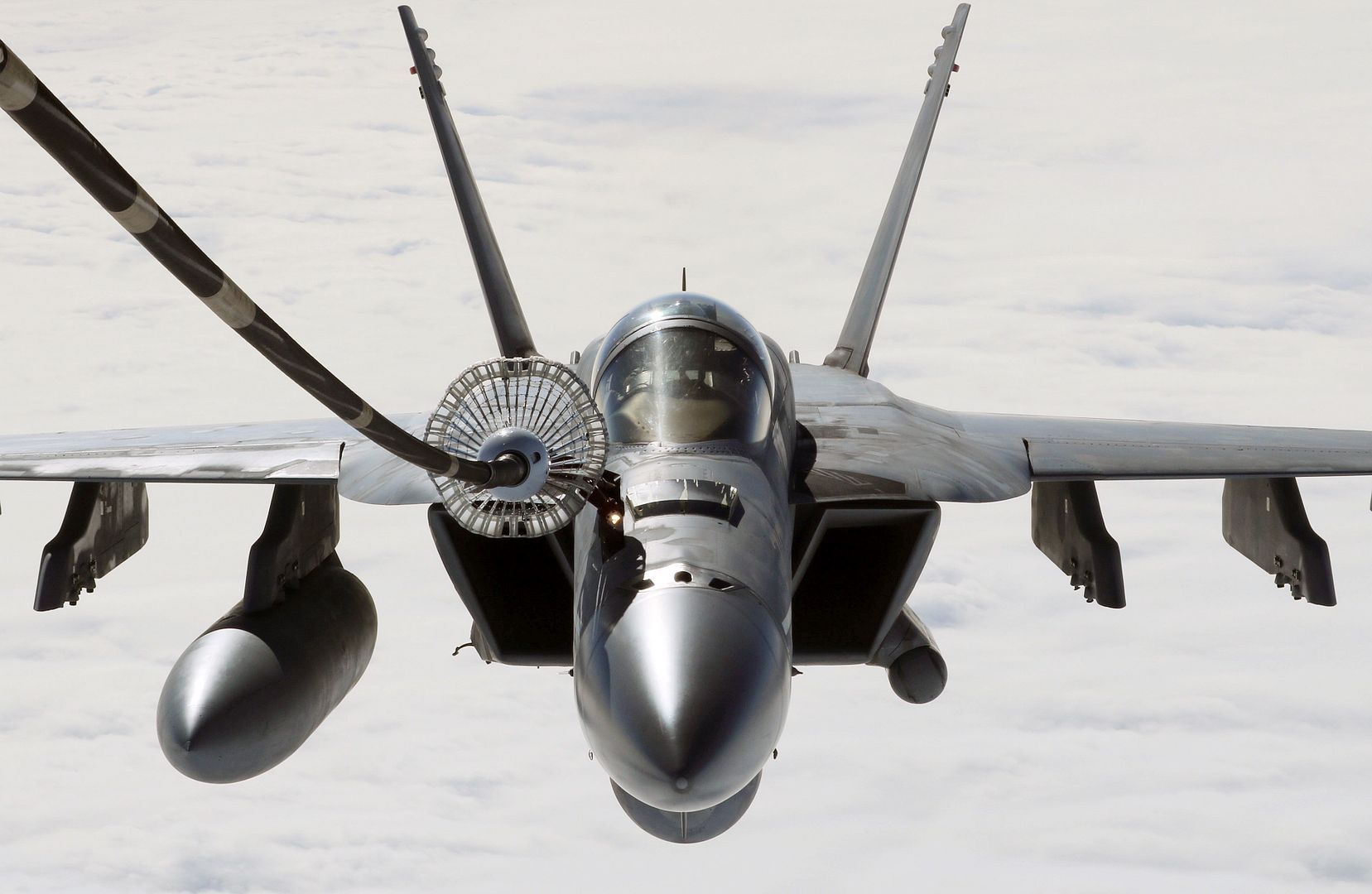
Japan Air Self-Defense Force Majs. Koji Yokoyama and Shuji Onodera, 404th Squadron pilots, fly a KC-767 during an aerial refueling mission at Cope North 17, Feb. 28, 2017. The exercise includes 22 total flying units and more than 2,700 personnel from three countries and continues the growth of strong, interoperable relationships within the Indo-Asia-Pacific region through integration of airborne and land-based command and control assets. (U.S. Air Force Photo by Senior Airman Keith James)
An A-10 Thunderbolt II assigned to the 25th Fighter Squadron takes off for a training mission during Exercise Beverly Herd 17-1 at Osan Air Base, Republic of Korea, March 1, 2017. Exercises like Beverly Herd allow the 51st Fighter Wing to work out the muscle movements required to execute and sustain combat operations in the ROK. (U.S. Air Force photo by Staff Sgt. Victor J. Caputo)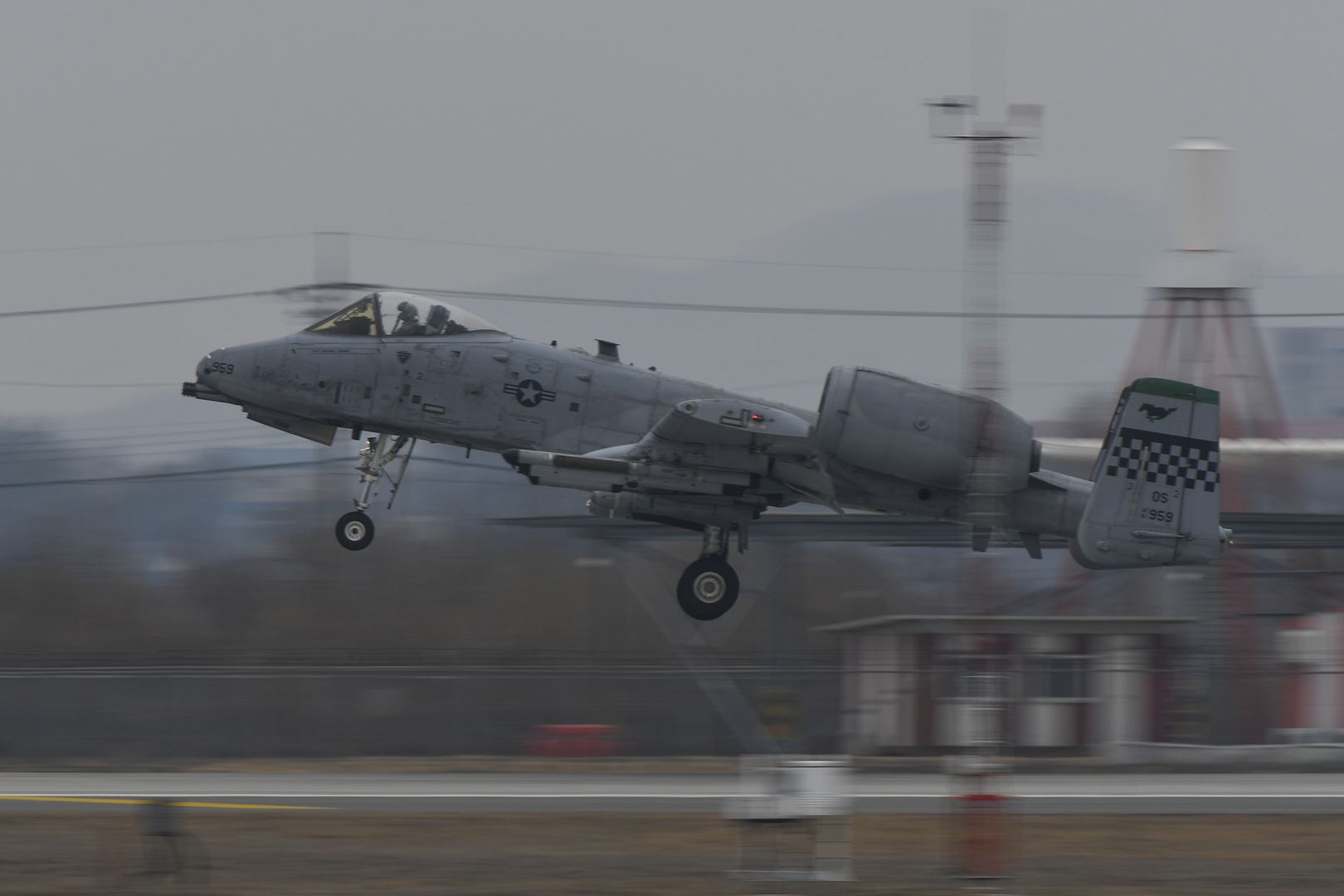
An F-16 Fighting Falcon assigned to the 36th Fighter Squadron taxis to the runway for a training mission while an A-10 Thunderbolt II from the 25th Fighter Squadron takes off during Exercise Beverly Herd 17-1 at Osan Air Base, Republic of Korea, March 1, 2017. Pilots from both fighter squadrons flew multiple sorties during exercise Beverly Herd, honing their flying skills and ability to work around the rugged ROK landscape. (U.S. Air Force photo by Staff Sgt. Victor J. Caputo)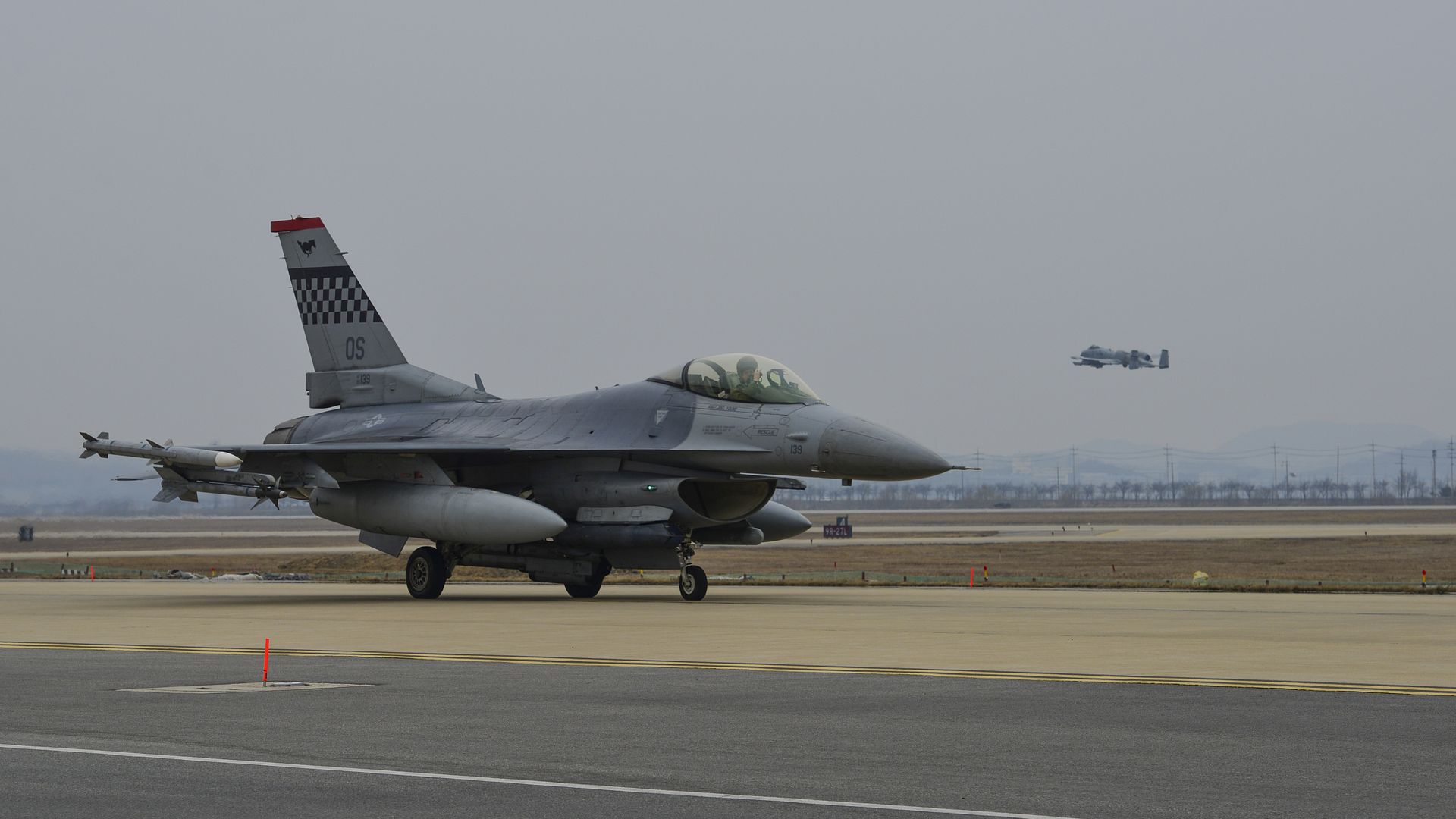
An Air Mobility Command C-5M Super Galaxy lands at Riga International Airport, Latvia, Mar. 1, 2017, to deliver UH-60 Black Hawk helicopters for the U.S. Army in support of Operation Atlantic Resolve. Five Black Hawk helicopters will be deployed to Latvia as part of a larger contingent of helicopters and personnel deployed to support Operation Atlantic Resolve, a U.S. commitment to maintaining peace and stability in the European region. (U.S. Air Force photo/Tech. Sgt. Ryan Crane)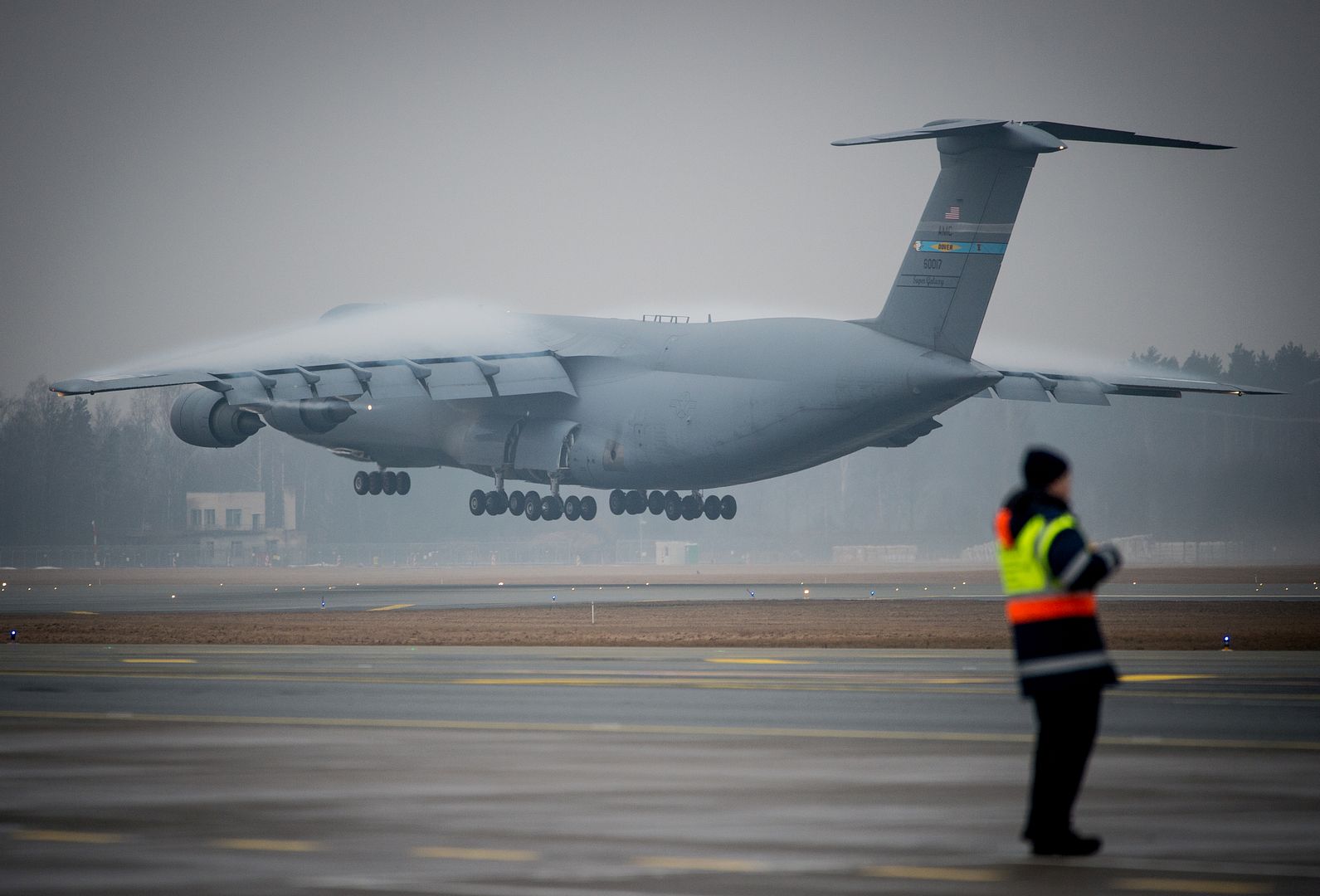
(Source: Australian Department of Defence; dated March 1, 2017)
Minister for Defence, Senator the Hon Marise Payne, today welcomed the first EA-18G Growler electronic attack aircraft to the Royal Australian Air Force.
Flying into the Australian International Airshow at Avalon from Naval Air Station Whidbey Island in the United States, the Growlers are a potent and technologically advanced new capability for the Australian Defence Force.
Minister Payne said the Growler was a true force-multiplier.
?The Growler can disrupt military electronic systems, such as radars, to protect personnel and improve situational awareness,? Minister Payne said.
?Australia is the only country outside the United States flying the EA-18G Growler and its arrival is a significant leap forward in Australia?s joint electronic warfare capability and introduces a dedicated electronic attack option,? Minister Payne said.
Minister Payne today also announced that Australia will partner with the United States to develop a next-generation radar and radio jammer for the Growler.
?This is a $250m investment by the Turnbull Government that will future proof the Growler?s capability,? Minister Payne said.
?As this is a rapidly evolving area we will work in partnership with the United States Navy to develop the next generation jamming capability, which will ensure that these aircraft remain at the technological forefront throughout their service life.?
The Chief of Air Force, Air Marshal Leo Davies, said the Growler was a vital part of Air Force?s evolution to a future fifth-generation Air Force.
?The EA-18G Growler will operate as part of our networked and integrated force, capable of sharing electronic intelligence, surveillance and reconnaissance data with other aircraft, as well as with the Army and Navy.
?The Growler is powerful and flexible. It can undertake a range of non-kinetic tasks, ranging from jamming, to blocking radar displays, and suppressing an adversary?s air defence system,? Air Marshal Davies said.
Australia has purchased 12 EA-18G Growlers, which will be delivered to RAAF Base Amberley in Queensland by the middle of 2017.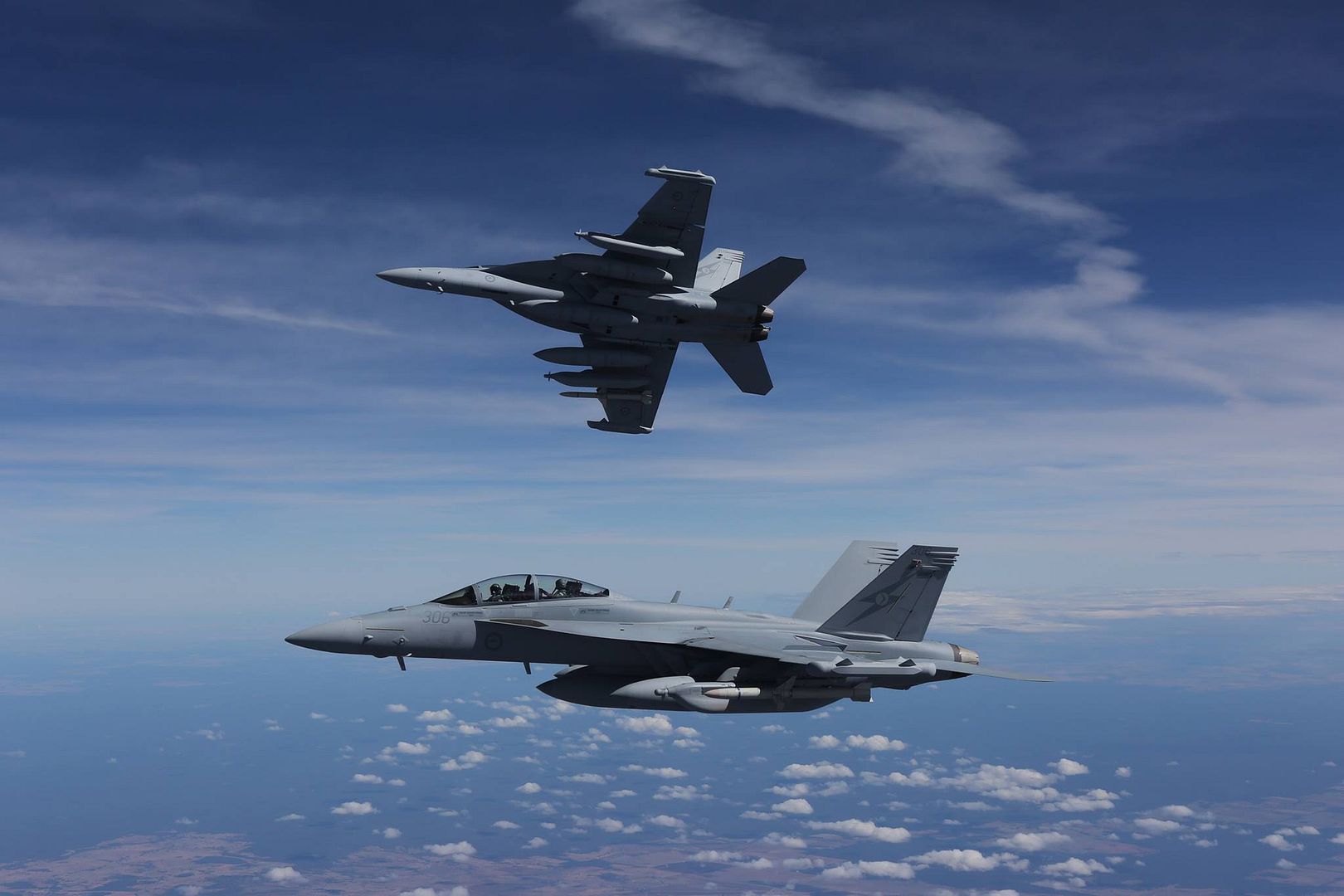
-
 Main AdminU.S. Air Force F-16 Fighting Falcons, assigned to the 18th Aggressor Squadron, fly in formation next to a 909th Air Refueling Squadron KC-135 Stratotanker March 1, 2017, off the coast of Guam. Twenty-two flying units from U.S. Pacific Command, Japan Air Self-Defense Force and the Royal Australian Air Force are in Andersen Air Force Base, Guam, to participate in annual exercise Cope North. (U.S. Air Force photo by Senior Airman John Linzmeier)
Main AdminU.S. Air Force F-16 Fighting Falcons, assigned to the 18th Aggressor Squadron, fly in formation next to a 909th Air Refueling Squadron KC-135 Stratotanker March 1, 2017, off the coast of Guam. Twenty-two flying units from U.S. Pacific Command, Japan Air Self-Defense Force and the Royal Australian Air Force are in Andersen Air Force Base, Guam, to participate in annual exercise Cope North. (U.S. Air Force photo by Senior Airman John Linzmeier)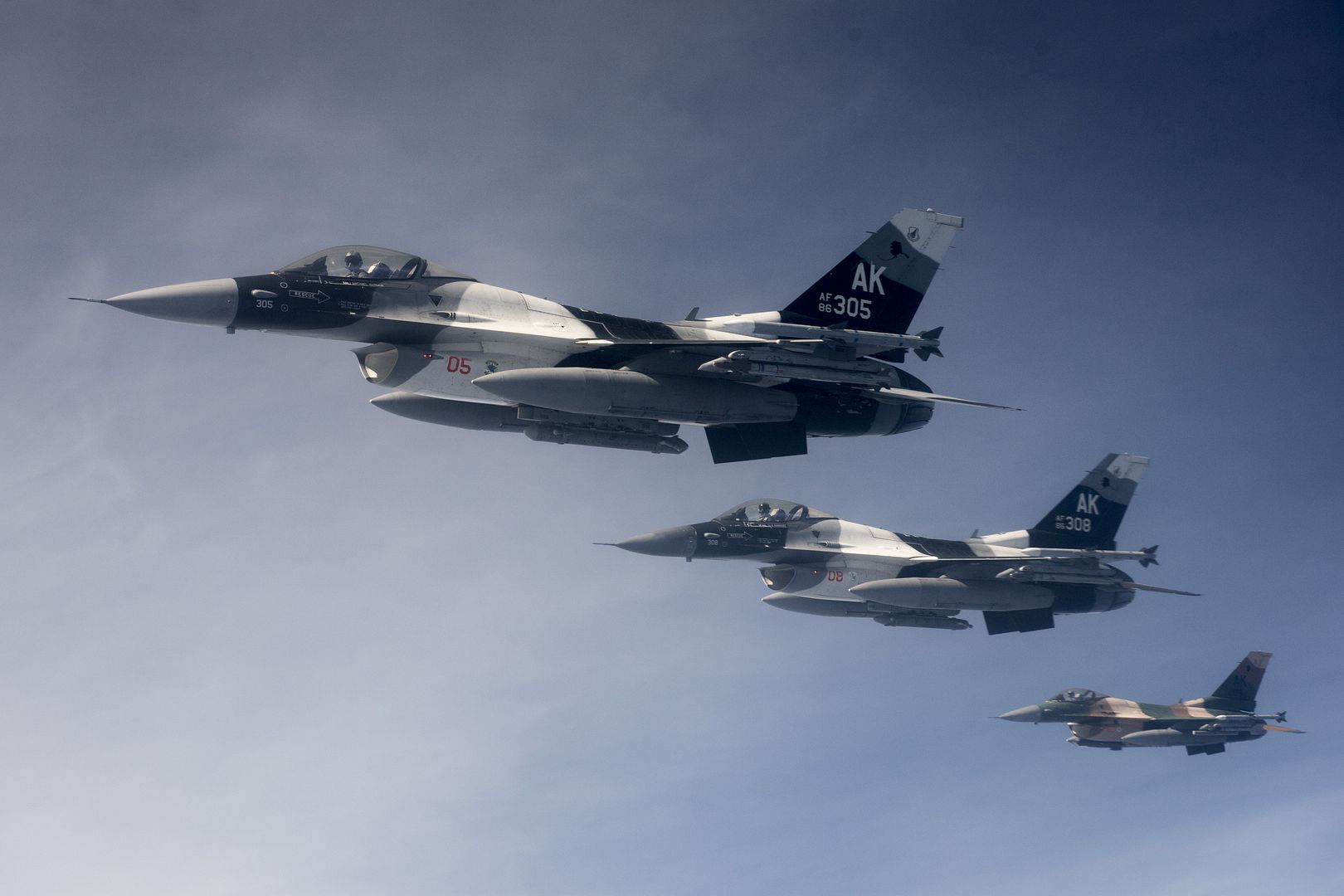
A U.S. Air Force F-16 Fighting Falcon, assigned to the 18th Aggressor Squadron, receives fuel from a 909th Air Refueling Squadron KC-135 Stratotanker March 1, 2017 off the coast of Guam. Both aircraft units are training among Japan Air Self-Defense Force, Royal Australian Air Force and other U.S. Pacific Command units to participate in exercise Cope North to increase humanitarian, disaster relief, and combat interoperability between the nations. (U.S. Air Force photo by Senior Airman John Linzmeier)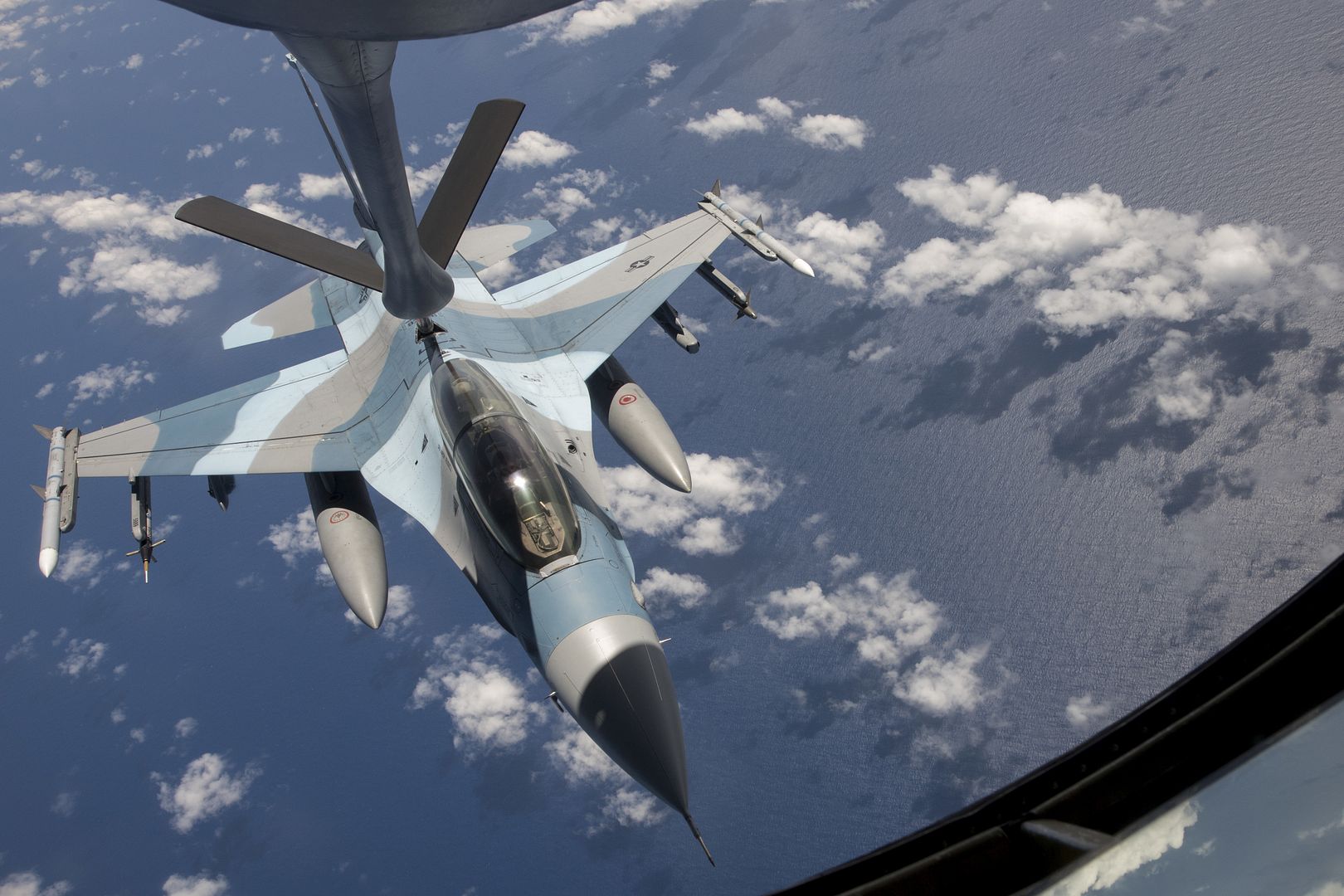
A National Reconnaissance Office payload on a United Launch Alliance Atlas V rocket, launches from Space Launch Complex-3, March 1, 2017, Vandenberg Air Force Base, Calif. (U.S. Air Force photo's by Senior Airman Ian Dudley/Released)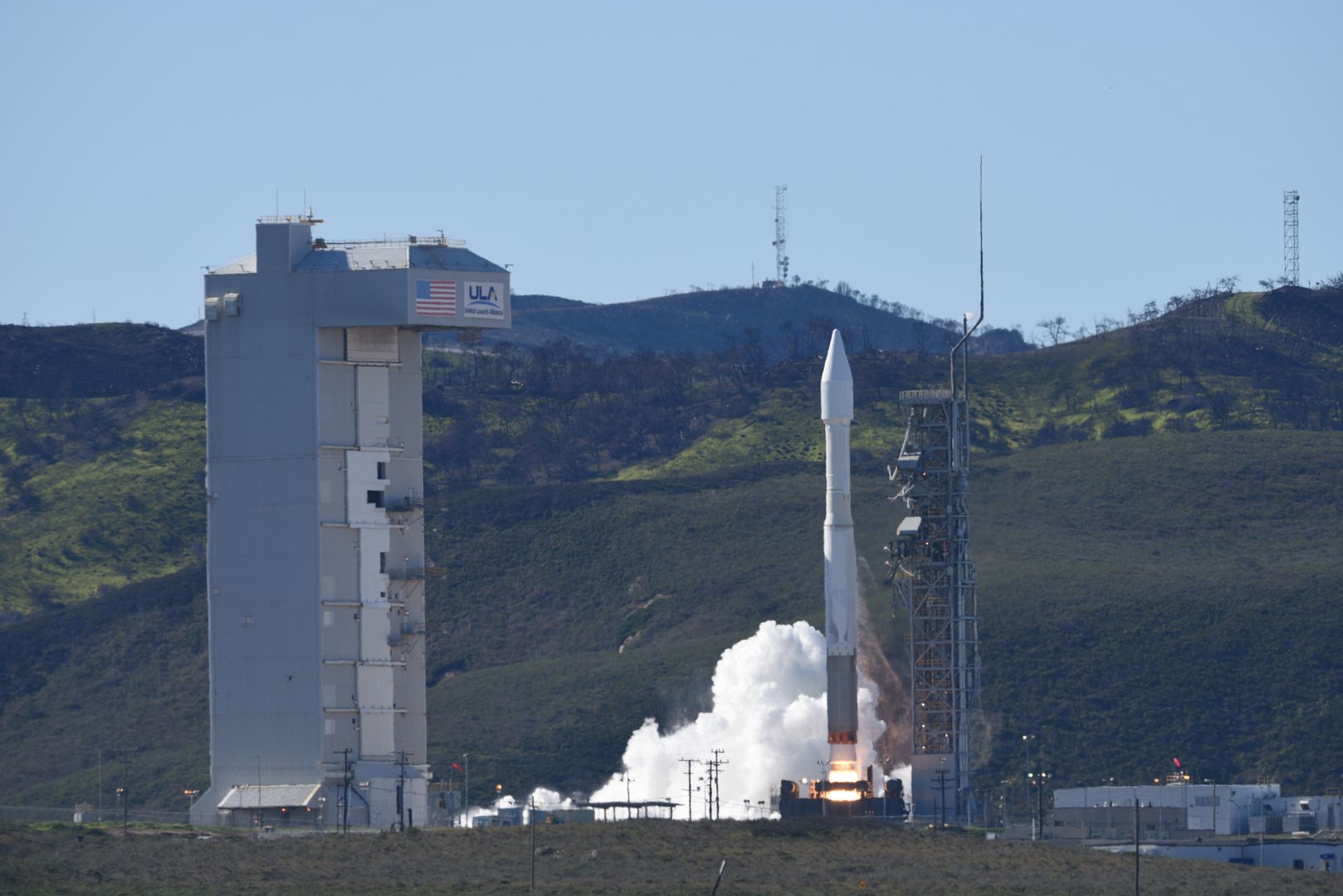
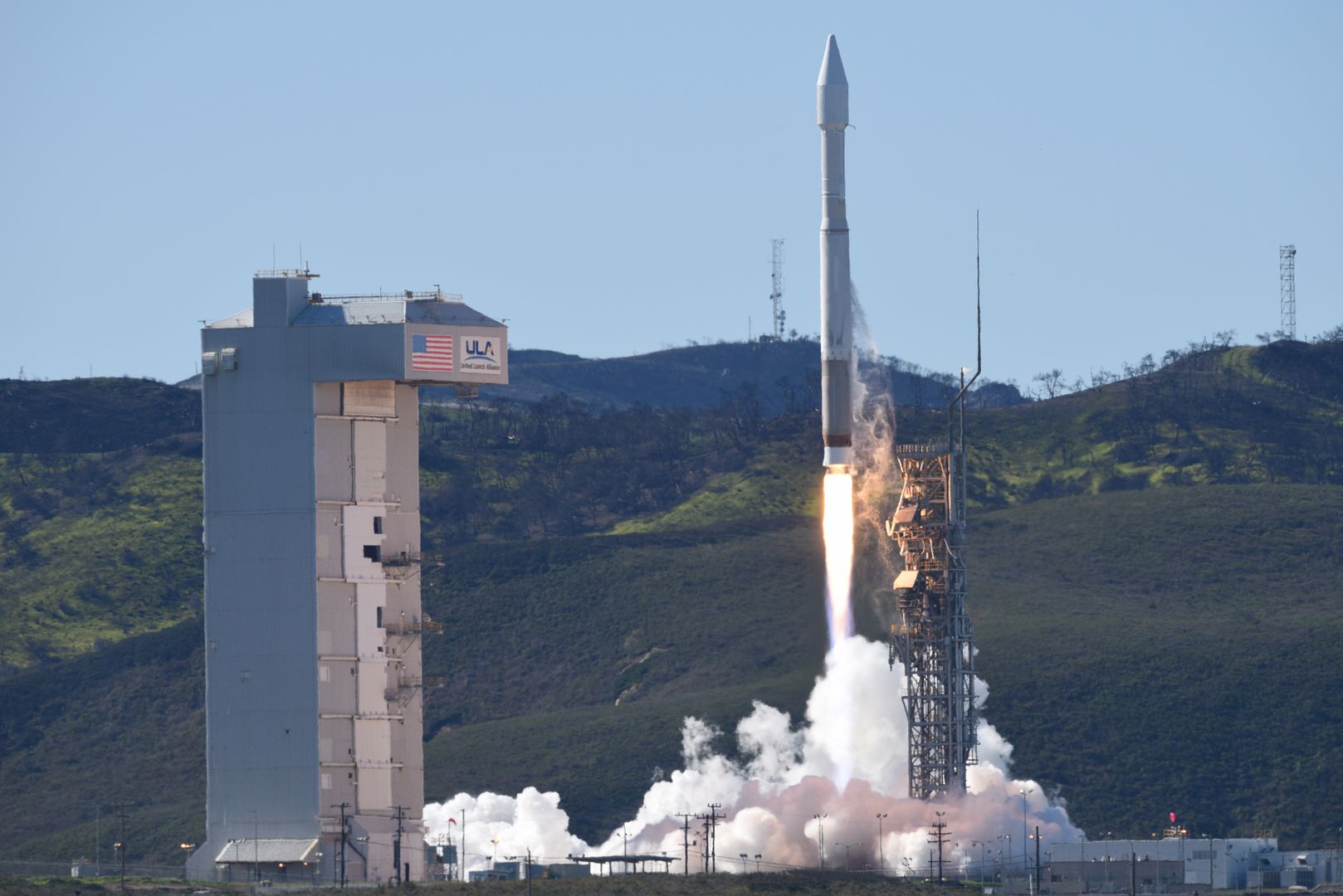
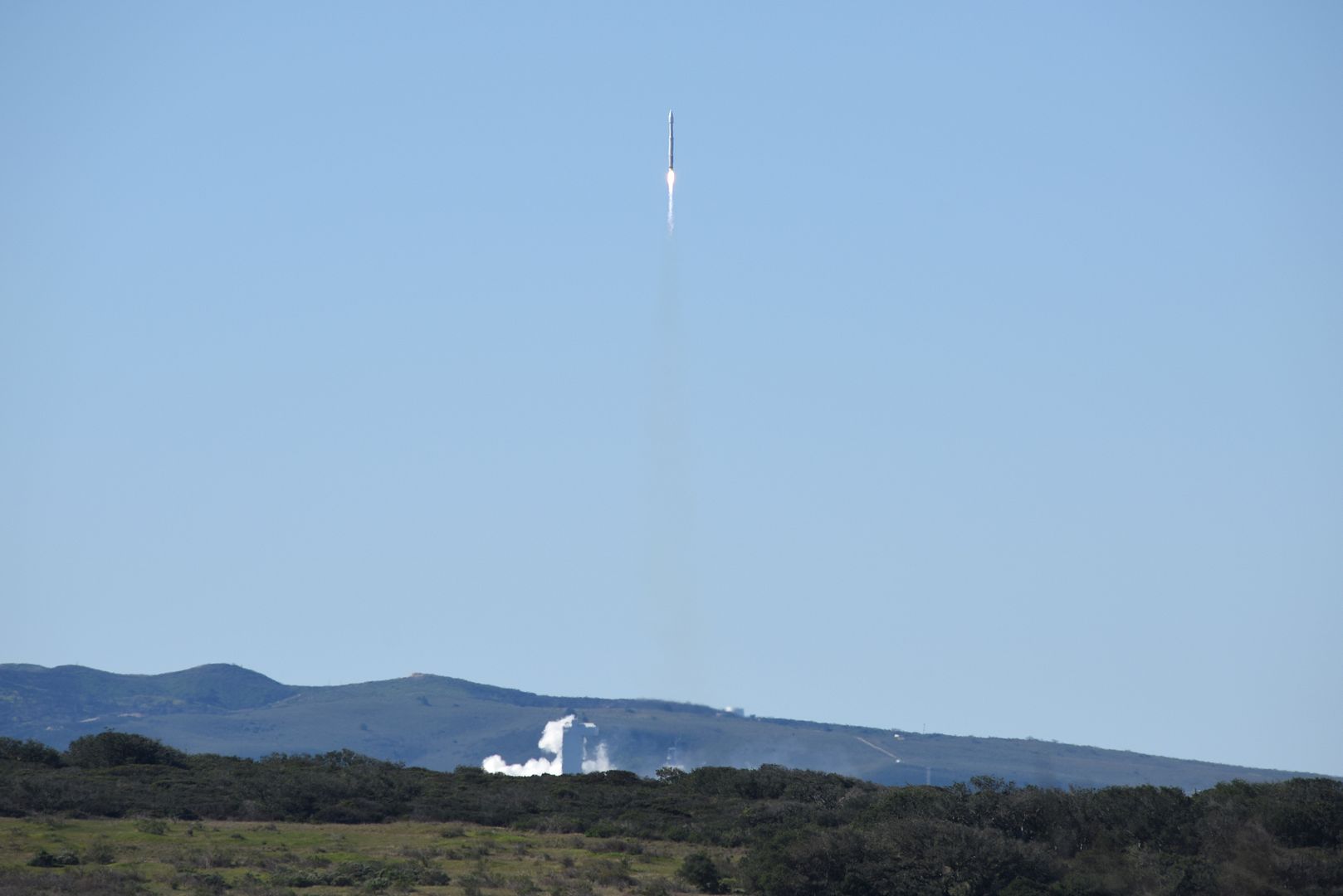
A 44th Fighter Squadron F-15C Eagle flies through the sky Mar. 2, 2017, at Kadena Air Base, Japan. Pilots bear the responsibility of defending Okinawa and Japan from adversaries seeking to harm U.S. and allied partners within the Indo-Asian Pacific Theater. (U.S. Air Force photo by Senior Airman Omari Bernard/Released)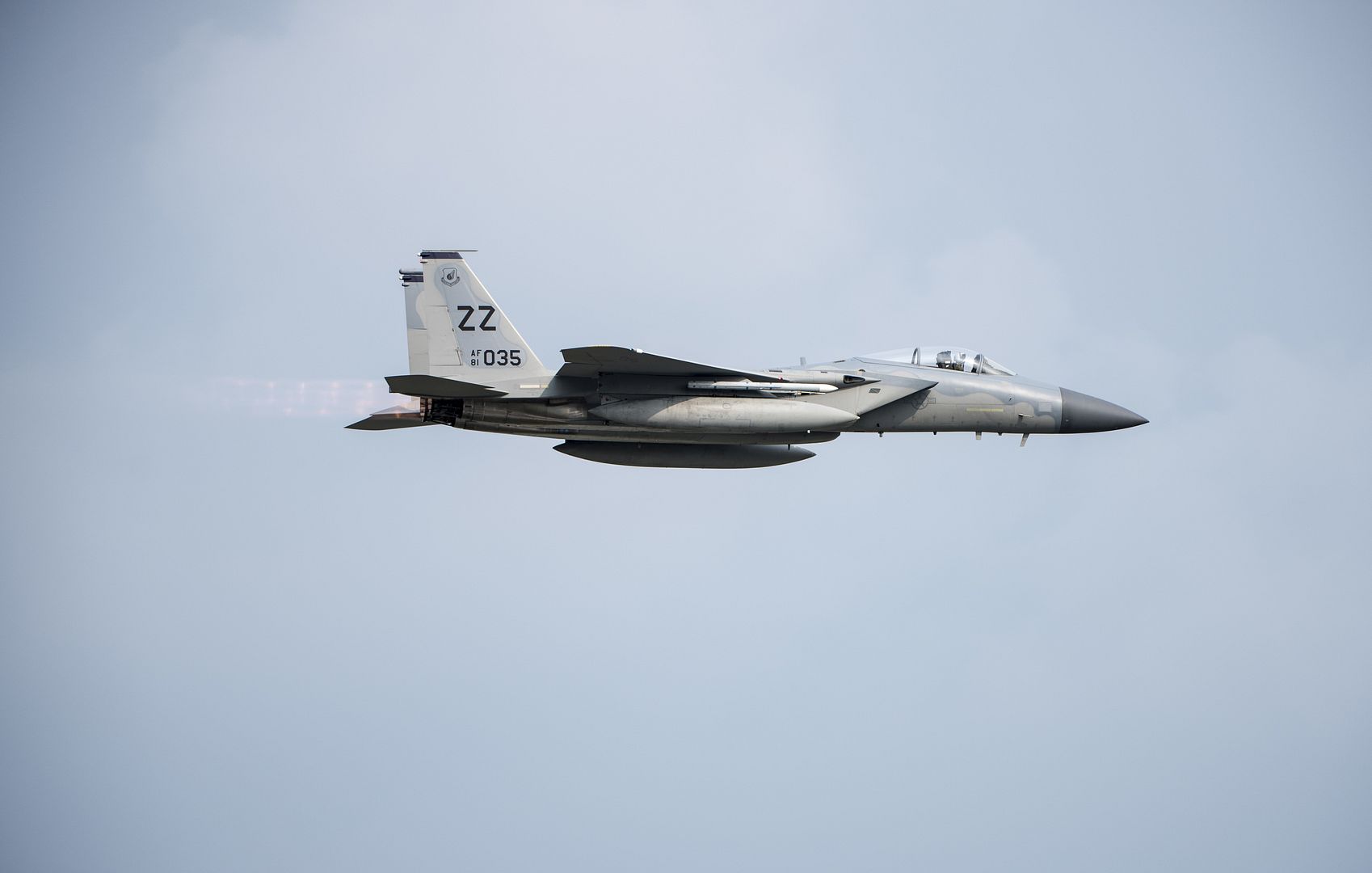
ANKARA, Turkey, March 2, 2017 /PRNewswire/ -- Sikorsky, a Lockheed Martin company, has transferred to defense electronics firm Aselsan an S-70i Black Hawk helicopter for use as the prototype aircraft for the Turkish Utility Helicopter Program (TUHP). The aircraft will enable Sikorsky to integrate an Aselsan-developed avionics suite into the Republic of Turkey's new T70 utility helicopter, and later into Turkish-built Sikorsky S-70i Black Hawk aircraft to be sold internationally.
Called the Integrated Modular Avionics System (IMAS), the new avionics suite is a collaborative design by Aselsan, Sikorsky, Turkish Aerospace Industries (TAI) and pilots serving the Turkish Armed Forces to meet the requirements of Turkish T70 operators and other potential customers.
TAI leads a team of Turkish aerospace companies that will build at least 109 helicopters with the T70 designation for the Turkish Utility Helicopter Program. The IMAS suite is expected in time for initial deliveries of T70 aircraft to Turkish end users in 2021.
"Delivery of this S-70i prototype fulfills a major milestone for the Turkish Utility Helicopter Program, and signals our continued close collaboration with Aselsan and the other aerospace companies led by TAI," said Sikorsky President Dan Schultz. "The employees of Sikorsky are honored that the largest international industrialization project in our 93-year history will help all the end-users fulfill their requirements for a modern utility helicopter based on the Black Hawk aircraft, while adding Turkish-developed avionics technology to further distinguish this proven platform."
The Sikorsky-owned S-70i aircraft arrived at Aselsan facility in Ankara on February 25 after nine hours of flight from Sikorsky's PZL Mielec aircraft factory in southern Poland. During the 930nm journey, the aircraft crossed Slovakia, Hungary, Romania, and Bulgaria with two fuel stops along the way.
Sikorsky TUHP Program Director Jason Lambert presented the aircraft's keys to Aselsan President and CEO Dr. Faik EKEN during a March 1 arrival ceremony. Also attending were officials from the Turkish Government's Undersecretariat for Defence Industries (SSM), the Turkish defense industry, Sikorsky, and an international diplomatic delegation with missions in Ankara.
ASELSAN and Sikorsky are co-developing the IMAS suite to provide Turkish pilots with powerful smart displays, point-and-click functionality to speed input of pilot commands, and ergonomic enhancements to the Pilot Vehicle Interface that will reduce pilot workload. Navigational improvements tailored to Turkish requirements will include an integrated Terrain Avoidance Warning System, an integrated advanced digital map, and coupled flight control functions for guided approaches to landing zones.
The TUHP program is valued at approximately $3.5 billion for 109 T70 aircraft, inclusive of the work to be performed by Sikorsky, TAI and other suppliers.
Partnerships are an important feature of the strong, strategic, relationship that has existed between Lockheed Martin and Turkey, an important NATO member state, for more than 30 years. The company has a proud track-record of working in partnership with Turkish industry to help balance national security needs, sustain employment for Turkish people and contribute to the national economy.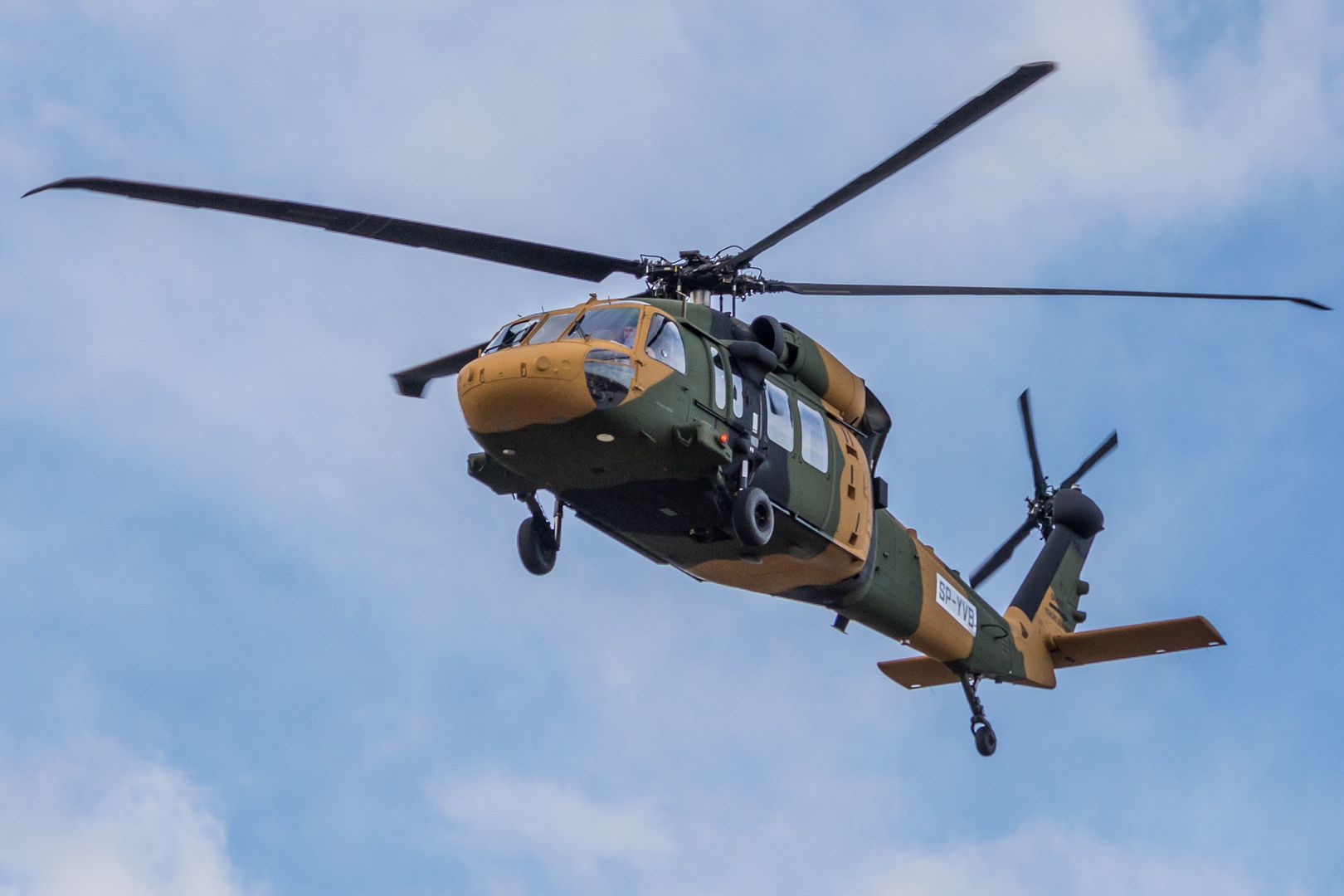
SAN DIEGO, March 1, 2017 -- Northrop Grumman Corporation (NYSE:NOC) has begun flight testing of the MS-177 sensor payload with a successful inaugural flight on an RQ-4 Global Hawk high altitude long endurance autonomous aircraft system. The flight tests mark the first time the sensor has been flown on a high altitude long-range autonomous aircraft and extend the mission capabilities of the system. The MS-177 sensor is designed to provide capabilities to not only "find" targets using broad area search and different sensing technologies, but to also fix, track, and assess targets through its agility and multiple sensing modalities.
The MS-177 testing is expected to continue through the first half of 2017. The successful flight test at Northrop Grumman's Palmdale, California facility follows the demonstrations of two sensors previously unavailable on the Global Hawk. Northrop Grumman successfully flew a SYERS-2 intelligence gathering sensor in February 2016 and has recently completed flight tests of the Optical Bar Camera.
?The MS-177 is the new benchmark in imaging intelligence, surveillance and reconnaissance [ISR] sensors and its integration into the Global Hawk platform expands the mission capability we can provide,? said Mick Jaggers, vice president and program manager, Global Hawk program, Northrop Grumman. ?This successful flight is another milestone in an aggressive effort to demonstrate Global Hawk?s versatility and effectiveness in carrying a variety of sensor payloads and support establishing OMS compliancy.?
The Global Hawk system is the premier provider of persistent intelligence, surveillance and reconnaissance information. Able to fly at high altitudes for greater than 30 hours, Global Hawk is designed to gather near-real-time, high-resolution imagery of large areas of land in all types of weather ? day or night. In active operation with the U.S. Air Force since 2001, Global Hawk has amassed more than 200,000 flight hours with missions flown in support of military and humanitarian operations.
-
 Main AdminMARINE CORPS BASE CAMP PENDLETON, Calif. ? A CH-53 Super Stallion lands during a tactical recovery of aircraft and personnel training mission aboard Camp Pendleton, March 1, 2017. TRAP training reinforces the written rule of the Corps ? never leave a Marine behind. The training is a small part of the evolutions the Battalion Landing Team will conduct in order to get ready to deploy with the 15th Marine Expeditionary Unit later this year. The Marines used the super stallion to insert and extract from the area of operation. The wide variety of overseas crisis and conflicts justifies the nature of and requirements for expeditionary operations and the Marine Corps? role in and approach to their conduct. (U.S. Marine Corps photo by Lance Cpl. Frank Cordoba)
Main AdminMARINE CORPS BASE CAMP PENDLETON, Calif. ? A CH-53 Super Stallion lands during a tactical recovery of aircraft and personnel training mission aboard Camp Pendleton, March 1, 2017. TRAP training reinforces the written rule of the Corps ? never leave a Marine behind. The training is a small part of the evolutions the Battalion Landing Team will conduct in order to get ready to deploy with the 15th Marine Expeditionary Unit later this year. The Marines used the super stallion to insert and extract from the area of operation. The wide variety of overseas crisis and conflicts justifies the nature of and requirements for expeditionary operations and the Marine Corps? role in and approach to their conduct. (U.S. Marine Corps photo by Lance Cpl. Frank Cordoba)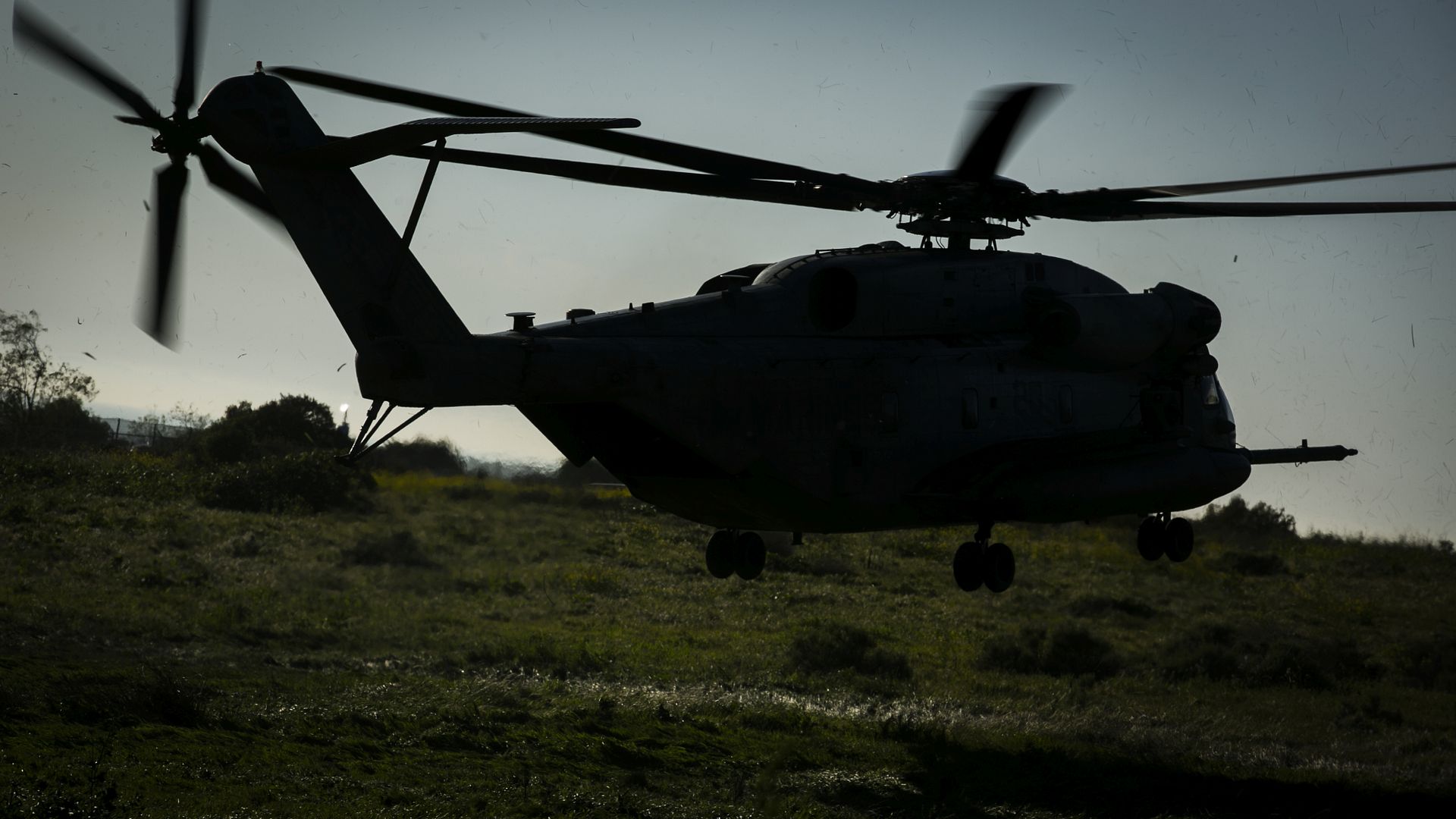
A U.S. Air Force B-1B Lancer bomber aircraft lands at Avalon Airport, Geelong, Australia, March 1, 2017. The B-1B is participating in the Australian International Airshow and Aerospace & Defence Exposition (AVALON), the largest, most comprehensive aerial event of its kind in the Southern Hemisphere. While at AVALON, the B-1B will be on static display for airshow participants. This is the first time B-1s have landed in Australia while deployed in support of U.S. Pacific Command?s Continuous Bomber Presence mission. The U.S. conducts CBP operations routinely by forward deploying bombers into the region as a deterrence capability supporting security and allies and partners in the Indo-Asia-Pacific. Bombers and aircrew commonly participate in combined exercises and operations during CBP deployments. AVALON 2017 provided an ideal forum for the U.S. to showcase the B-1B?s capabilities to our allies, partners and citizens of the Pacific. (U.S. Air Force photo by Master Sgt. John Gordinier)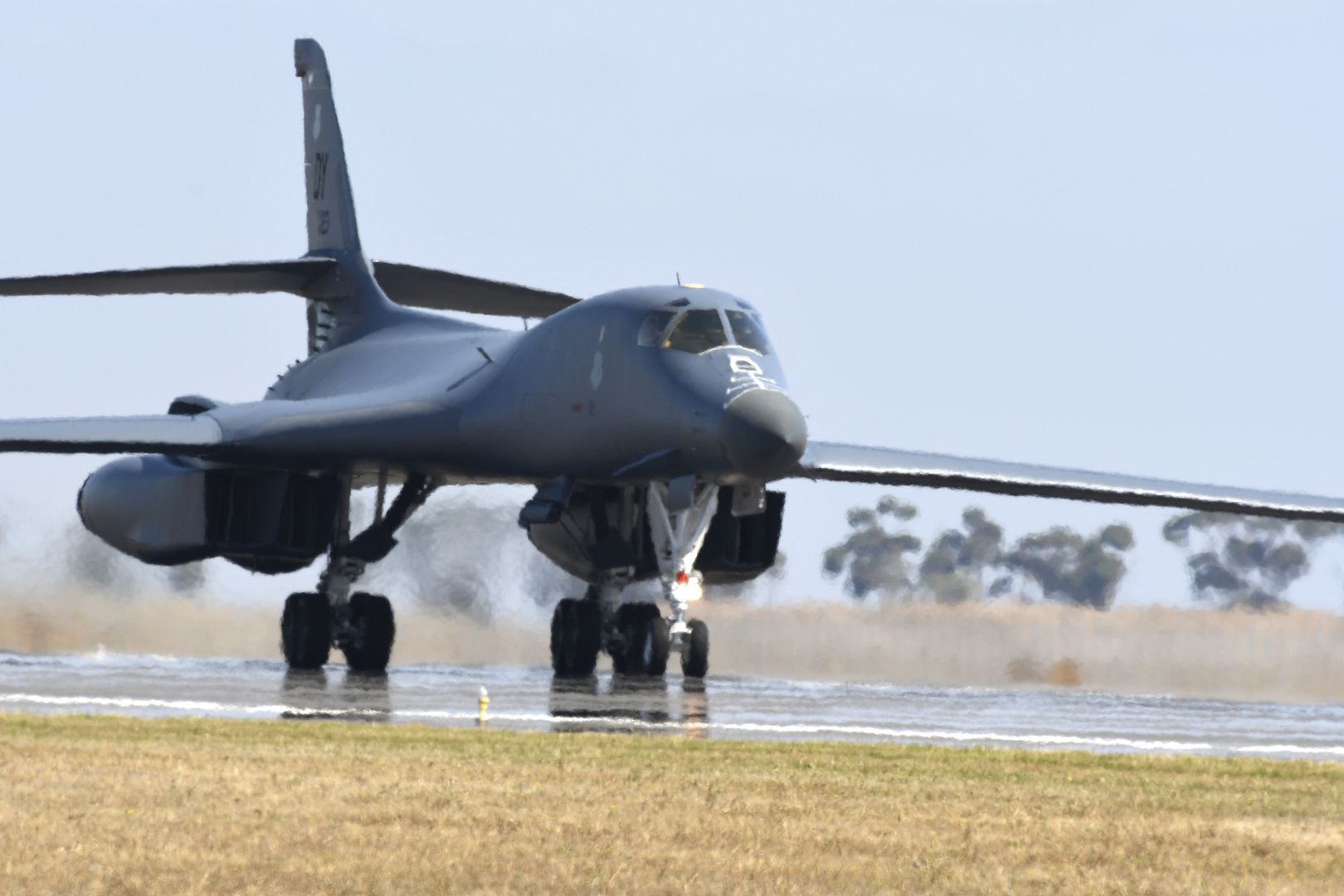
U.S. Air Force Lt. Col. Matthew "Gizmo" Jones, a fighter pilot, 100th Fighter Squadron, Montgomery Regional Air National Guard Base, Ala., takes off March 1, 2017, during Red Flag 17-2 at Nellis Air Force Base, Nev. Red Flag involves a variety of attack, fighter, bomber, reconnaissance, electronic warfare, airlift support, search and rescue aircraft. (U.S. Air National Guard photo by Airman 1st Class Hayden Johnson)
U.S. Air Force 1st Lt. Robert "Alamo" Freeman, a fighter pilot, 100th Fighter Squadron, Montgomery Regional Air National Guard Base, Ala., takes off March 1, 2017, during Red Flag 17-2 at Nellis Air Force Base, Nev. Red Flag involves a variety of attack, fighter, bomber, reconnaissance, electronic warfare, airlift support, search and rescue aircraft. (U.S. Air National Guard photo by Airman 1st Class Hayden Johnson)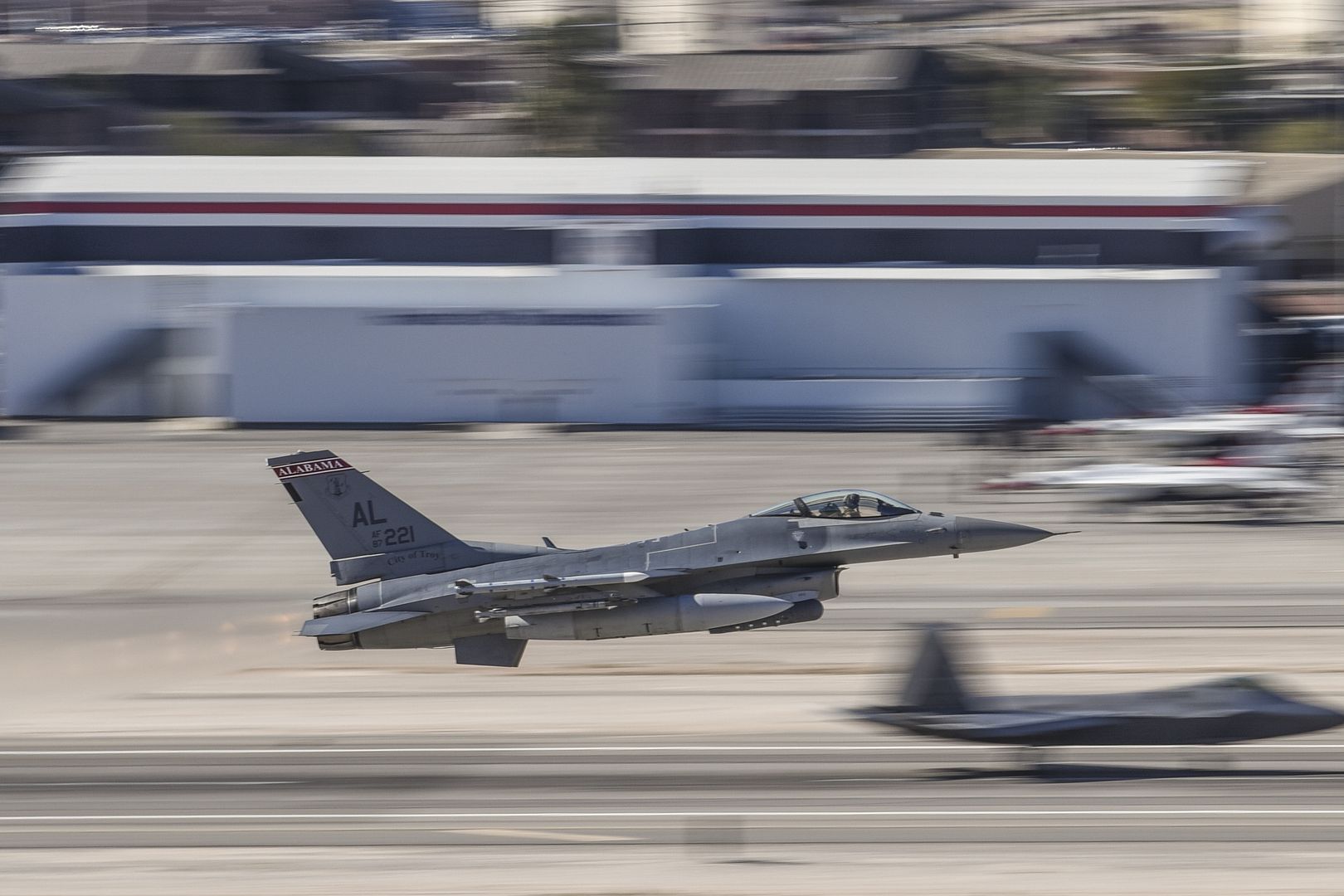
A three-ship formation of U.S. Air Force F-16 Fighting Falcons assigned to the18th Aggressor Squadron fly alongside a U.S. Air Force KC-135 Stratotanker and wait to receive in-flight fuel during Cope North 17, March 2, 2017. The exercise includes 22 total flying units and more than 2,700 personnel from three countries and continues the growth of strong, interoperable relationships within the Indo-Asia-Pacific region through integration of airborne and land-based command and control assets. (U.S. Air Force photo by Staff Sgt. Keith James)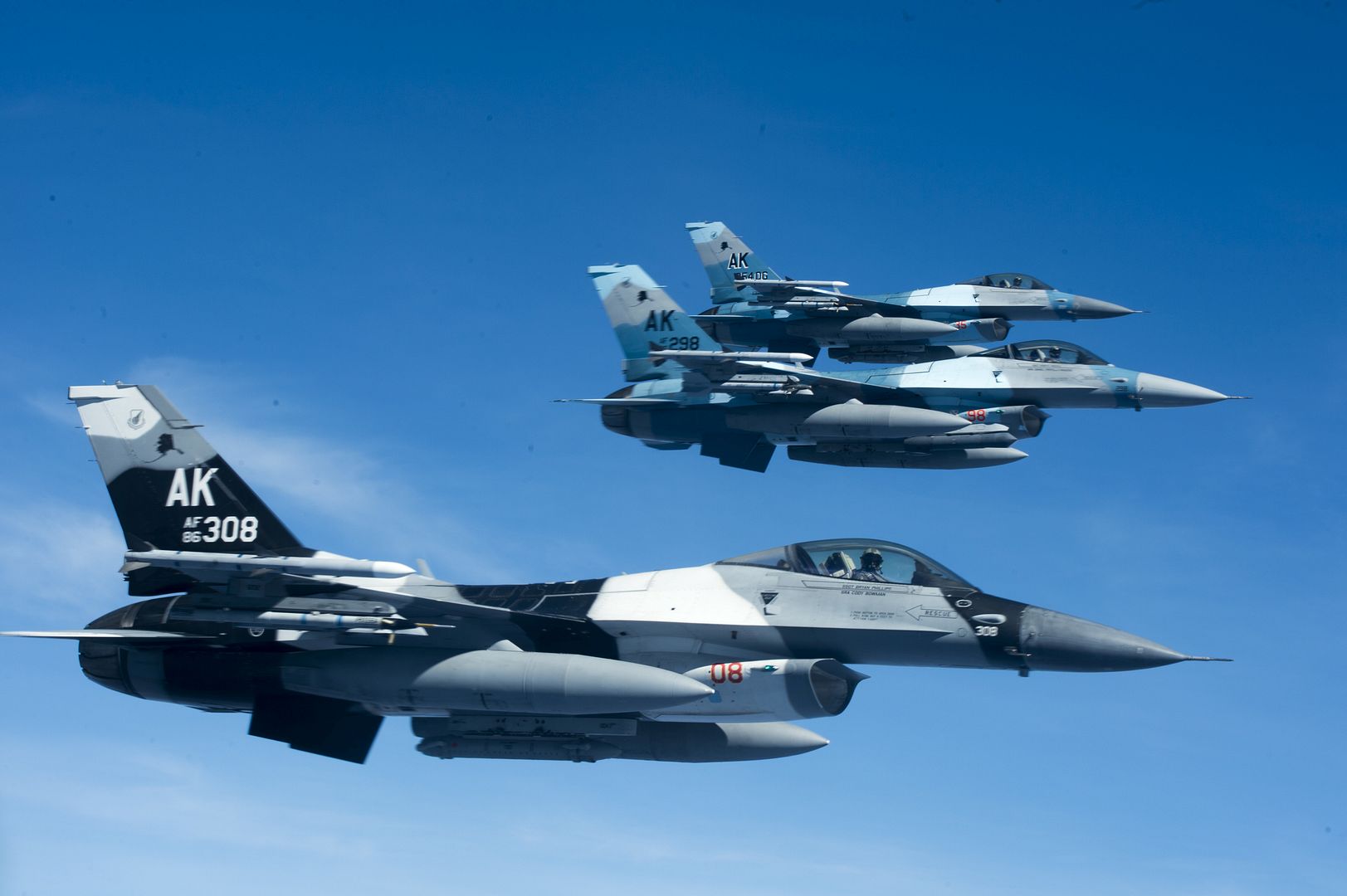
A U.S. Air Force F-16 Fighting Falcon assigned to the 18th Aggressor Squadron banks left after recieving in-flight fuel from a U.S. Air Force KC-135 Stratotanker during Cope North 17, March 2, 2017. The exercise includes 22 total flying units and more than 2,700 personnel from three countries and continues the growth of strong, interoperable relationships within the Indo-Asia-Pacific region through integration of airborne and land-based command and control assets. (U.S. Air Force photo by Staff Sgt. Keith James)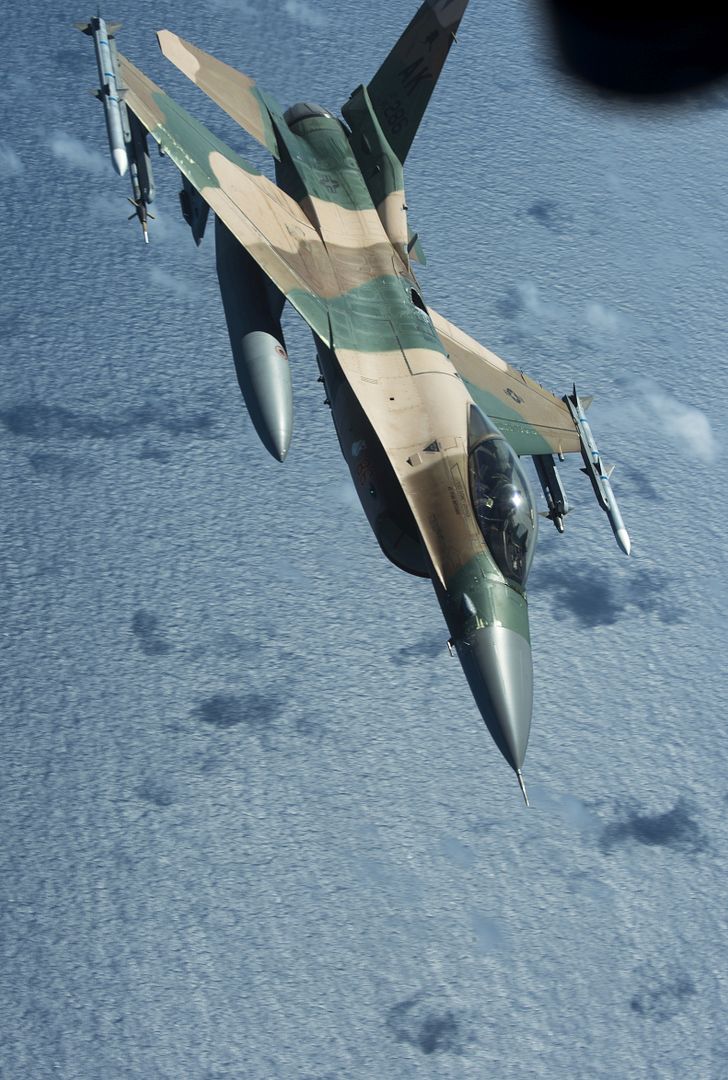
A U.S. Air Force F-16 Fighting Falcon assigned to the 18th Aggressor Squadron makes it way to recieve in-flight fuel from a U.S. Air Force KC-135 Stratotanker during Cope North 17, March 2, 2017. The exercise includes 22 total flying units and more than 2,700 personnel from three countries and continues the growth of strong, interoperable relationships within the Indo-Asia-Pacific region through integration of airborne and land-based command and control assets. (U.S. Air Force photo by Staff Sgt. Keith James)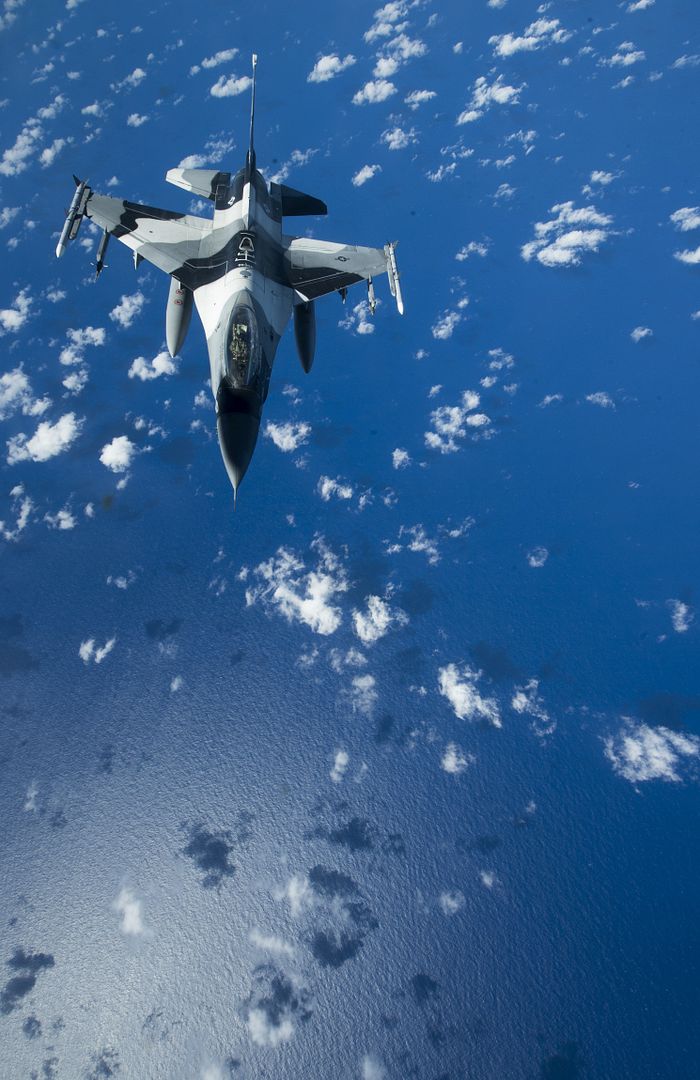
A U.S. Air Force F-22 Raptor flies above Royal Australian Air Force Base Tindal, Australia, March 2, 2017. Twelve F-22 Raptors and approximately 200 U.S. Air Force Airmen participated in the first Enhanced Air Cooperation, an initiative under the Force Posture Agreement between the U.S. and Australia. (U.S. Air Force photo by Maj. Lori Hodge)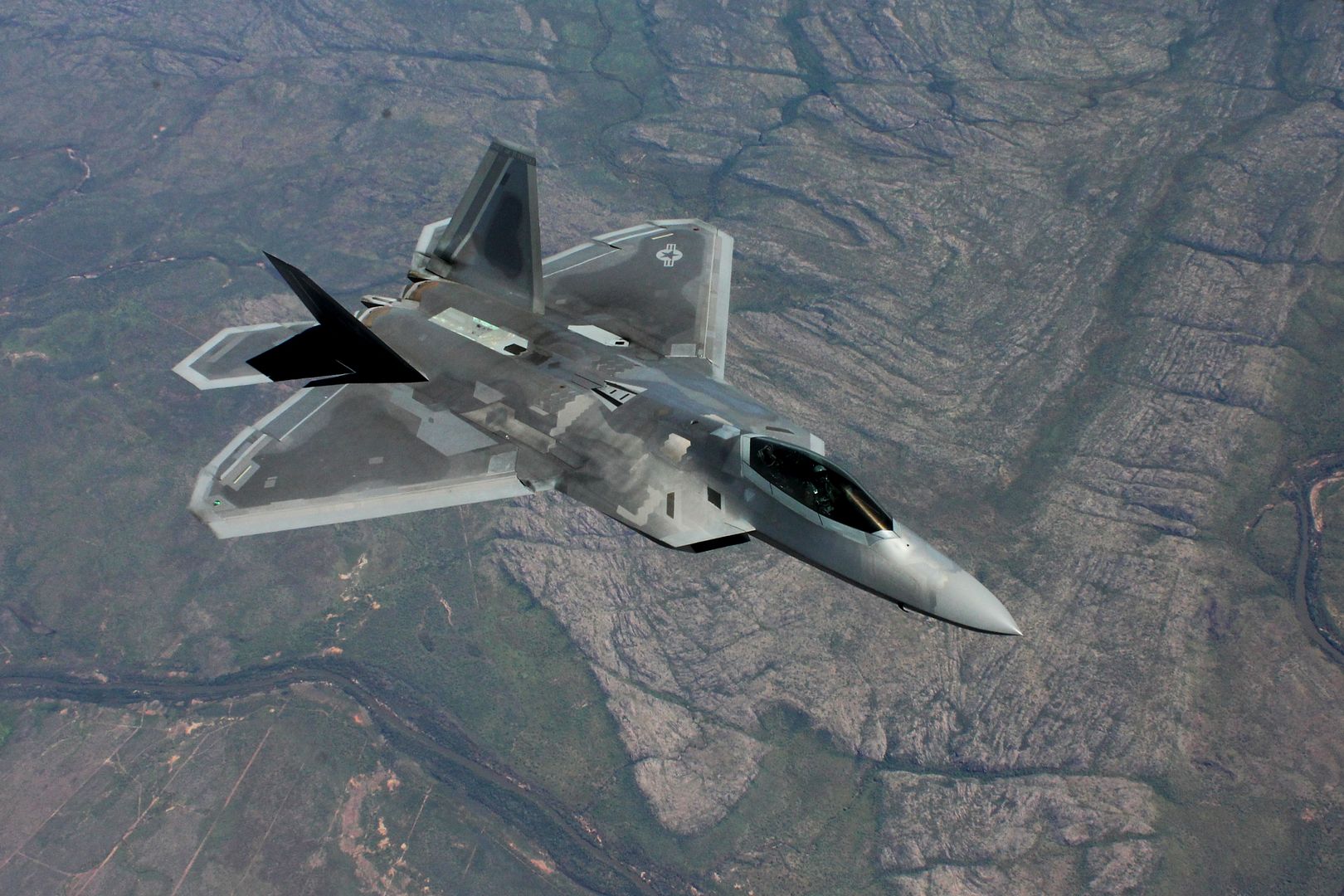
NEWPORT NEWS, Va. (March 2, 2017) ? President Donald J. Trump departs Pre-Commissioning Unit Gerald R. Ford (CVN 78) on Marine One, which is escorted by Marine Corps Osprey helicopters. Trump visited March 2 to meet with Sailors and shipbuilders of the Navy?s first-in-class aircraft carrier during an all-hands call inside the ship?s hangar bay. (U.S. Navy photo by Mass Communication Specialist 3rd Class Elizabeth Thompson)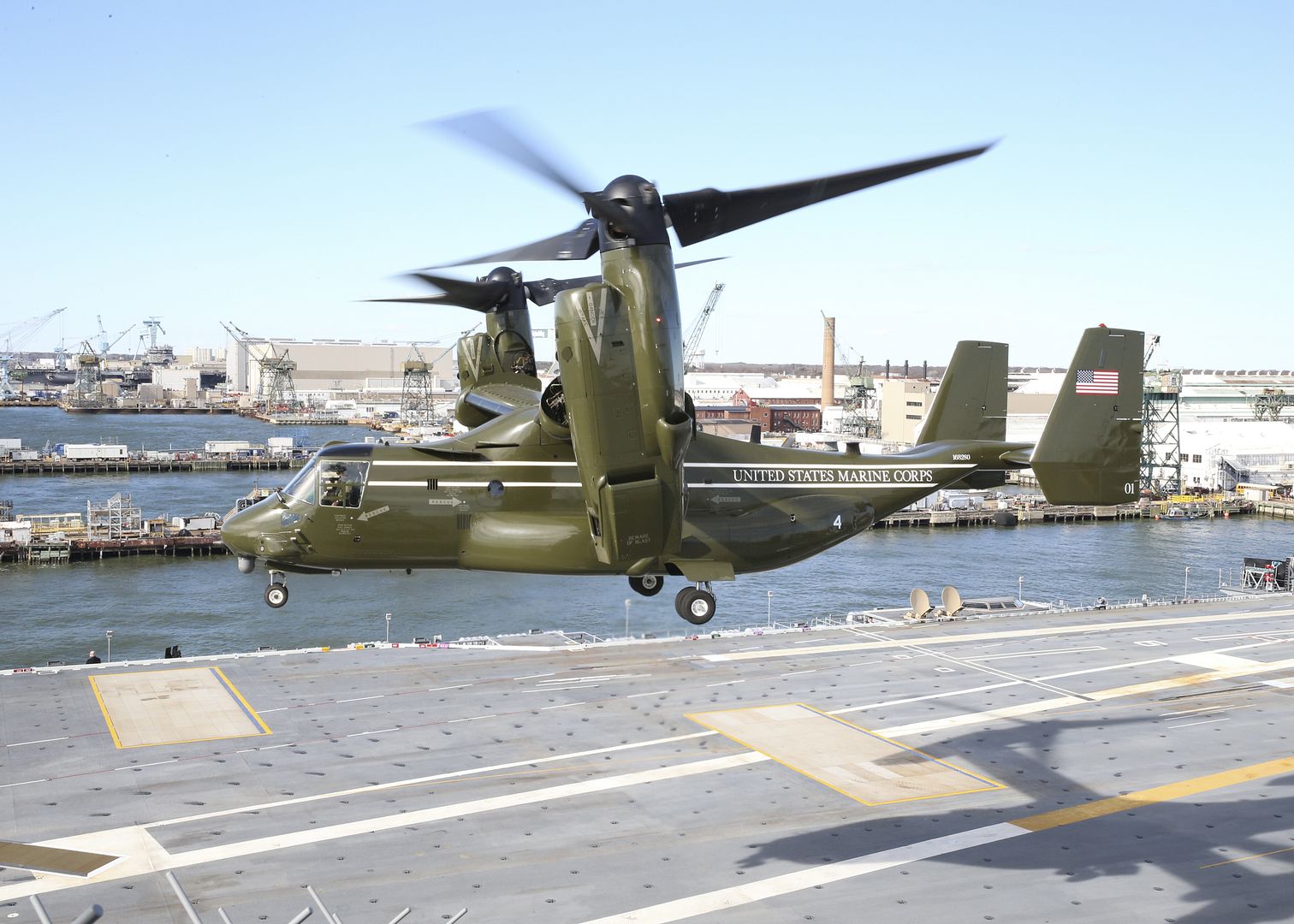
ORLANDO, Fla., March 2, 2017 ? Boeing [NYSE:BA] today unveiled its MH-139 helicopter in the competition to replace the U.S. Air Force?s UH-1N ?Huey? fleet, which currently protects intercontinental ballistic missiles and transports U.S. government and security forces.
Boeing?s response to the Air Force, revealed at the Air Force Association Air Warfare Symposium, is based on the market-leading Leonardo Helicopters AW139, a modern, non-developmental, multi-mission helicopter.
?This Northeast Philadelphia-built aircraft is sized to meet U.S. Air Force requirements and offers more than $1 billion in acquisition and lifecycle expense savings over 30 years when compared to competitor aircraft,? said David Koopersmith, vice president and general manager, Boeing Vertical Lift.
The U.S. Air Force UH-1N Replacement Program plans to replace the current Huey fleet -- which entered service in the 1970s -- with up to 84 new helicopters.
?The Huey replacement is of vital importance to the Air Force, and the MH-139 is the right solution for those missions,? said Judy Fedder, director of Global Sales & Marketing, Boeing Integrated Logistics, and a retired U.S. Air Force lieutenant general. ?The fact that the AW139 is being built today on an active production line will speed it to meet the time-critical demand following the competition.?
Almost 900 AW139s are in service with more than 250 governments, militaries and companies across the world. More than 250 of the helicopters have been assembled and delivered from Philadelphia.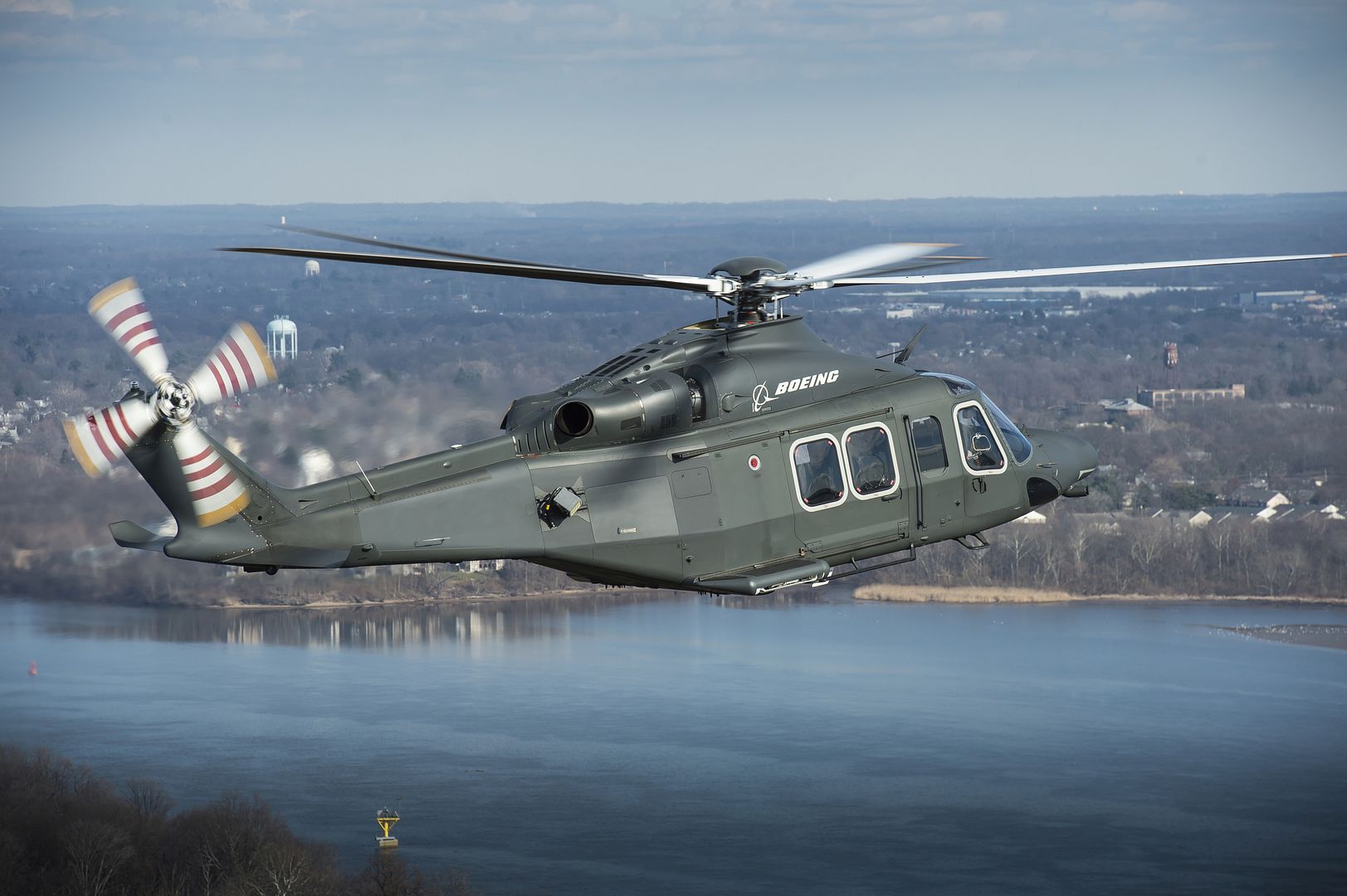
-
 Main AdminA U.S. Air Force C-146A Wolfhound taxis into position during Emerald Warrior 17 at Eglin Range, Fla., March 2, 2017. Emerald Warrior is a U.S. Special Operations Command exercise during which joint special operations forces train to respond to various threats across the spectrum of conflict. (U.S. Air Force photo by Airman 1st Class Nicholas Dutton)
Main AdminA U.S. Air Force C-146A Wolfhound taxis into position during Emerald Warrior 17 at Eglin Range, Fla., March 2, 2017. Emerald Warrior is a U.S. Special Operations Command exercise during which joint special operations forces train to respond to various threats across the spectrum of conflict. (U.S. Air Force photo by Airman 1st Class Nicholas Dutton)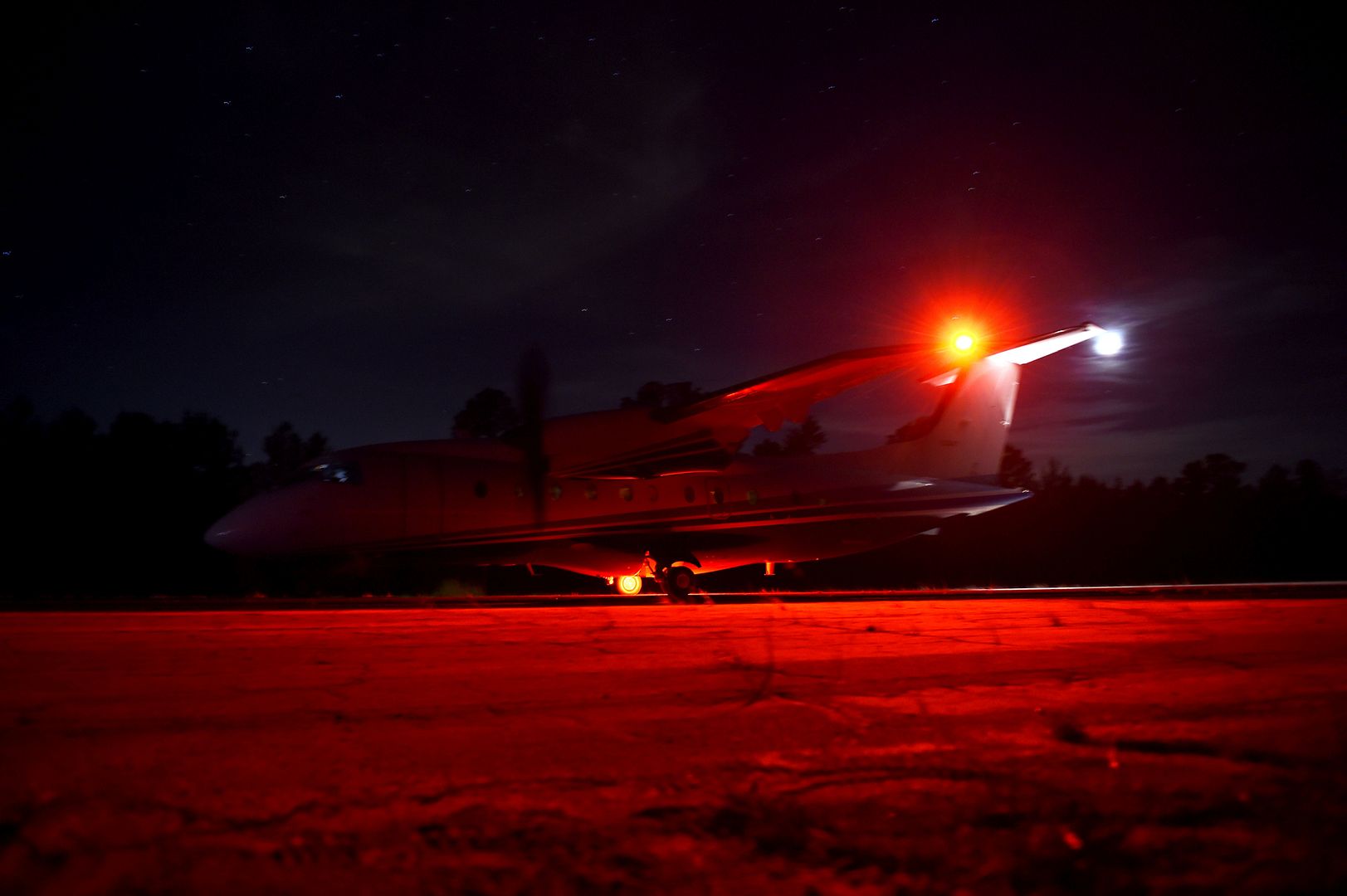
A U.S. Navy MH-60S Seahawk flies over the Emerald Coast after completing a helocast mission during Emerald Warrior 17 March 2, 2017, at Hurlburt Field, Fla. Emerald Warrior is a U.S. Special Operations Command exercise during which joint special operations forces train to respond to various threats across the spectrum of conflict. (U.S. Air Force photo's by Staff Sgt. Michael Battles)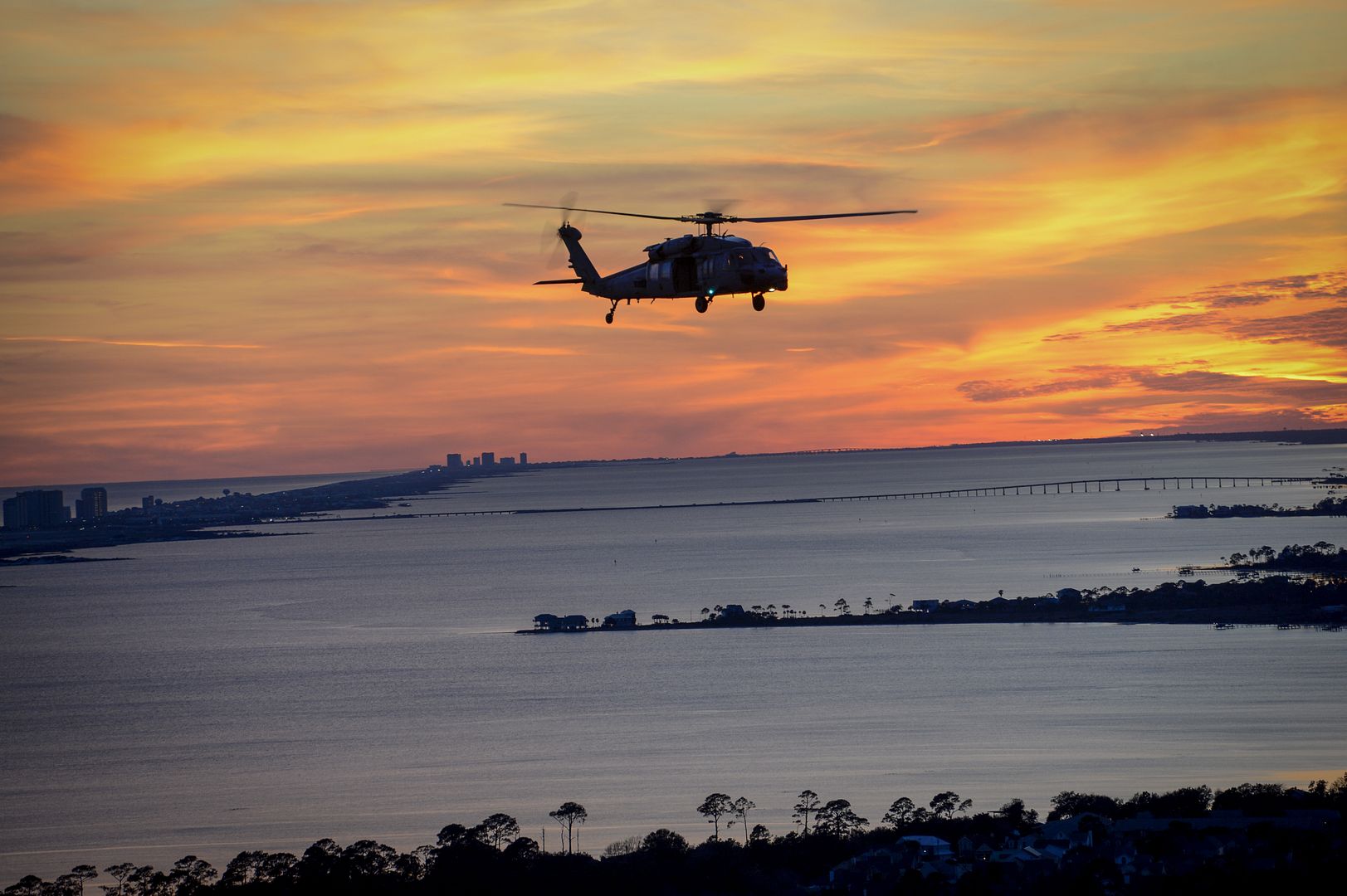
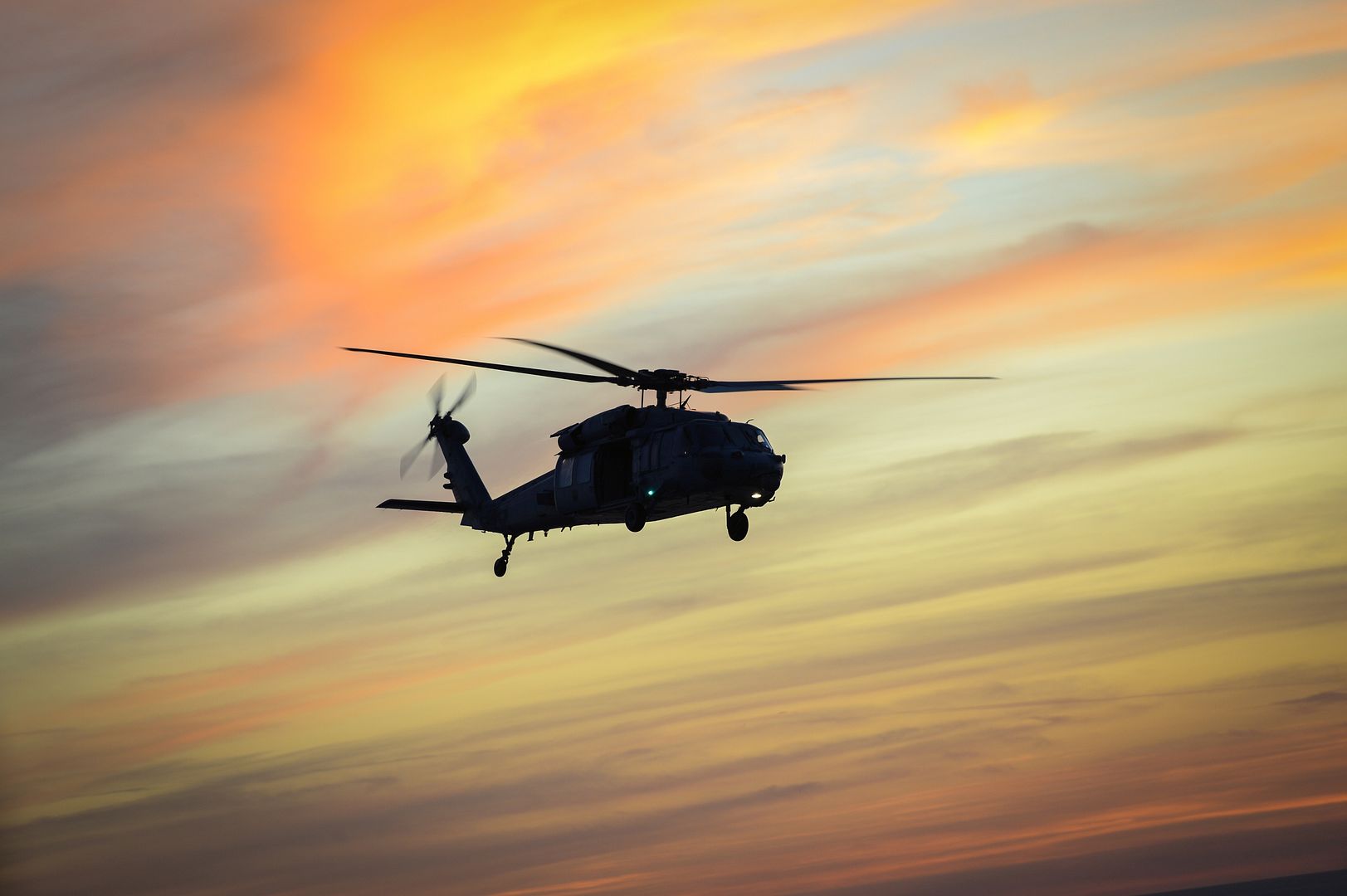
A U.S. Air Force CV-22 Osprey flies during Emerald Warrior 17 at Hurlburt Field, Fla., March 2, 2017. Emerald Warrior is a U.S. Special Operations Command exercise during which joint special operations forces train to respond to various threats across the spectrum of conflict. (U.S. Air Force photo by Staff Sgt. Corey Hook)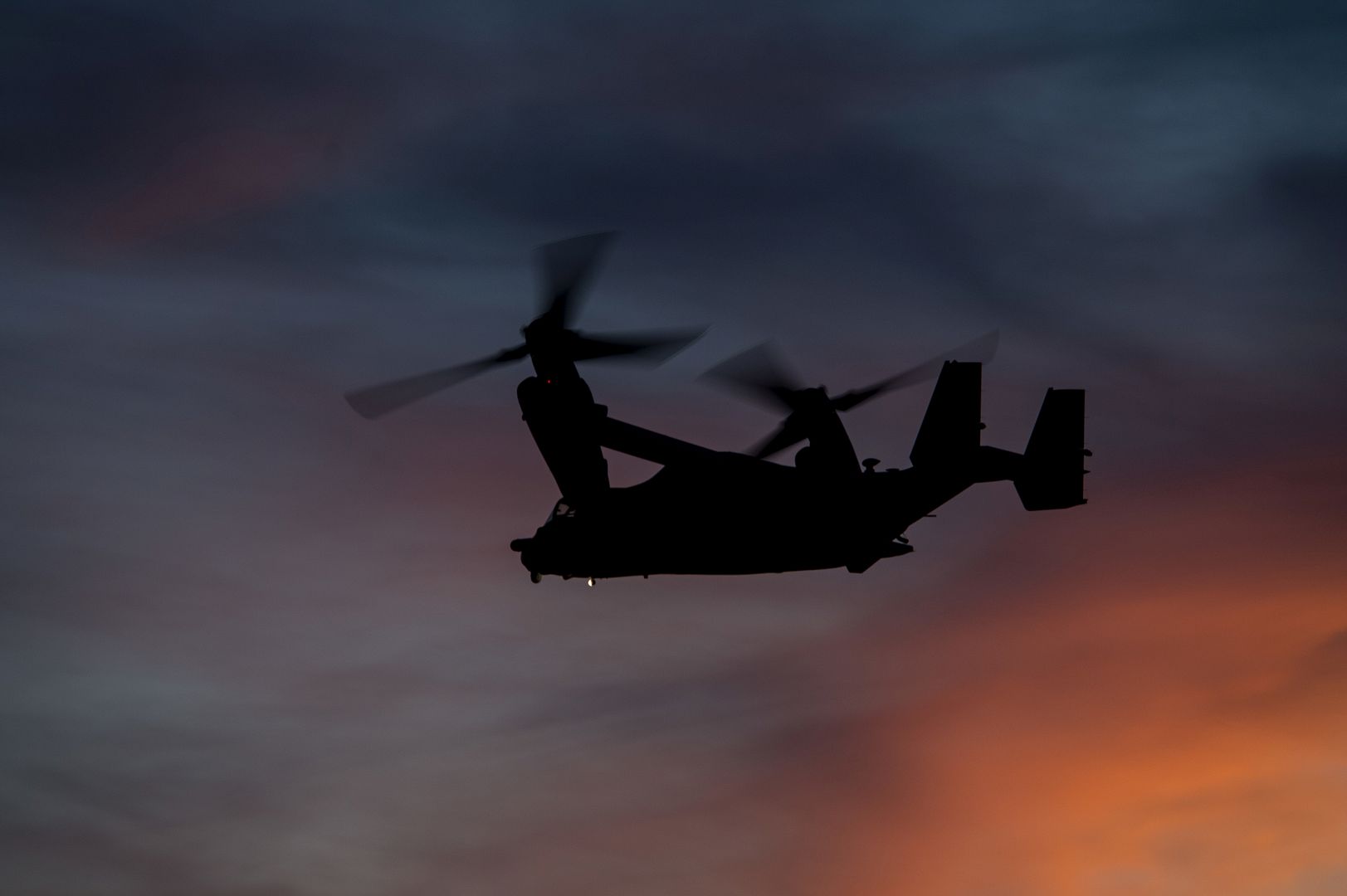
A U.S. Navy MH-60S Seahawk flies during Emerald Warrior 17 at Hurlburt Field, Fla., March 2, 2017. Emerald Warrior is a U.S. Special Operations Command exercise during which joint special operations forces train to respond to various threats across the spectrum of conflict. (U.S. Air Force photo by Staff Sgt. Corey Hook)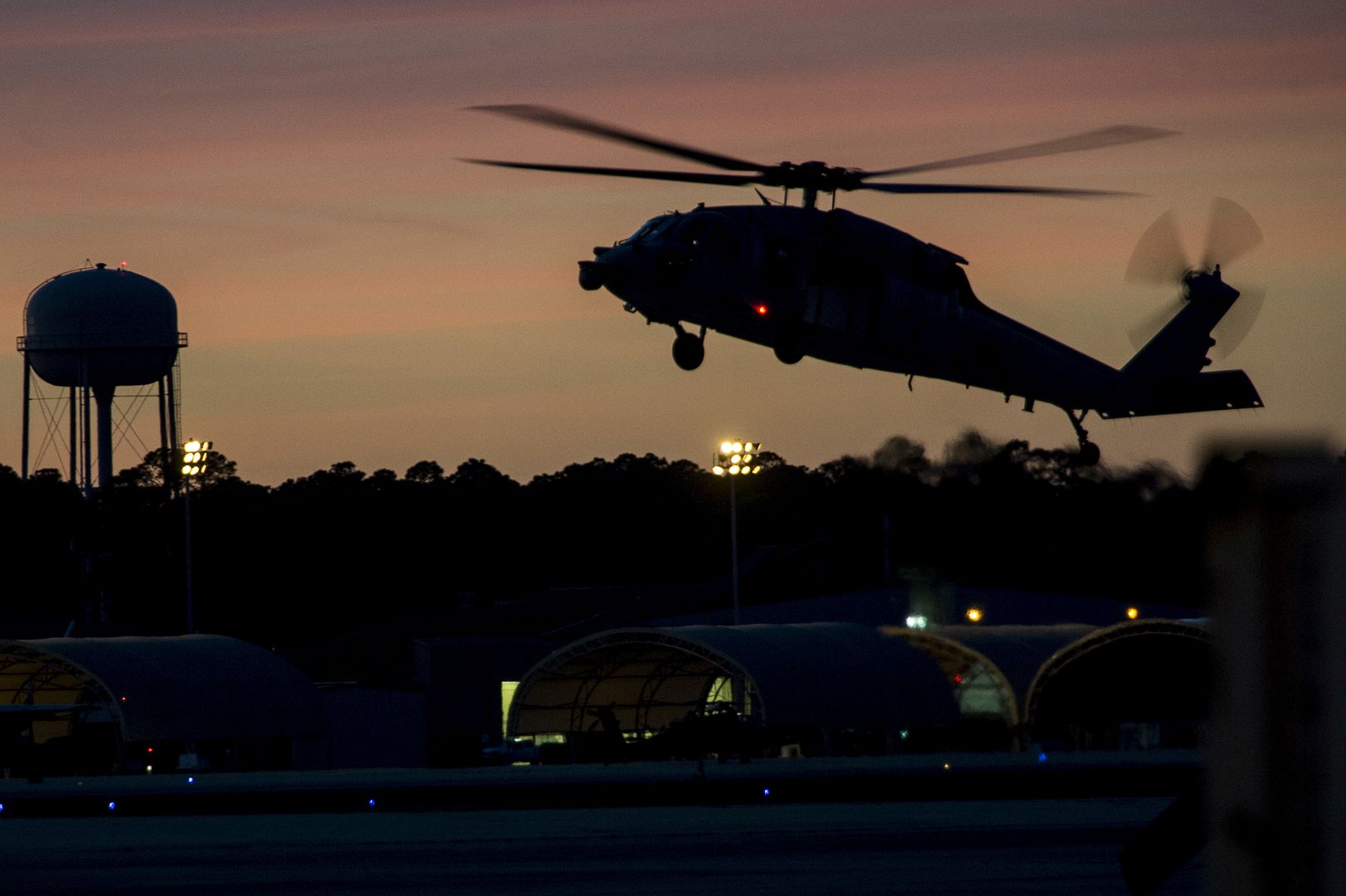
NASA pilots sit in the cockpit of the B-377 Super Guppy after arriving to Joint Base San Antonio-Randolph March 2, 2017. Only four Guppy aircraft were ever produced, and this Super Guppy is the last to remain in use. (U.S. Air Force photo by Airman 1st Class Lauren Parsons/Released)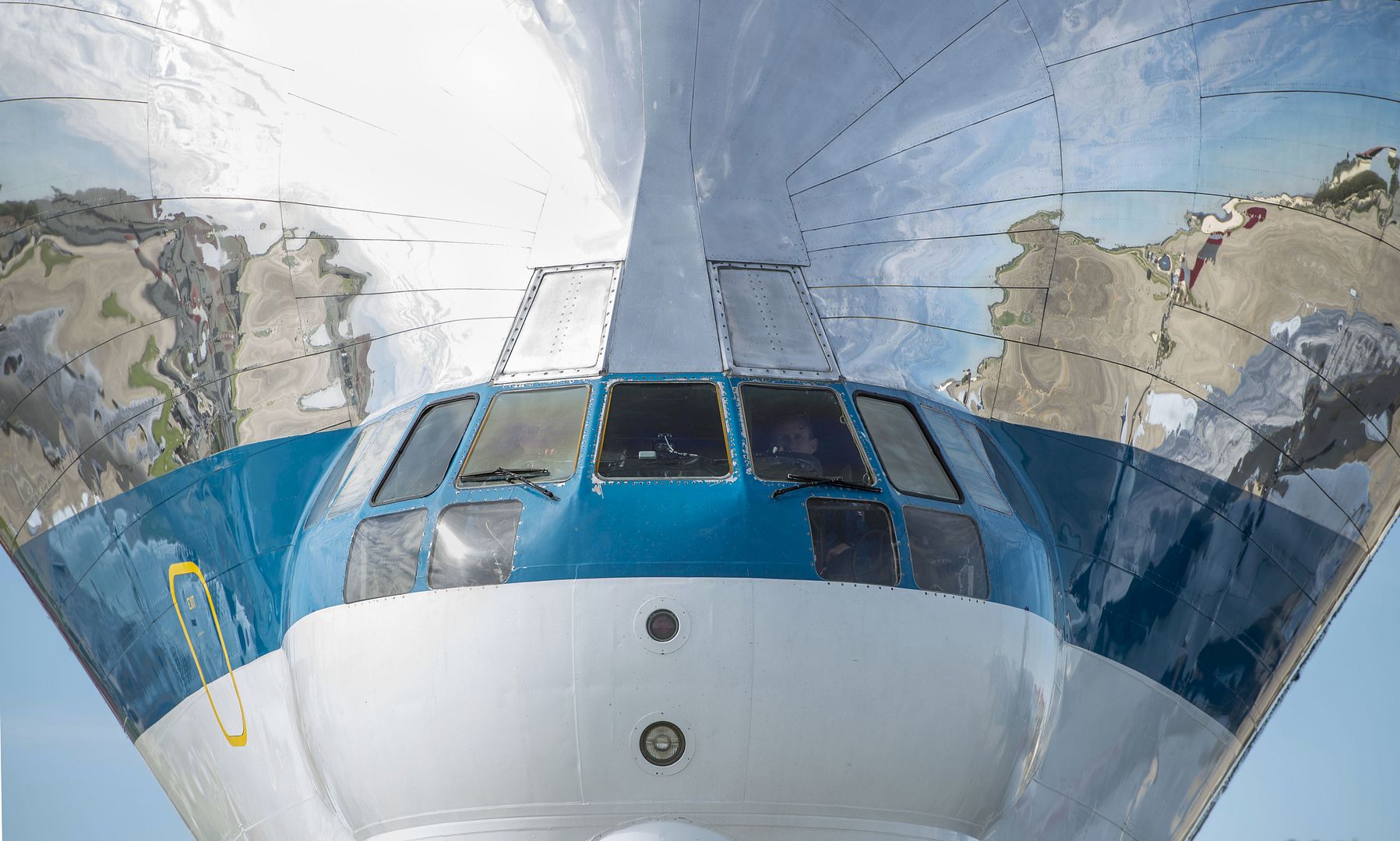
An AGM-114N Hellfire missile is launched from an MH-60S Seahawk helicopter assigned to Helicopter Sea Combat Squadron (HSC) 6, at an ordnance range on Mar. 02, 2017, at San Clemente Island, Calif., during a live-fire combat training exercise. HSC-6 provides vertical lift search and rescue, logistics, anti-surface warfare, special operations forces support, and combat search and rescue capabilities. (U.S. Navy Combat Camera photo by Mass Communication Specialist 1st Class Doug Harvey/Released)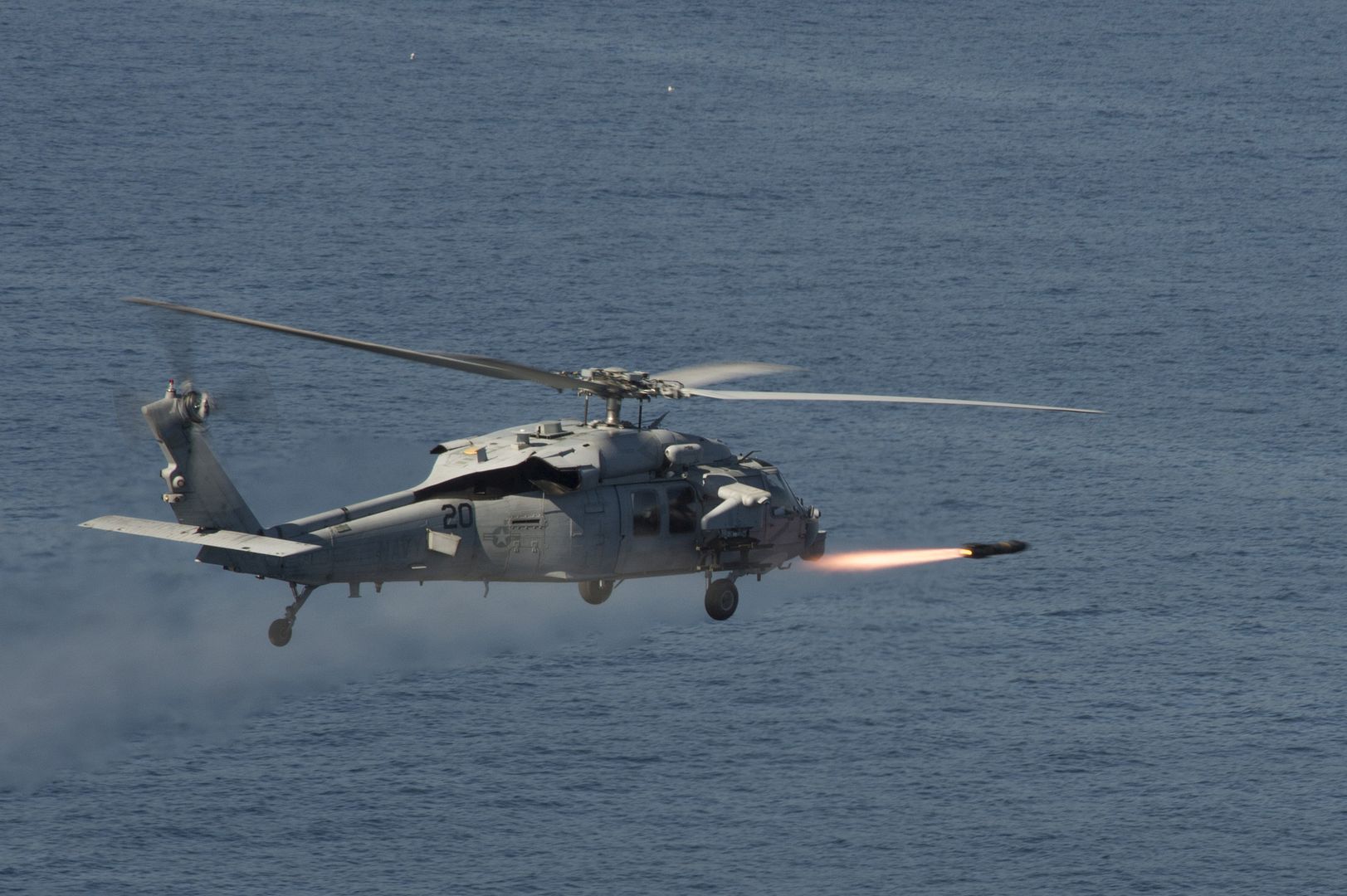
Geelong, AUSTRALIA ? A U.S. Air Force F-22 Raptor from the 90th Fighter Squadron, Joint Base Elmendorf-Richardson, Alaska, climbs causing vapor contrails in an aerial demonstration during the Australian International Airshow and Aerospace & Defence Exposition (AVALON) March 3. The F-22 Demonstration Team from Langley Air Force Base, Va., impressed the crowd for multiple days during the air show. AVALON 2017 is an ideal forum to showcase U.S. defense aircraft and equipment, particularly the latest in fifth generation capabilities such as the F-22 and F-35 Lightning II and it is the largest, most comprehensive event of its kind in the Southern Hemisphere, attracting aviation and aerospace professions, key defense personnel, aviation enthusiasts and the general public. The U.S. participates in AVALON and other similar events to demonstrate the U.S. commitment to regional security and stability. (U.S. Air Force photo/Master Sgt. John Gordinier)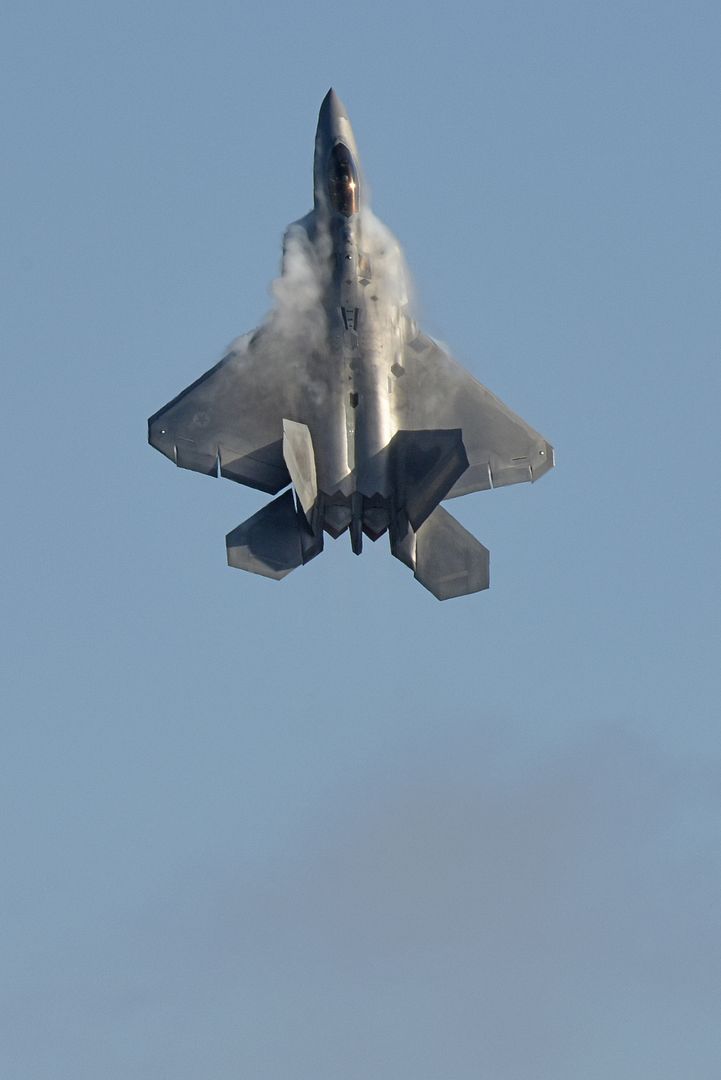
An Aero Spacelines B-377 Super Guppy sits on the flightline at Joint Base San Antonio-Randolph, Texas March 3, 2017. The Super Guppy, operated by NASA, has a cargo space that is 25 feet in diameter and 111 feet long. (U.S. Air Force photo's by Senior Airman Stormy Archer)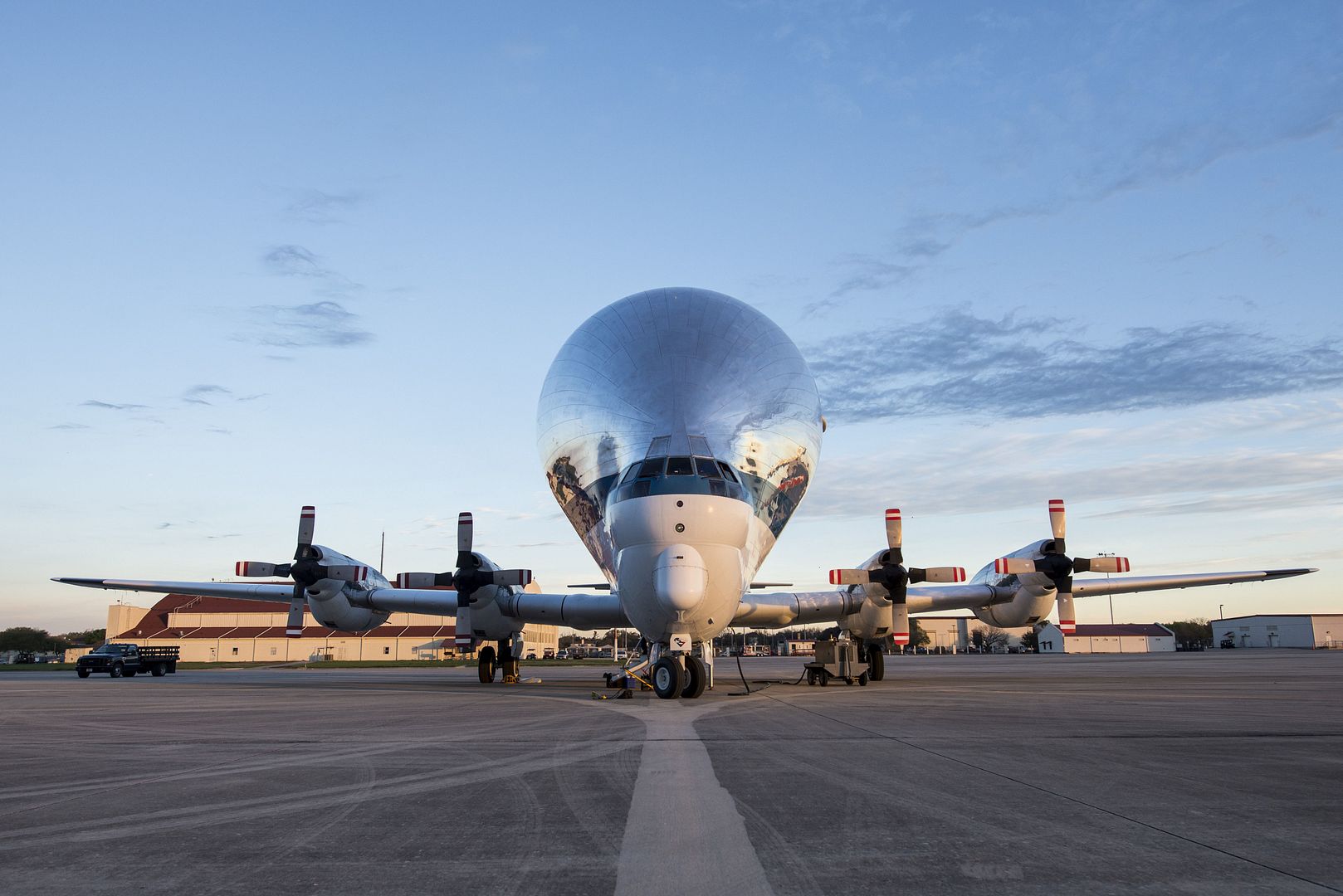
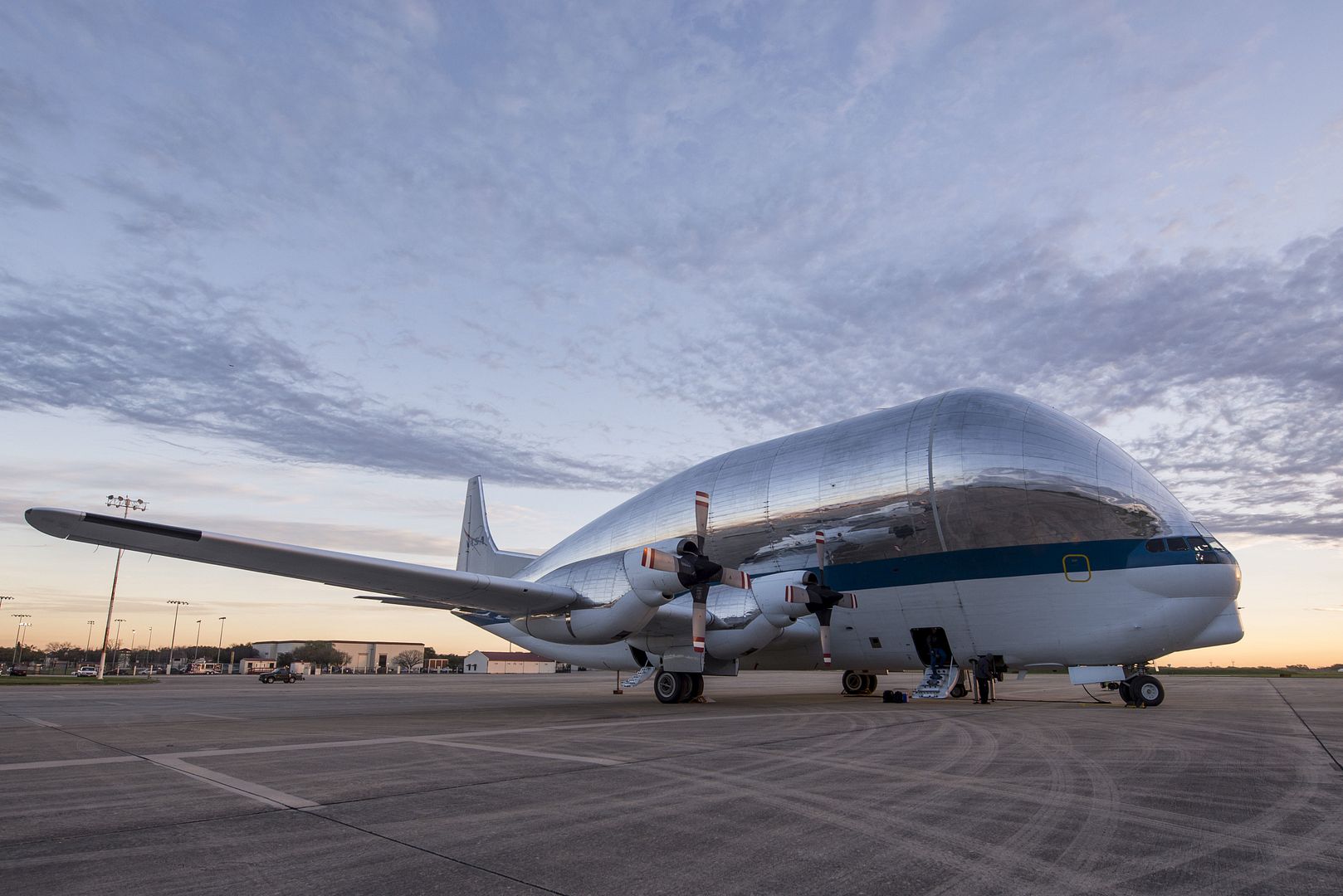
A T-38 Talon is unloaded from a B-377 Super Guppy March 3, 2017, at Joint Base San Antonio-Randolph, Texas. The Super Guppy has a hinged nose that opens 110 degrees, allowing full frontal cargo loading. (U.S. Air Force photo's by Senior Airman Stormy Archer/Released)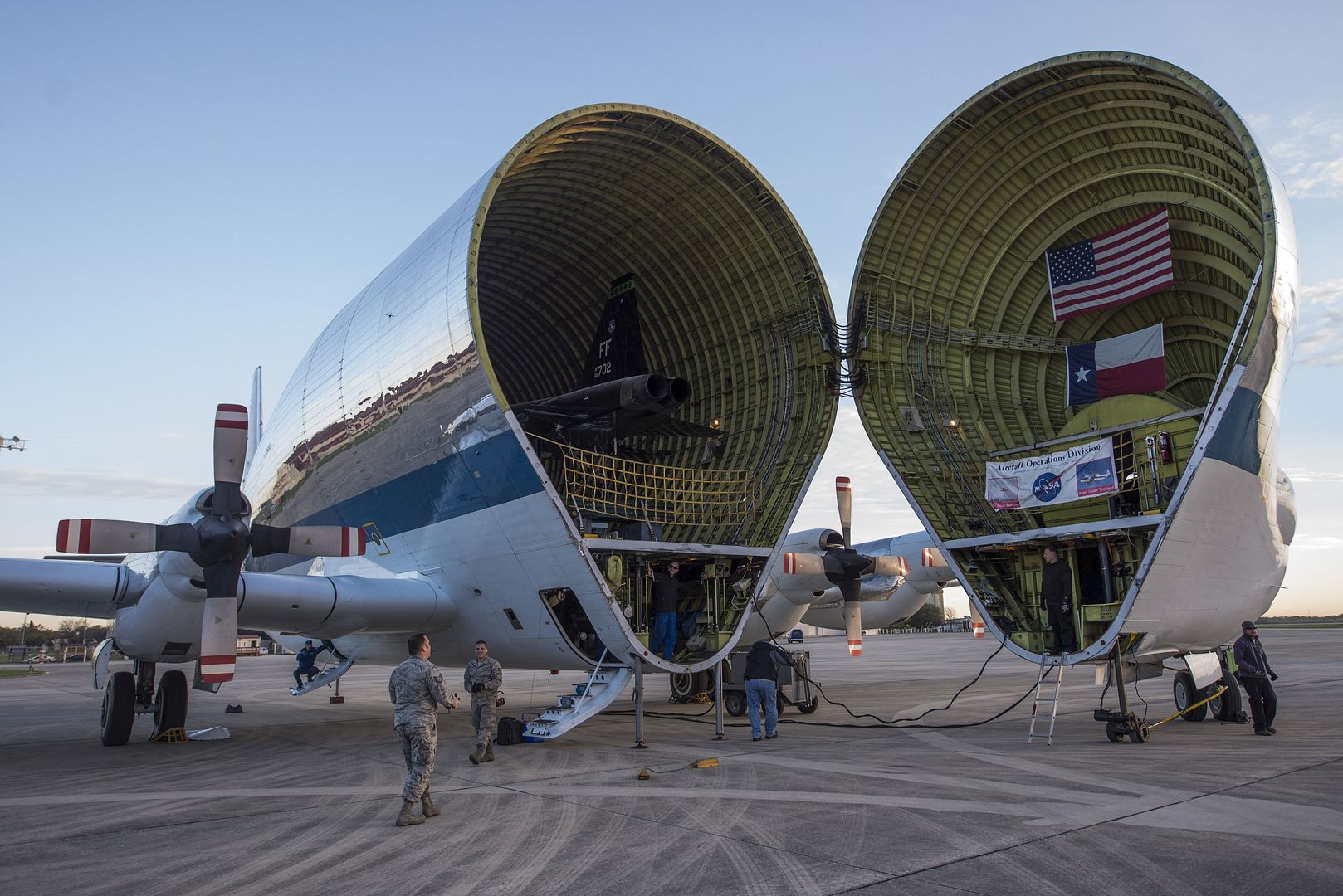
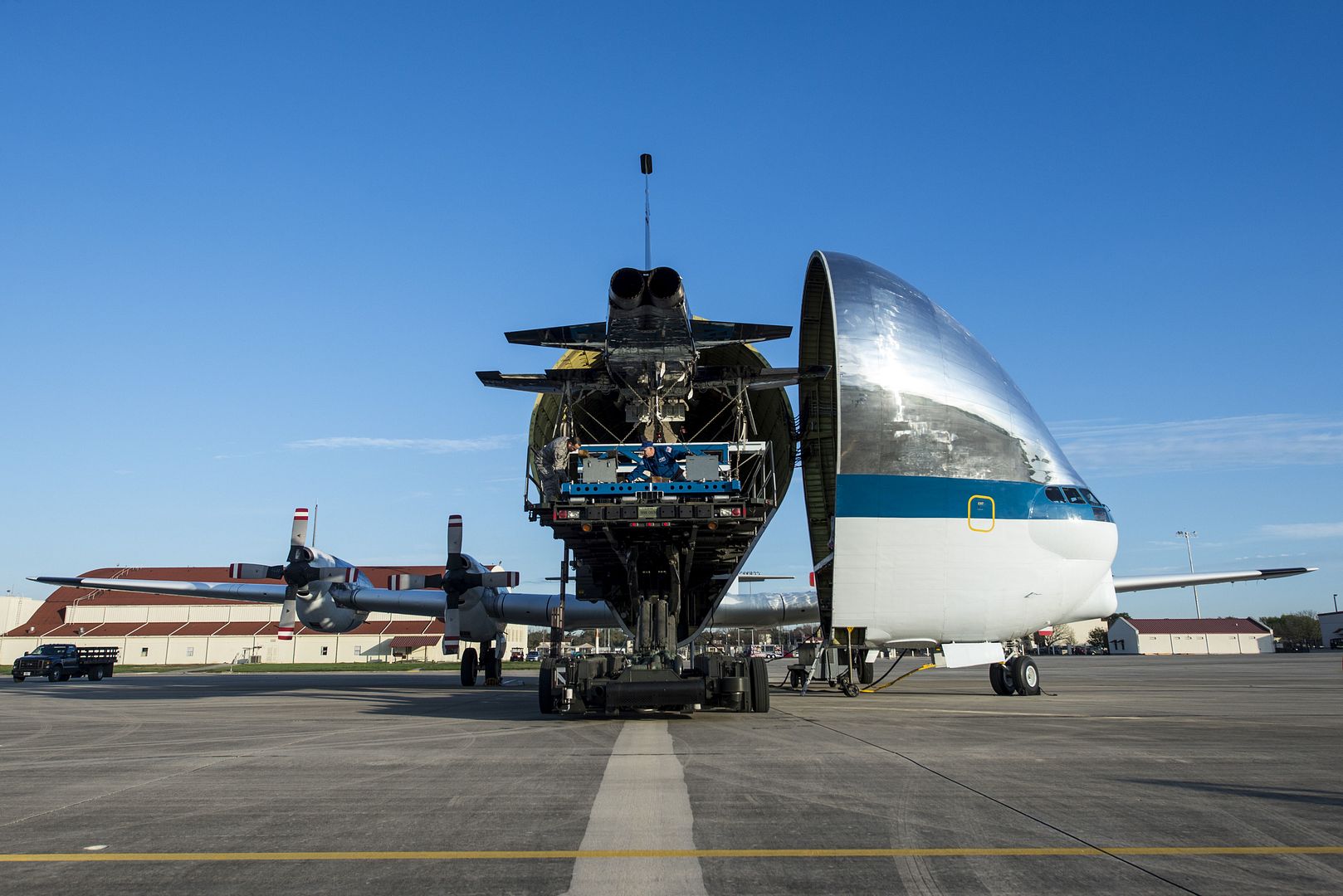
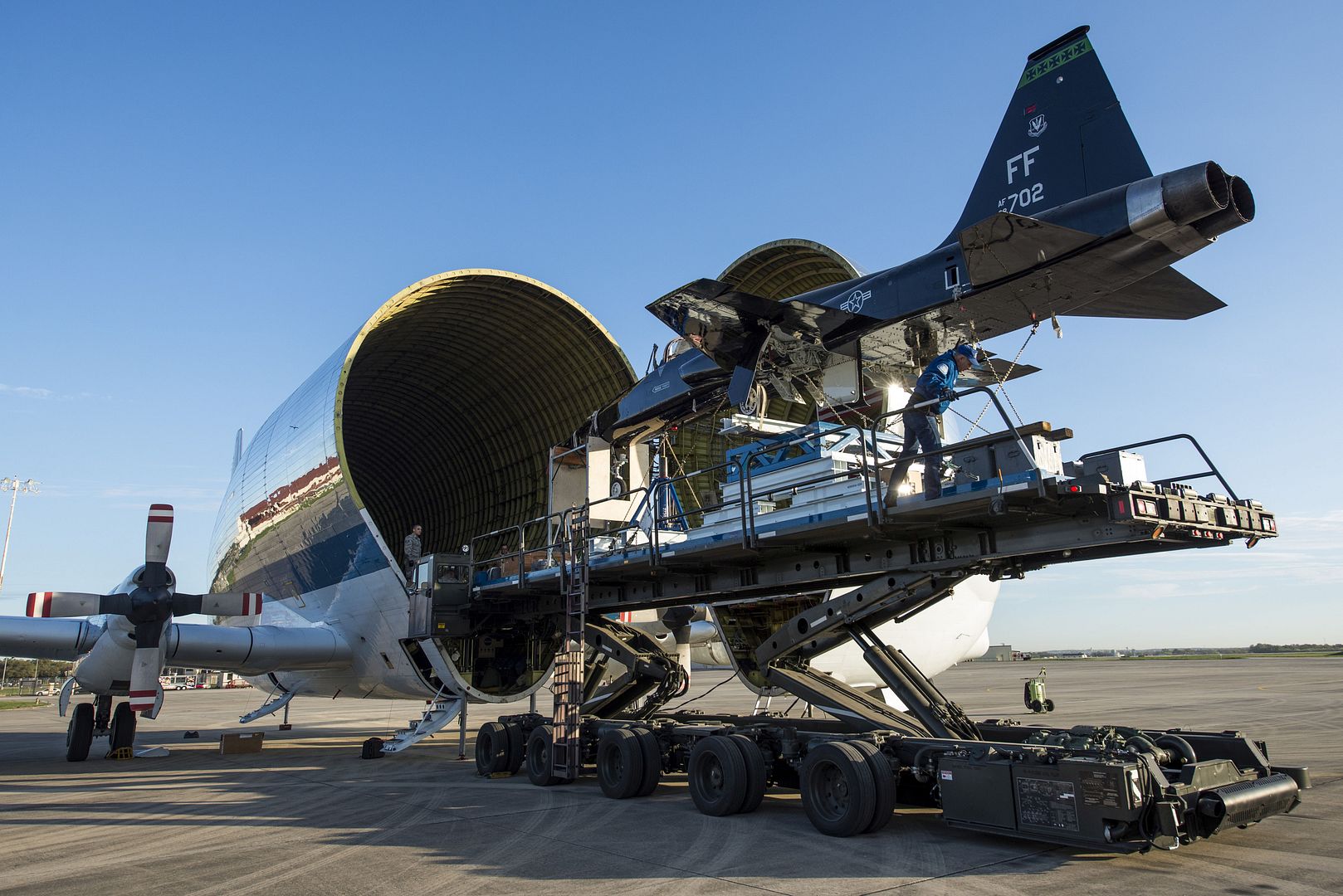
A P-3 Orion patrol aircraft attached to Patrol Squadron Nine (VP-9) Golden Eagles was prepared for final takeoff during command disestablishment at Marine Corps Base Hawaii. The VP-9 squadron is scheduled for a deployment, to be followed by a homeport shift to Naval Air Station Whidbey Island in Washington. The P-3 Orion is a four-engine turboprop anti-submarine and maritime surveillance aircraft developed by the U.S. Navy in the 1960s. (U.S. Navy photo by Mass Communication Specialist 1st Class Meranda Keller/Released)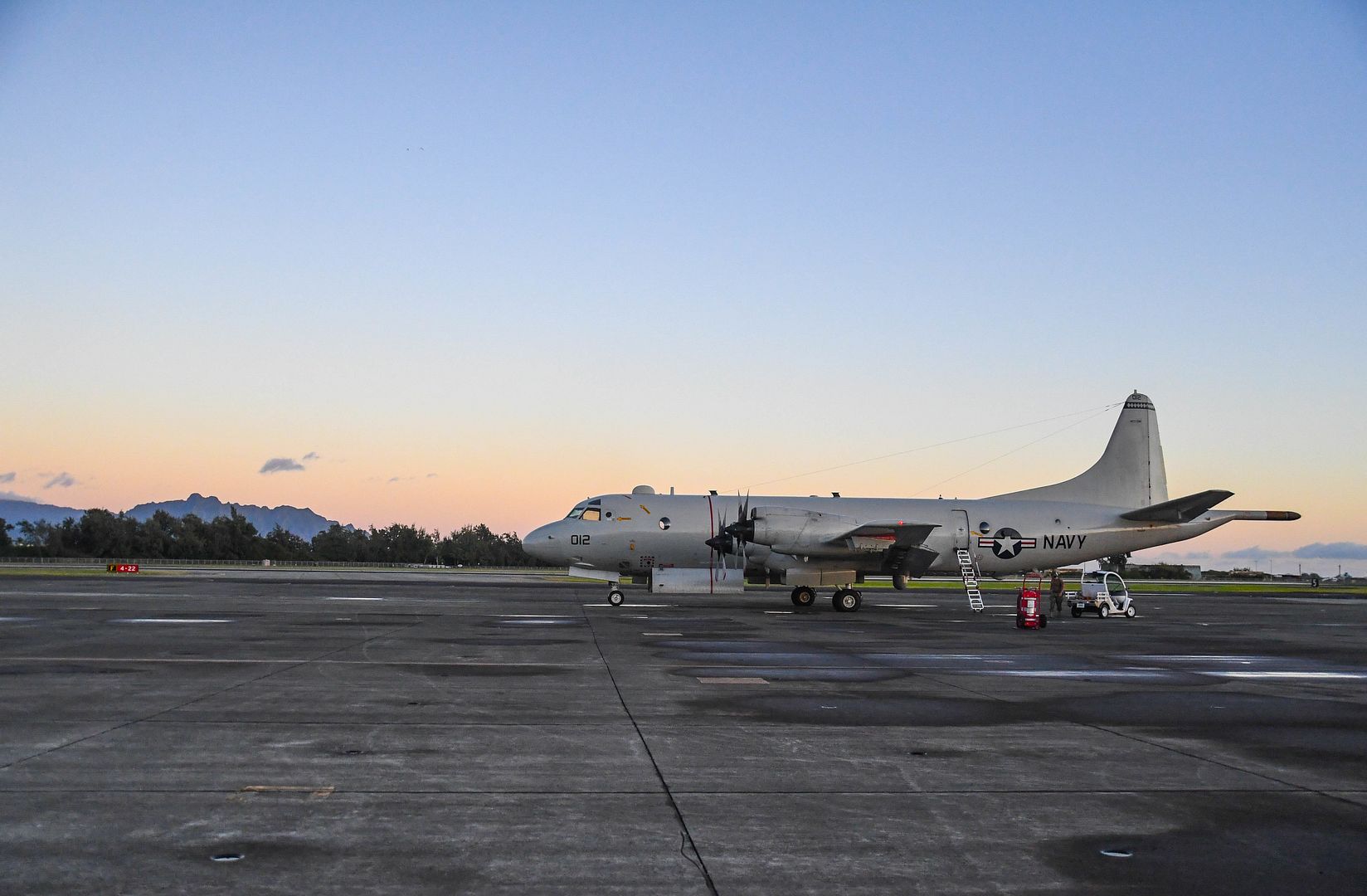
(Source: Royal Australian Air Force; issued March 03, 2017)
In an exhilarating day for Australian military air power, the F-35A Lightning II made its public debut at the Australian International Airshow.
After a journey of about 15,000km Australia?s first two F-35As displayed their power and manoeuvrability in the sky above Avalon Airport before landing in front of an enthused crowd.
Prime Minister Malcolm Turnbull, Defence Minister Senator Marise Payne, and Defence Industry Minister Christopher Pyne, met the F-35A pilots WGCDR Andrew Jackson and SQNLDR David Bell and their support crew before speaking to the media.
Mr Turnbull said it was an exciting day for Air Force, Australian industry, technology and Australian jobs.
?The F-35A is the most advanced fighter in the world,? he said. ?We need to ensure our Defence force have the best capabilities and the greatest lethality.?
The F-35A is a key addition to Australia?s strategic capability and a critical component of the $195 billion defence investment.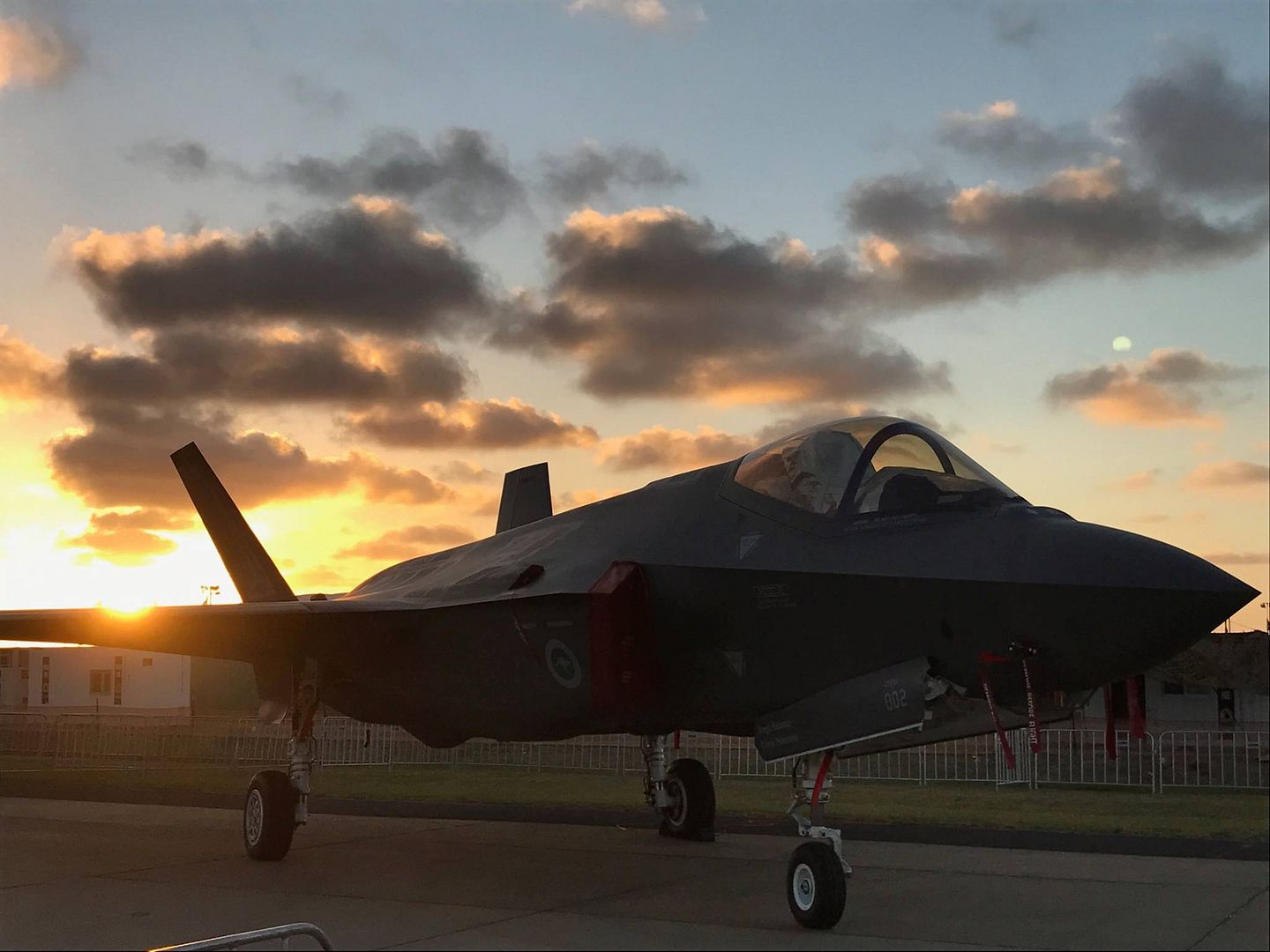
The government is purchasing and will maintain 72 aircraft as part of the global Joint Strike Fighter program which will give Air Force the capability to combat future air threats to the nation.
Senator Payne said there wasn?t anything like the landing of two F-35As in Australia to make a defence minister?s day.
?This acquisition has been 15 years in the making and will make a game-changing difference to Air Force capability,? she said.
?The F-35A will provide the Air Force with the ability to execute air combat missions which were previously beyond our scope.?
What a momentous occasion for our nation, thank you for sharing it with us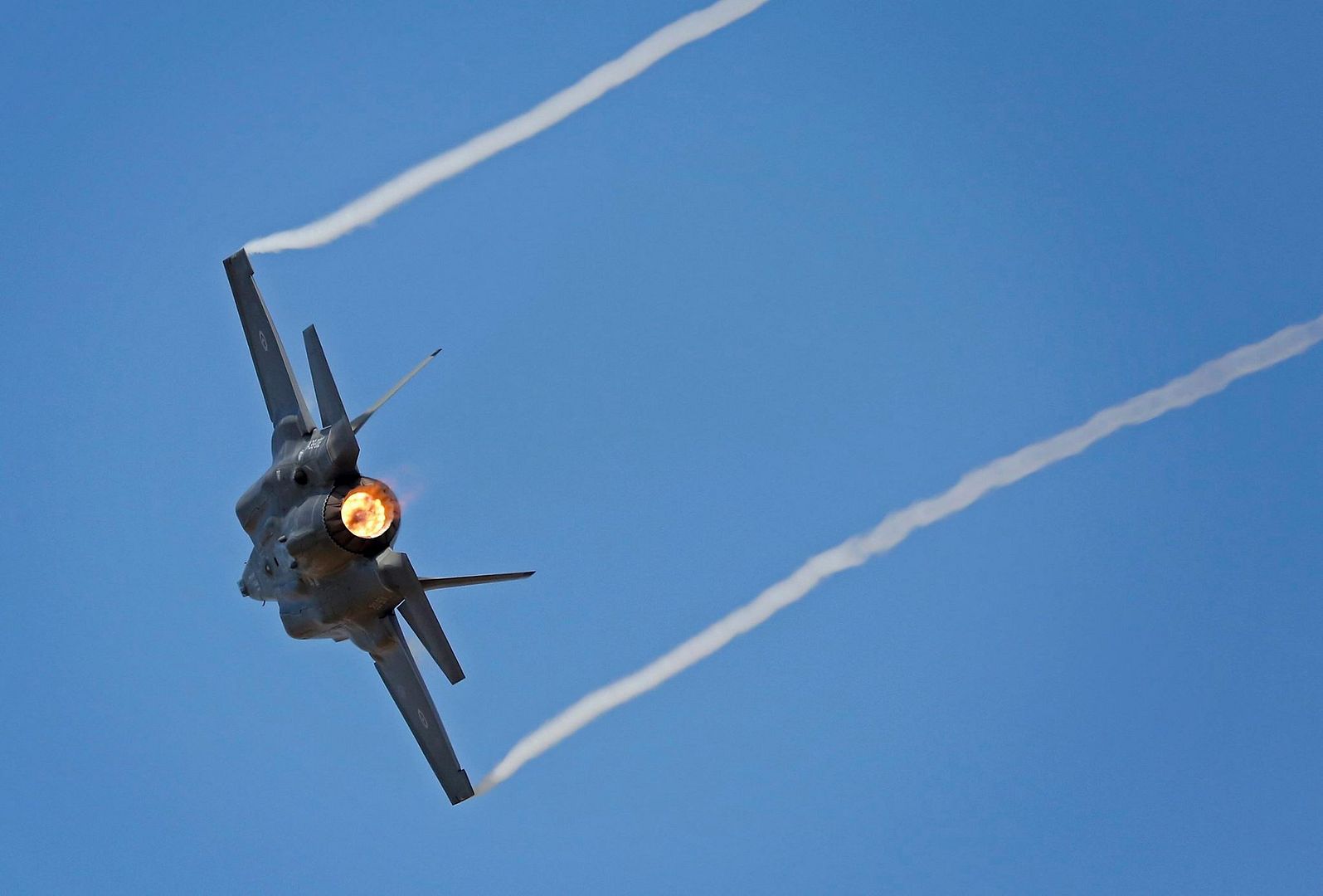
Post a reply
- Go to Next topic
- Go to Welcome
- Go to Introduce Yourself
- Go to General Discussion
- Go to Screenshots, Images and Videos
- Go to Off topic
- Go to Works in Progress
- Go to Skinning Tips / Tutorials
- Go to Skin Requests
- Go to IJAAF Library
- Go to Luftwaffe Library
- Go to RAF Library
- Go to USAAF / USN Library
- Go to Misc Library
- Go to The Ops Room
- Go to Made in Germany
- Go to Campaigns and Missions
- Go to Works in Progress
- Go to Juri's Air-Raid Shelter
- Go to Campaigns and Missions
- Go to Works in Progress
- Go to Skinpacks
- Go to External Projects Discussion
- Go to Books & Resources
